VOLUME
ISSUE 12
Playground
Playground – a vast, open free space set for socio-cultural, physical-embodied and artistic creative explorations. Often deeply associated with the developmental journey of humans as children, it has historically remained a boundless space of raw discovery, joy and social bonding. From spaces fecund with human potential, playgrounds have transformed, in much of the late twentieth century, into normative, adult spaces – determined and managed by adults as to what people (both as children and adults) should explore, how to consume and perform play. Attendant to this is how to determine the safety and surveil interaction with others.
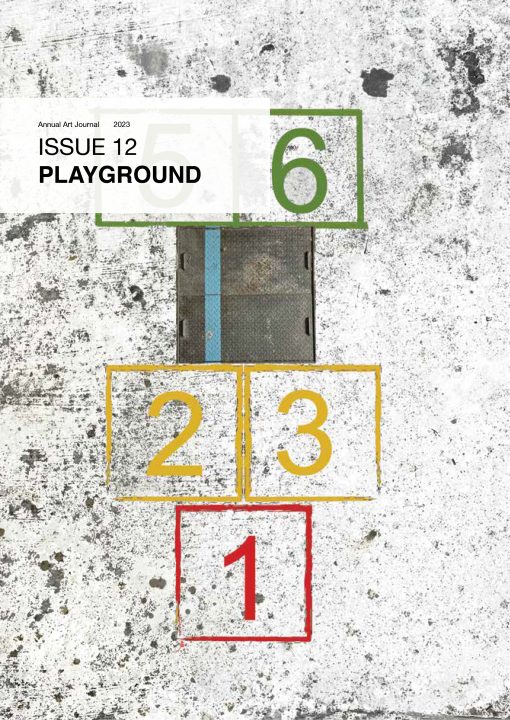
ISSUE 12
2023
Playground
ISSN : 23154802
Introduction
Exhibition
Essays
Conversation: Phnom Penh
Contributors’ Bios
Introduction
Introduction: Playground
Exhibition
Ideas for Planet(ary) Playgrounds
Conversation: Phnom Penh
Phnom Penh: Art, National Comfort in a Decolonising Southeast Asia
Contributors’ Bios
Contributors’ Bios
Introduction
Cover Image
Milenko Prvački, Hopscotch, 2023, pen and ink, coloured in photoshop.
Editor
Venka Purushothaman
Associate Editor
Susie Wong
Copy Editor
Weixin Quek Chong
Advisor
Milenko Prvački
Editorial Board
Professor Patrick Flores, University of the Philippines
Dr. Peter Hill, Victorian College of the Arts, University of Melbourne
Professor Janis Jeffries, Goldsmiths, University of London
Dr. Charles Merewether, Art Historian, Independent Researcher, Curator and Scholar
Manager
Sureni Salgadoe
Contributors
Samit Das
FX Harsono
Dr. Peter Hill
Mella Jaarsma
Magdalena Magiera
Dr. Charles Merewether
Sopheap Pich
Professor Claire Roberts
Khvay Samnang
The Editors and Editorial Board thank all reviewers for their thoughtful and helpful comments and feedback to the contributors.
Introduction
Introduction: Playground
The issue of 2023 is Playground.
The intent for choosing playground as a theme was originally to be playful and wispy since the last three volumes were sombre illustrations of the arts’ response to a global health crisis. However, playground as a concept cannot remain playful. It is complex. While seemingly innocuous, play and ground as autonomous descriptors evoke some predictable responses. On the one hand, it could target the evergreen youthfulness of one’s yesteryear. That is our childhood’s central journey at a playground as being deterministic of self-actualisation through play on a ground removed from the embodiment of structures called home or school. However, play conjoined with ground conjure a multi-layered interplay of influences taxed with participatory adult games of war, peace, power and competition.
This volume commissioned artists, writers and art historians to look at the playground concept and investigate its potency as a vast, open and accessible space for sociocultural, physically embodied and artistically creative explorations. The essays reflect on a playground’s normative and performative structures, especially in an increasingly surveilled terrain. The articles do not theorise or romanticise the playground but enlist its conceptual and social philosophies to speak to issues of concern to artists.
More than ever, playgrounds are weighed with contested freedoms of identities and ideologies in the determination of socio-cultural-political space. Whose space, what is contained within a space, who is entitled to be in this space and who controls the area are questions that remain in negotiation. In fact, this has been at the heart of the formation of the 20th century’s primary political offering: the postcolonial nation-state, an endless line of perforations between communities, identities, languages, oceans and ideas—and an increasingly digital sphere of generative AI. The essays, conversation, reflections and exhibition echo a deeply anxious moment in history as we strive for attention in an otherwise noisy set of circumstances.
Exhibition
Ideas for Planet(ary) Playgrounds
The right to the city “manifests itself as a superior form of rights: the right to freedom, to individualization in socialization, to habitat and to inhabit”— Lefebvre*
The concept of having the right to places of encounter and exchange, to their life rhythms and time uses, enables the full agency of these moments and places. Within the following pages, I want to explore the idea of Playgrounds shaping multiple aspects of human experience. Playgrounds are gaining even more importance as zones of physical interaction in an increasingly digital world.
The notion of “play” is present in Henri Lefebvre’s concept of the right to the city, as the latter “stipulates the right to meetings and gatherings (…) the need for social life and a centre, the need and the function of play, the symbolic functions of space”. Drawing on this idea, this issue profiles artistic practices and specific works which create accessibility through playful engagement with complex topics and contemporary conflicts. These encounters can influence social, cultural, political, and economic perceptions. Some explore our desires by breaking down the narration of stories within an urban context, like Never Again by Monica Bonvicini, or Rules for the Expression of Architectural Desires by Debbie Ding; others engage with political struggles, like immigration and the experience of minorities reflected in Mr. Cuddle by Trevor Yeung or Moth (that Flies by Day) by Ong Si Hui. The rights of citizens to participate in decision-making processes can be seen in Superkilen by SUPERFLEX or Spiel-Skulptur / Play Sculpture by Regina Maria Möller, as they reflect on shared contemporary experiences.
Each of the works call for new epistemological approaches that look at art as the ever-changing outcome of a production process in which social and physical realities interact with mental ones, enabling a direct conversation with the work as (or through) “play”. Each work engages in a dismantling of their original intention, and therefore their reception becomes unscripted and challenges visitors to rethink their meaning. In some of the works, audiences are invited to claim agency and choose their own interpretations of the work, and the world, through playful engagement and interaction. The works presented here are intended to become constructive ways of un-learning and play, creating a dialogue within civil society and contributing to shaping individuals within a larger community. Changes in the perception of everyday life are what provides the impetus for major changes in society.
Monica Bonvicini
Monica Bonvicini (b. 1965, Italy) emerged as a visual artist and started exhibiting internationally in the mid-1990s. Her multifaceted practice investigates the relationship between architecture, power structures, gender and space. Her research is translated into works that question the meaning of making art, the ambiguity of language, and the limits and possibilities connected to the ideal of freedom. Dry-humoured, direct, and imbued with historical, political and social references, Bonvicini’s art never refrains from establishing a critical connection with the sites where it is exhibited, its materials, and the roles of spectator and creator. Since her first solo exhibition at the California Institute of the Arts in 1991, her approach has formally evolved over the years without betraying its analytical force and inclination to challenge the viewer’s perspective while taking hefty sideswipes at patriarchal, socio-cultural conventions.
Never Again
Monica Bonvicini began creating large-scale architectural installations in the 1990s exploring the built environment and how articulations of power and (sexual) identity define our construction of space. Never Again consists of a collection of swings composed from steel pipes, black leather and chains, suspended from a steel structure. The viewer navigates and physically engages with these subversive structures, all the while altering the politics of traditional exhibition viewing. Incorporating research on psychoanalysis, sexuality, labour, feminism, and architecture, the work of Bonvicini addresses how urban, private, and institutional spaces dictate our behaviour. As a societal and structural critique, Never Again comments on how minimalist art sanitised itself from the body.

Monica Bonvicini, Never Again, 2005.
Galvanised steel pipes, black leather, black leather men’s belts, galvanised chains, clamps. 350 x 1600 x 1100 cm.
Installation view at Hamburger Bahnhof, Berlin, 2005. Photo: Jens Ziehe. Courtesy the artist and VG-Bildkunst, Bonn.
Chang Wen-Hsuan
Chang Wen-hsuan (b. 1991, Taiwan) questions the narrative structure of institutionalised history with re-readings, re-writings, and suggestions of fictional alternatives in order to expose the power tensions embedded in historical narratives. Through versatile platforms including installations, videos, and lectures, Chang often navigates skewed documentations and first-person accounts to trigger reflections on how the understanding of history affects the purport of the present and thrust of the future. In 2018, she launched the project Writing FACTory. she is the recipient of several awards and prizes and has presented internationally.
Lecture Performance Syllabus
Lecture Performance Syllabus is a trilogy consisting of When Did the Merlion Become Extinct?—The Narrative to Succeed in the 21st Century (2019-2021); The Equipment Show (2021-2022); and The Ventriloquist (2021), which aims at exemplifying the interrelation between narration, performance, and the execution of power. In When Did the Merlion Become Extinct? —The Narrative to Succeed in the 21st Century, the artist delivers a lecture in a way reminiscent of a successology lecturer Victoria Chang, who defines the successology needed in the 21st century as the “National Narrative to Succeed” by breaking down the narratology into simple stories, affective stories, infectious stories, and democratic stories. While the first part of the trilogy examines the verbal language of authoritarian regimes, the second scrutinises the non-verbal communication of the strongman politics. The Equipment Show collects video clips including excerpts of historical figures, politicians, movie characters, and motivational speakers from YouTube, with the stage performer invited to deconstruct those gestures and also make a tutorial video, and “Victoria Chang” analysing the structural relationships between texts and the images. The last one, The Ventriloquist, deconstructs the narratology and performativity of the strongman by unveiling the technique of suture with the disclosure of dubbing. Combining video, installation, documents, and lecture performance, the trilogy probes into the governmentality of strongman, the designation of audienceship, and the unaccomplishment of democracy.

Chang Wen-Hsuan, When Did the Merlion Become Extinct?—The Narrative to Succeed in the 21st Century. 2019-2020.
Photo: Bat Planet Photography. Courtesy Taiwan Contemporary Culture Lab (C-LAB).
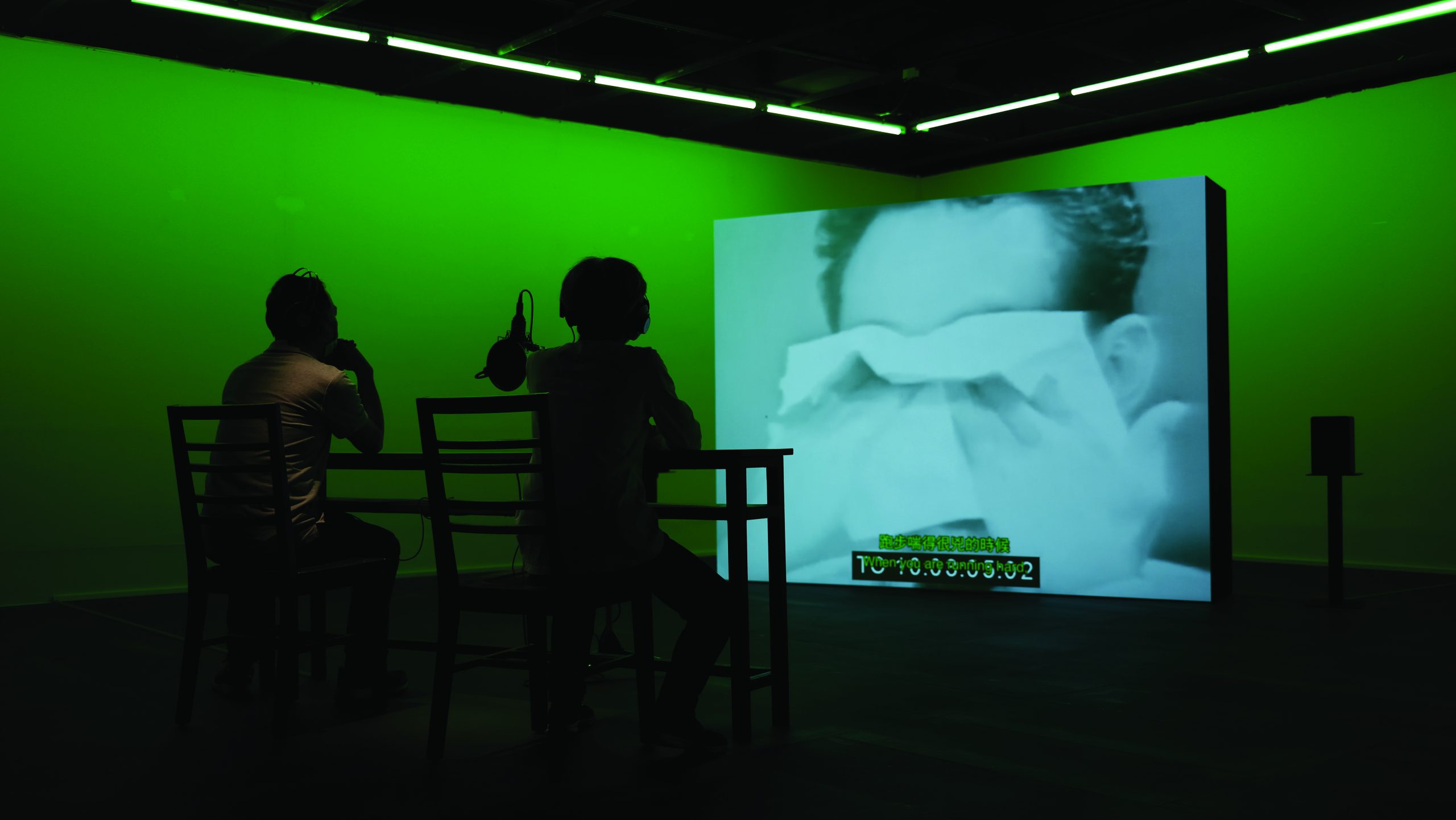
Chang Wen-Hsuan, The Ventriloquist. 2021.
Installation view, Lecture Performance Syllabus: Chang Wen-Hsuan solo Exhibition, Kuandu Museum of Fine Arts. 2021.
Courtesy the artist.

Chang Wen-Hsuan, The Equipment Show. 2022.
Installation view, Making Worlds: An Imagineering Project, Museum of Contemporary Art Taipei, 2022.
Photo: ANPIS FOTO, Anipis Wang. Courtesy The Museum of Contemporary Art, Taipei.
Kray Chen
Kray Chen (b. 1987, Singapore) is a visual artist dealing with film, performance and installations. Kray is fascinated with social rituals where he often finds the peculiar or absurd to look at the gaps between what we imagine and what we find in real-life. He has presented internationally and is the recipient of the 2017 National Arts Council’s Young Artist Award.
Waiting for the Bird #1 and #2
In the Waiting for the Bird series, the sculptures condense the dimensions of Mahjong, figuratively and metaphorically, into a tight-fitting diorama that are inspired by the dramatic depictions of legendary Mahjong gameplays in Hong Kong films. Chen recreates the scenarios where each player, although gifted with legendary winning hands, are stuck in an impasse where everyone waits for the last Bird tile.

Kray Chen, Waiting for the Bird #1 (lightwood), 2018 and Waiting for the Bird #2 (darkwood), 2019.
Collected Mahjong tiles, wood, fabric. Installation view IN RANDOM, 23 January – 3 March 2019, Fost Gallery, Singapore.
Courtesy the artist and Fost Gallery.
Heman Chong
Heman Chong (b. 1977, Malaysia, raised in Singapore) is an artist whose work is located at the intersection between image, performance, situations and writing. His practice can be read as an imagining, interrogation and sometimes intervention into infrastructure as an everyday medium of politics. His work has been the subject of solo exhibitions at many international Institutions. Chong is the co-director and founder (with Renée Staal) of The Library of Unread Books, a library made up of donated books previously unread by their owners.
God Bless Diana
A series of images collected in a rigorous manner over five years and totalling around 6,000, which have been edited down to a set of 550. Displayed as a postcard shop, the work reflects on the process of collecting. Of interest to Chong is the process of accumulation that very immediately slips into the dissemination of an archive, and how this archive becomes open to its availability. The idea that people curate their own viewing experiences, rather than having somebody else define these, is an important aspect to the artist. When buying the postcards, people need to go through the selection process and create their own ways of seeing. This archive is an early work by Heman Chong when he was at the very beginning of his artistic practice. It encapsulates themes that later resurface in his works, like collectivity, monumentalisation, objects, displaced systems, performativity, time, art history, and death.
This project was initially commissioned for the Kröller-Müller Museum in the Netherlands.
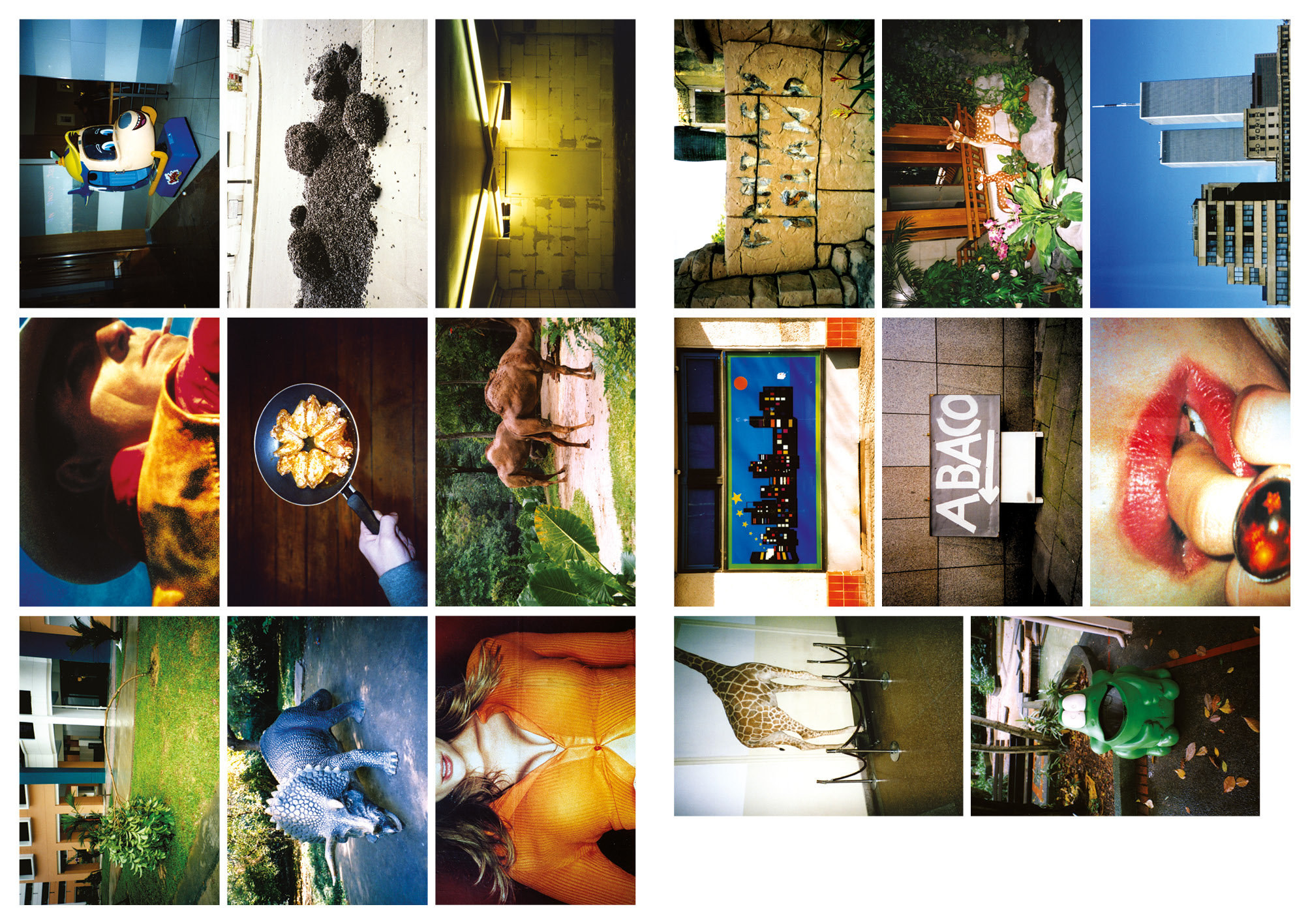
Heman Chong, God Bless Diana, 2000-2004.
17 / 550 postcards. Dimensions variable. Courtesy the artist and Amanda Wilkinson Gallery.
Debbie Ding
Debbie Ding (b.1984, Singapore) is a visual artist and technologist whose interests range from historical research and urban geography to visions of the future. She reworks and re-appropriates formal, qualitative approaches to collecting, labelling, organising, and interpreting assemblages of information – using this to open up possibilities for alternative constructions of knowledge. Using interactive computer simulations, rapid prototyping, and other visual technologies, she creates works about subjects such as map traps, lost islands (Pulau Saigon), World War II histories, soil, bomb shelters, and public housing void decks.
Rules for the Expression of Architectural Desires
The design of our built environment begins with ideas, often articulated in a manner that may be conceptual, abstract, or even imprecise. Even though the city is built with concrete and glass, when we explore its textures we find that its core is made up of ideas, desires and emotions. In order for us to imagine new cities and solutions, we need to re-write the rules.
Rules for the Expression of Architectural Desires is made up of 24 speculative schemes, devices and instruments for the urban and social re-design of a city. Each of these rules is written with the intention of promoting the expression of architectural desires, although it is unclear whether they will change the city for better or worse. You decide.
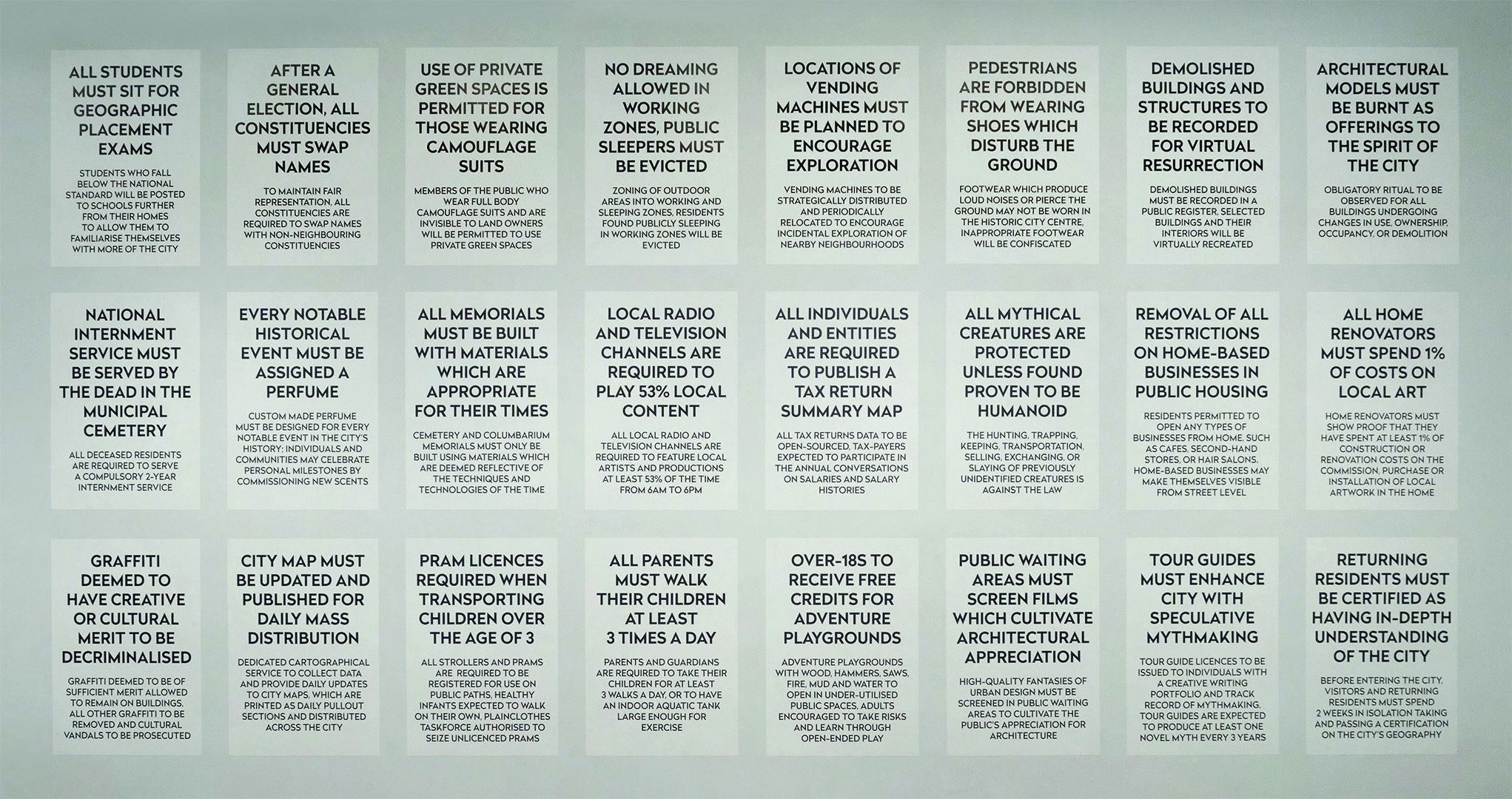
Debbie Ding, Rules for the Expression of Architectural Desires, 2014-2021.
24 UV printed posters on newsprint paper. Installation view Wikicliki: Collecting Habits on an Earth Filled with Smartphones,
22 April–11 July 2021, Singapore Art Museum. Photo: the artist.
Anne Duk Hee Jordan
Anne Duk Hee Jordan (b. 1978, Korea) Korean-German artist, whose background shaped her interests in art, science, and philosophy. Her work often speaks of issues of migration, identity, and social spaces, using natural or biological processes as metaphors. Her installations are meticulously researched and she often uses humour to get her point across. She uses both living and dead materials, at times constructing machines that can mirror organisms to create a dialogue between art and science, her identity, and social systems.
Making Kin
How do we want to live in the future? In a combination of various media such as living plants, installation, drawings, and robotics, Anne Duk Hee Jordan, explores concepts of interspecies community and real and fictional landscapes. “Making Kin” is a maxim coined by the philosopher of science and pioneer cyborg feminist Donna Haraway who calls for an interspecies symbiosis. To ensure a liveable future for the following generations, we, as mortal “critters”, need to link up with multiple configurations of places, times, matters and meanings so that new life can be “composted” from the planet-destroying Homo sapiens. Jordan scrutinises established terms like nature, culture, and technology, including their definitional boundaries. The artist is interested in the hybrid network between species and their environment. In a humorous and playful manner, she draws up an experimental and future-oriented scenario that challenges our customary perspectives on life and, likewise, makes a new model of community both imaginable and apprehensible. The work Water Crab (2017– ongoing) is conceived to function as a marine robotic. As her Artificial Stupidity series is about allowing failure and reclaiming the domain of robotics in terms of non-intelligence, this Water Crab is not able to clean up all the human waste in the oceans, but is rather a prototype of this idea and advocation that design or art is not only there to make the world a better place. Does a non-functional artificial bot also have the right to float in our waters?
This work was conceived for the exhibition “Making Kin” at the Kunsthaus Hamburg, Germany, curated by Anna Nowak.
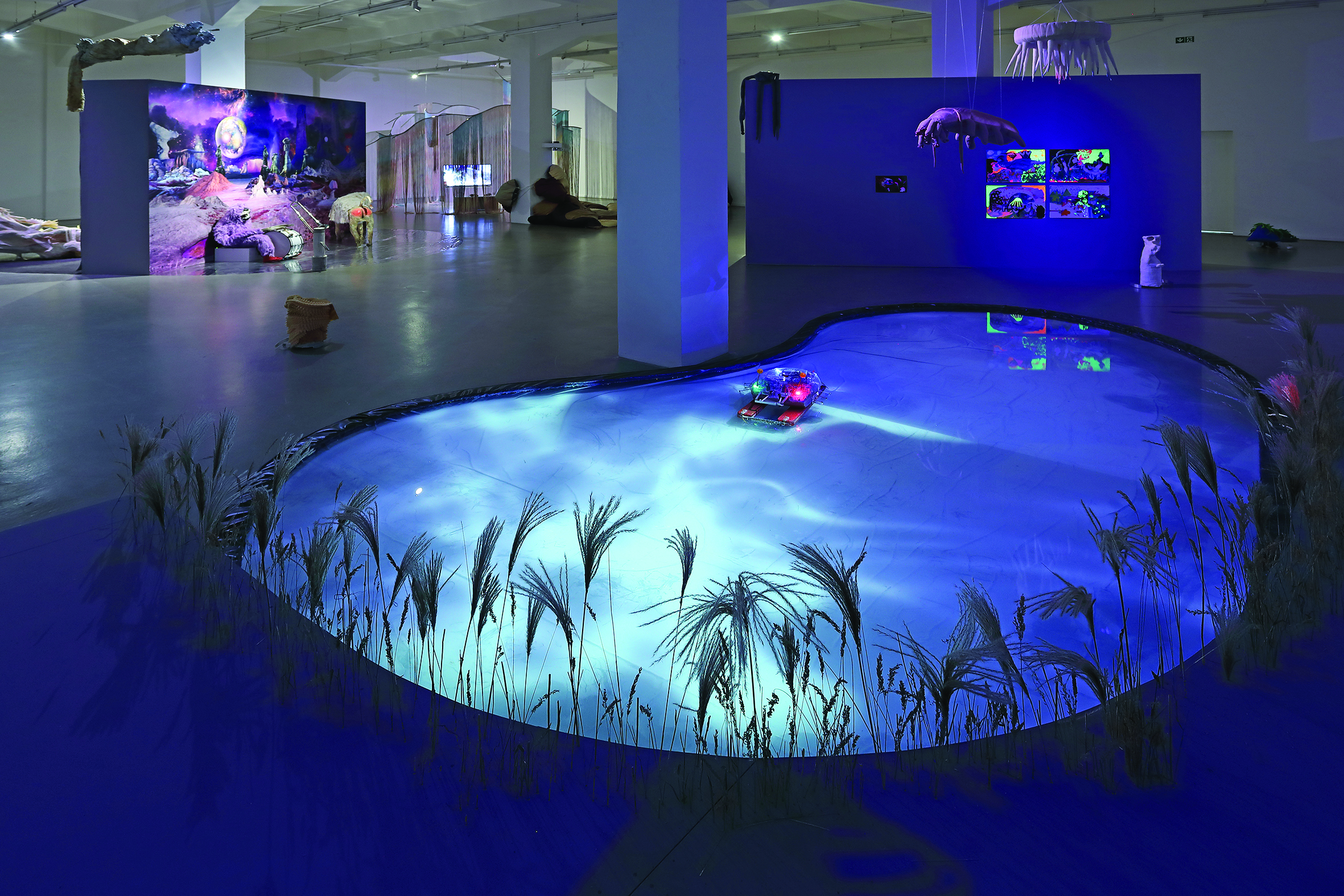
Anne Duk Hee Jordan, Making Kin, 2020
Site-specific artificial pond with artificial crab and 2 channel video, along with critters, sea animal sculptures and
drawing. Installation view Making Kin. 3 July – 6 September 2020, Kunsthaus Hamburg. Courtesy the artist.
Valentina Karga
Valentina Karga (b. 1986, Greece) is currently working on challenging the notion of ‘self’ by proposing non-anthropocentric future narratives. A large part of her projects encourage engagement and participation, facilitate practices of commoning and are concerned with sustainability. She works across different media, often inviting a public or a community to literally complete the work. Sometimes, through dialogue and building prototypes in a DIY manner, they end up imagining alternatives for infrastructures and institutions that structure our reality. This is what she calls ‘Art as Simulation’. She is a founding member of Collective Disaster, an interdisciplinary group that works in the interstices of architecture and the social realm.
Well Beings
In the exhibition Well Beings at the MK&G (Museum für Kunst und Gewerbe Hamburg), artist, architect and designer Valentina Karga deals with the fears triggered by ecological crises. Based on her own experience with such anxieties, she has developed an interactive parkour that invites visitors to try out for themselves various exhibits inspired by popular self-care objects. These include hug-pillows and weighted blankets as well as oversized plush toys that are blown-up versions of small figurines from the museum’s Antiquities Collection.
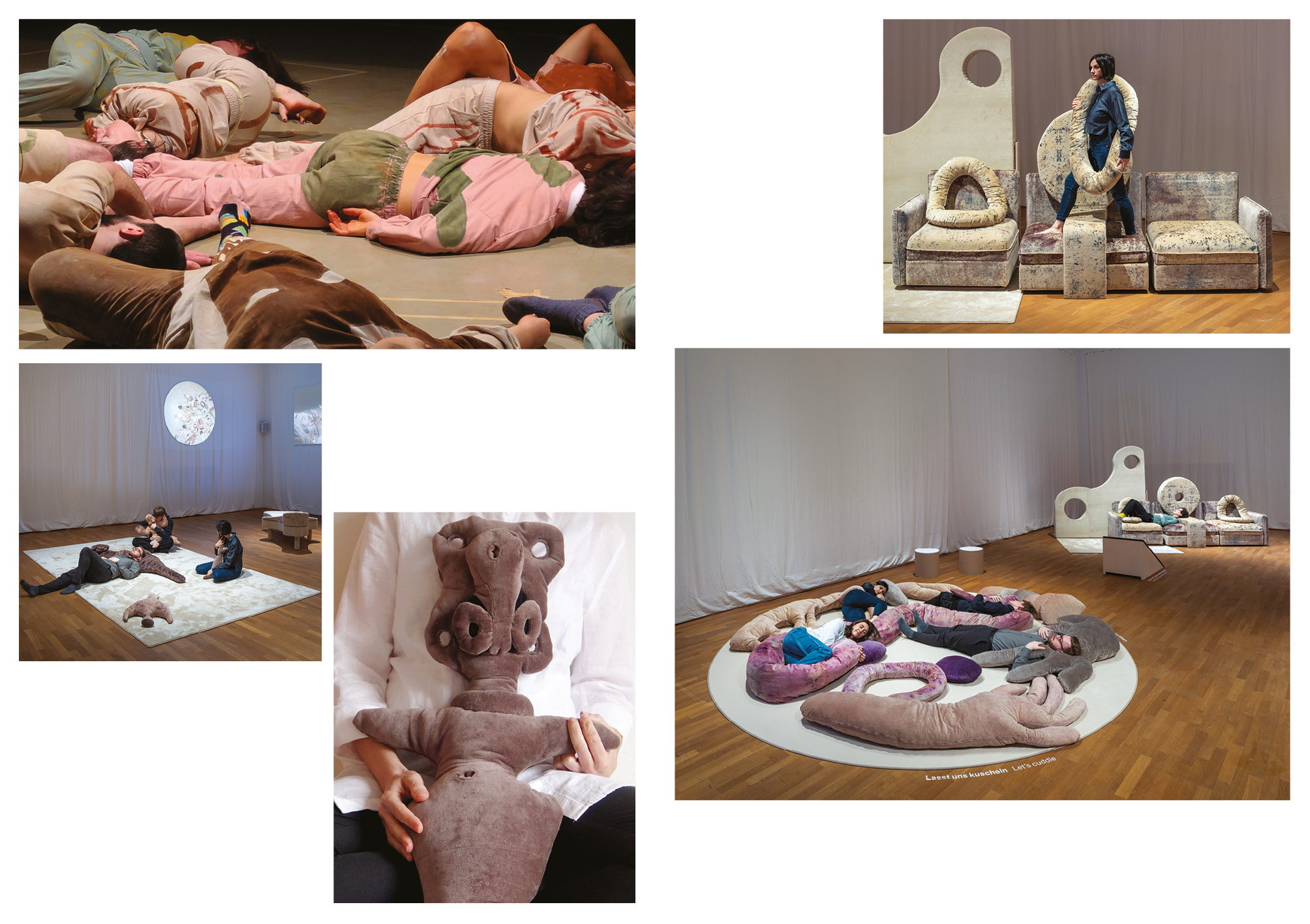
Valentina Karga, Well Beings, 2023.
Upholstery, natural and recycled materials, natural dyes, HD video, sound. Installation view, Valentina Karga: Well Beings, 24
March–3 September 2023, Museum für Kunst und Gewerbe, Hamburg. Courtesy the artist.
Lai Yu Tong
Lai Yu Tong (b. 1996, Singapore) is a visual artist whose works span across image-making, painting, drawing and installation. He makes works about the things he sees, things he eats, things he buys, things he throws away, and more, examining habits of consumption in the modern world.
Rearrange The World
Rearrange The World is a series of 30 paper-cut collages that depicts a game being played between two hands, one of which bears a bandage around its thumb. Three objects—a cup, a can, and a bottle—are moved about on a table, tumbling, balancing, rolling and overturning around one another, forming new configurations at each turn. The words ascribed to the objects are a combination from common vocabulary taught to children and words that the artist hopes to teach to children. The work reflects on the possibility of changing the world by rearranging it.
A version of this work will be produced into a children’s book, published by Thumb Books, a small press founded by the artist in 2022 that makes children’s books for both children and adults.

Lai Yu Tong, Rearrange the World, 2023.
15 / 30 paper-cut collages.
Graphite, copier-paper, recycled paper. Courtesy the artist.
Regina Maria Möller
Regina Maria Möller (b.1962, Germany) is the founder of the magazine regina and creator of the label embodiment. Her artistic practice is conceptual and involves a wide range of media formats; interweaving complex stories, which deal with, for example, the question of identities, the physical body’s presence in digital times, and the environment at large. When the Corona pandemic broke out in March 2020 Möller worked together with historians from science, technology, medicine and the environment on the research project The Mask – Arrayed, hosted by the Max Planck Institute for the History of Science (MPIWG). The projects and works of Regina Maria Möller have been exhibited nationally and internationally.
Spiel-Skulptur / Play Sculpture
Since her early career, Möller’s interest lays in producing artworks that could be used or worn to challenge the social capacities of the aloof. With Play Sculpture, an ‘Art in Public Space’ for a kindergarden in Großmugl, Germany, she created a sculpture that doubles as a playground. The climbing structure is based on children’s drawings, and the rectangular box on top of the climbing frame represents a moving cardboard box. Children can access the box from entrances on two sides, one round and the other square. Both openings are framed by a graphic drawing of an open box, creating a ‘trompe-l’oeil’ effect from a distance. The interior of the box is covered with green chalkboard paint so that children can constantly redesign their four walls without being observed by their parents or kindergarten teachers. On the closed sides of the moving box, the words ‘children’s room’ or ‘living room’ can be read in six different languages, referring to Austria’s neighbouring countries and vast international communities.
Großmugl’s Cat
Years later at the same kindergarden in Großmugl, Möller developed a second public art project doubling as playground: Großmugl’s Cat. The name of the town is derived from a large Bronze Age burial mound nearby. Möller invokes this historical site by creating a small hill alongside a large cat sculpture. An opening in the mound serves as a tunnel through which children can escape the lurking cat, which also functions as a climbing wall. The work embodies an ethic of work and play, consistent with the motto of Charles and Ray Eames, “We must take the game seriously.”

Regina Maria Möller, Großmugl’s Cat, 2011.
Installation view Kindergarten Großmugl, Photo: Regina Maria Möller. Courtesy the artist and Niederösterreichische
Landesausstellung, Abt Kunst und Kultur / Kunst im öffentlichen Raum / Marktgemeinde Großmugl.

Drawing by Thomas Möller, Großmugl’s Cat and Play Sculpture, 2011.
Courtesy the artist and VG Bild-Kunst Bonn.

Regina Maria Möller, Spiel-Skulptur / Play Sculpture, 2001,
Installation view Kindergarten Großmugl. Photo: Werner Kaligofsky. Courtesy the
artist and Niederösterreichische Landesausstellung, Abt Kunst und Kultur / Kunst
im öffentlichen Raum / Marktgemeinde Großmugl

Regina Maria Möller, mousehole / Großmugl’s Cat, 2011.
Detail. Courtesy the artist and VG Bild-Kunst Bonn.
Ong Si Hui
Ong Si Hui (b. 1993, Singapore) is a visual artist based in Singapore. She is a trained sculptor from the Nanyang Academy of Fine Arts and LASALLE College of the Arts, Singapore. Working extensively in stone, she explores the spirit of the medium through slow and meticulous hand carving processes. She addresses materiality, human conditions, fragility, anxiety, and reflects upon the behaviour of a work story. Her geometric forms and text-oriented works are often manifestations of her stream of consciousness.
Moth (that flies by day)
In late 2017, the area where the artist lived was overpopulated with moths; Ong became intrigued by both their boundless energy and complete stillness, that at times happened all at once. The daily scene also reminded the artist of Virginia Woolf’s essay The Death of the Moth, where she described with great dignity a moth’s death.
Thinking about the death of moths, and how their bodies are sometimes fastened down as specimens, stripped of life, Ong wanted to embody their spirit in stone, a medium that instead bears the history of time. This series began as an exploration of energy that lies within dormant forms.
Each form takes after different phases of the moth’s life and is illustrated in its physical qualities. Motions suspended in delicate fashion, with tilted axis, wander forward and backward through a meandering path. Each piece from the series represents the motions or spirit of the moth in different ways, and altogether, it reflects upon the complexity of the short life of a moth.
Through the narrative of the moth, a series of 7 pieces1, relate to the artist’s personal anxiety. Ong experiments with the delicacy of the forms, the brittleness of the marble, and their vulnerability to external movements, all the while containing tremendous amounts of nervous energy within.
1 artwork information of individual pieces: https://www.ongsihui.com/moththatfliesbyday
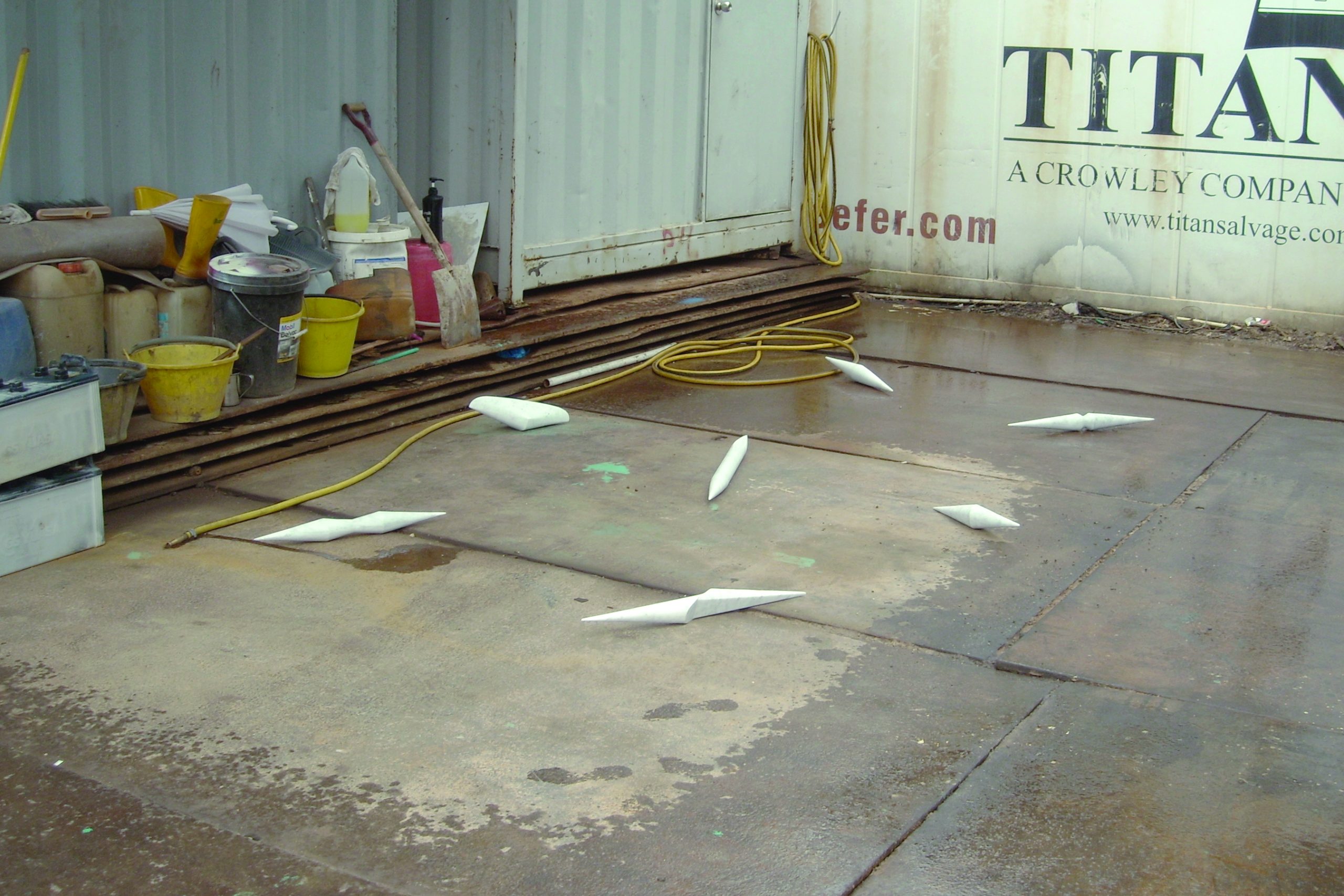
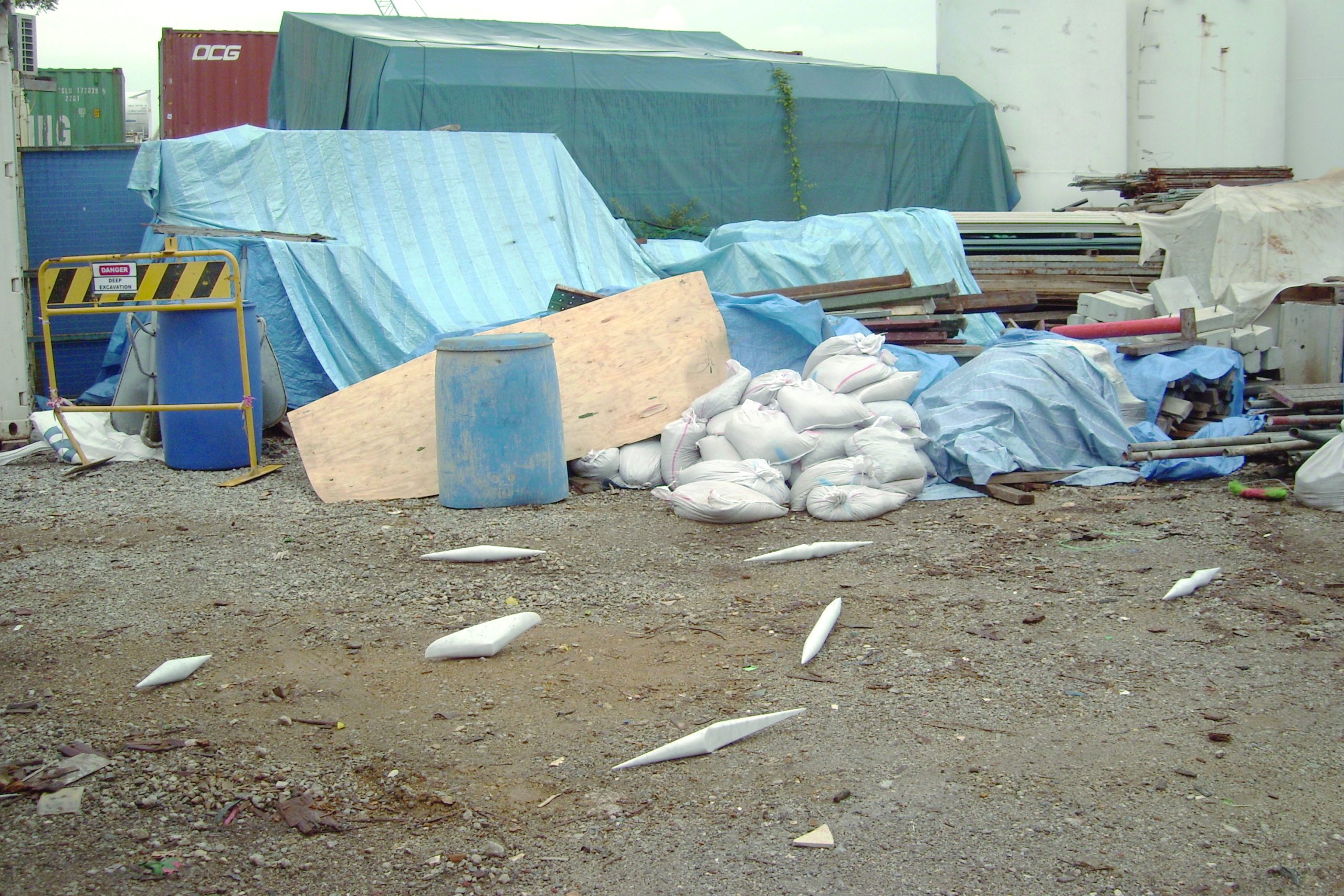

Ong Si Hui, Moth (that flies by day), 2018.
Marble, series of 7. Dimensions variable. Courtesy the artist.
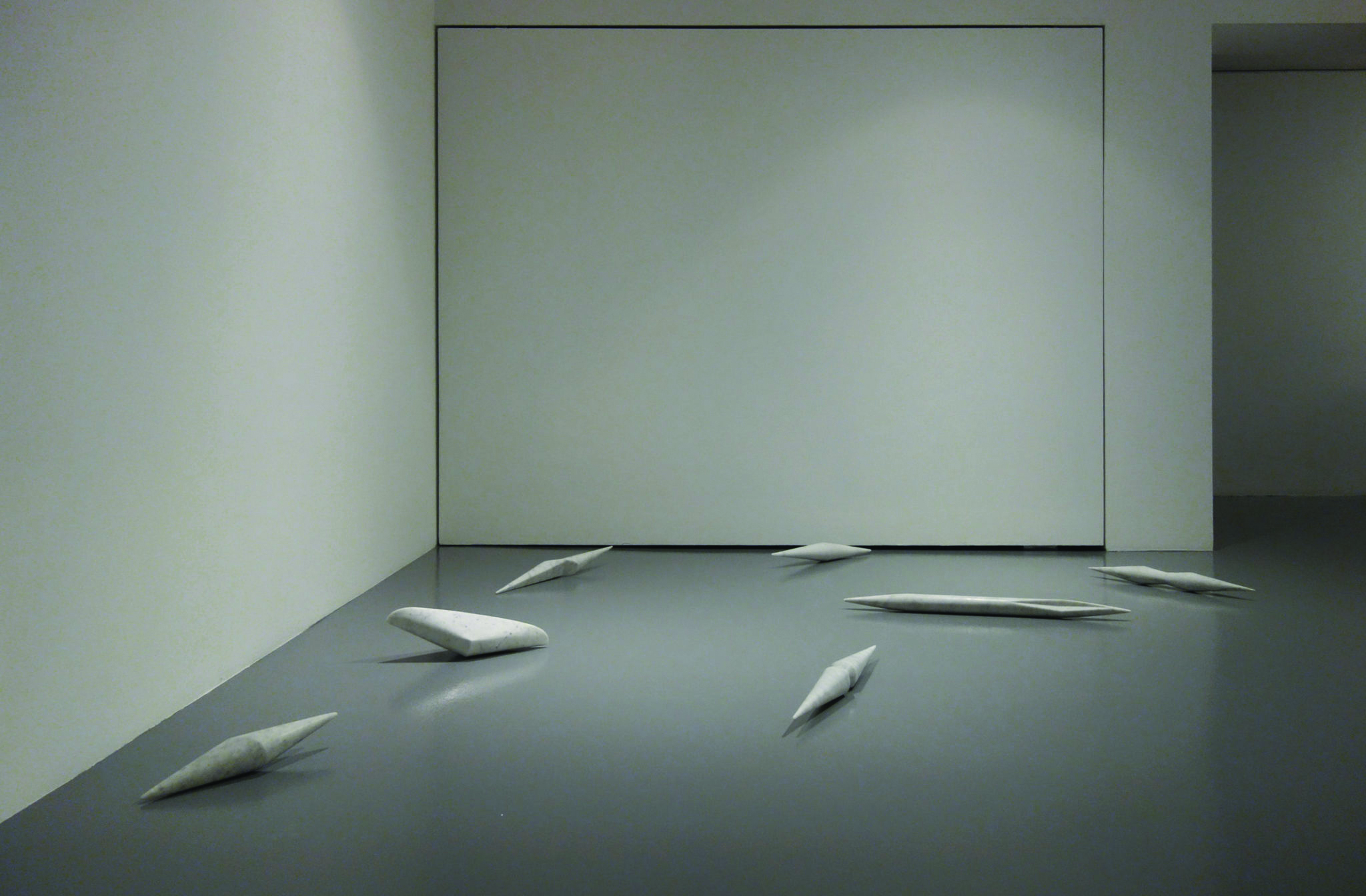
Ong Si Hui, Moth (that flies by day). 2018.
Marble. Dimensions variable. Installation view, The Lie of the Land, 07 August–17 October 2021, Fost Gallery.
Courtesy the artist and FOST Gallery.
Marjetica Potrč
Marjetica Potrč (b.1953, Slovenia) is an artist and architect based in Ljubljana. From 2011 to 2018, she was a professor of social practice at the University of Fine Arts/HFBK in Hamburg, where she taught Design for the Living World, a class on participatory practices. She has also been a visiting professor at a number of other institutions, including the Massachusetts Institute of Technology (2005) and the IUAV Faculty of Arts and Design in Venice (2008, 2010). Potrč has received numerous awards, grants, fellowships, and residencies. Her work has been exhibited extensively throughout Europe and the Americas.
Notes on Participatory Design, no. 7, 2014
Art depends on culture and is a tool to change culture itself. When art is a relational object, it mediates our relationship to the world and the artist becomes a mediator.

Marjetica Potrč, Notes on Participatory Design, no. 7, 2014.
Ink on paper. 21 x 29.7 cm. Courtesy the artist and Galerie Nordenhake, Berlin/Stockholm/Mexico City.
SUPERFLEX
SUPERFLEX was founded in 1993 by Jakob Fenger, Bjørnstjerne Christiansen, and Rasmus Rosengren Nielsen. Conceived as an expanded collective, SUPERFLEX has consistently worked with a wide variety of collaborators, from gardeners to engineers to audience members. Engaging with alternative models for the creation of social and economic organisation, works have taken the form of energy systems, beverages, sculptures, copies, hypnosis sessions, infrastructure, paintings, plant nurseries, contracts, and public spaces. Working in and outside the physical location of the exhibition space, SUPERFLEX has been engaged in major public space projects since their award-winning project Superkilen opened in 2011. These projects often involve participation and the input of local communities, specialists, and children. Taking the idea of collaboration even further, recent works have involved soliciting the participation of other species. SUPERFLEX has been developing a new kind of urbanism that includes the perspectives of plants and animals, aiming to move society towards interspecies living. For SUPERFLEX, the best idea might come from a fish.
Superkilen
Interview with SUPERFLEX about the work:
Uploaded on https://youtu.be/rlCo4Mg3Rdk

Superkilen is a public space in Copenhagen divided into three main areas: The Red Square, The Black Square and The Green Park. The Red Square represents modern urban life with a café, music and sports, while The Black Square is a classic square with fountains and benches and The Green Park is a park for picnics, sports and walking dogs.
The people living in the immediate vicinity of the park represent more than 50 different nationalities. Instead of including the city objects usually designated for parks and public spaces, SUPERFLEX asked people from the area to nominate objects such as benches, bins, trees, playgrounds, manhole covers and signage from other countries. These objects were chosen either from the country of the relevant inhabitant’s national origin, or from somewhere else encountered through traveling. The objects were either produced in a one to one scale copy or bought and transported to the site.
Furthermore, as part of a process that SUPERFLEX calls ‘extreme participation’, five groups travelled with SUPERFLEX to Palestine, Spain, Thailand, Texas and Jamaica in order to acquire five objects of their choice. These have since been installed in the park. In total, the park now contains more than 100 different objects from more than 50 different countries.
Superkilen was designed in collaboration with BIG and Topotek1. Commissioned by the City of Copenhagen and Realdania, Denmark.
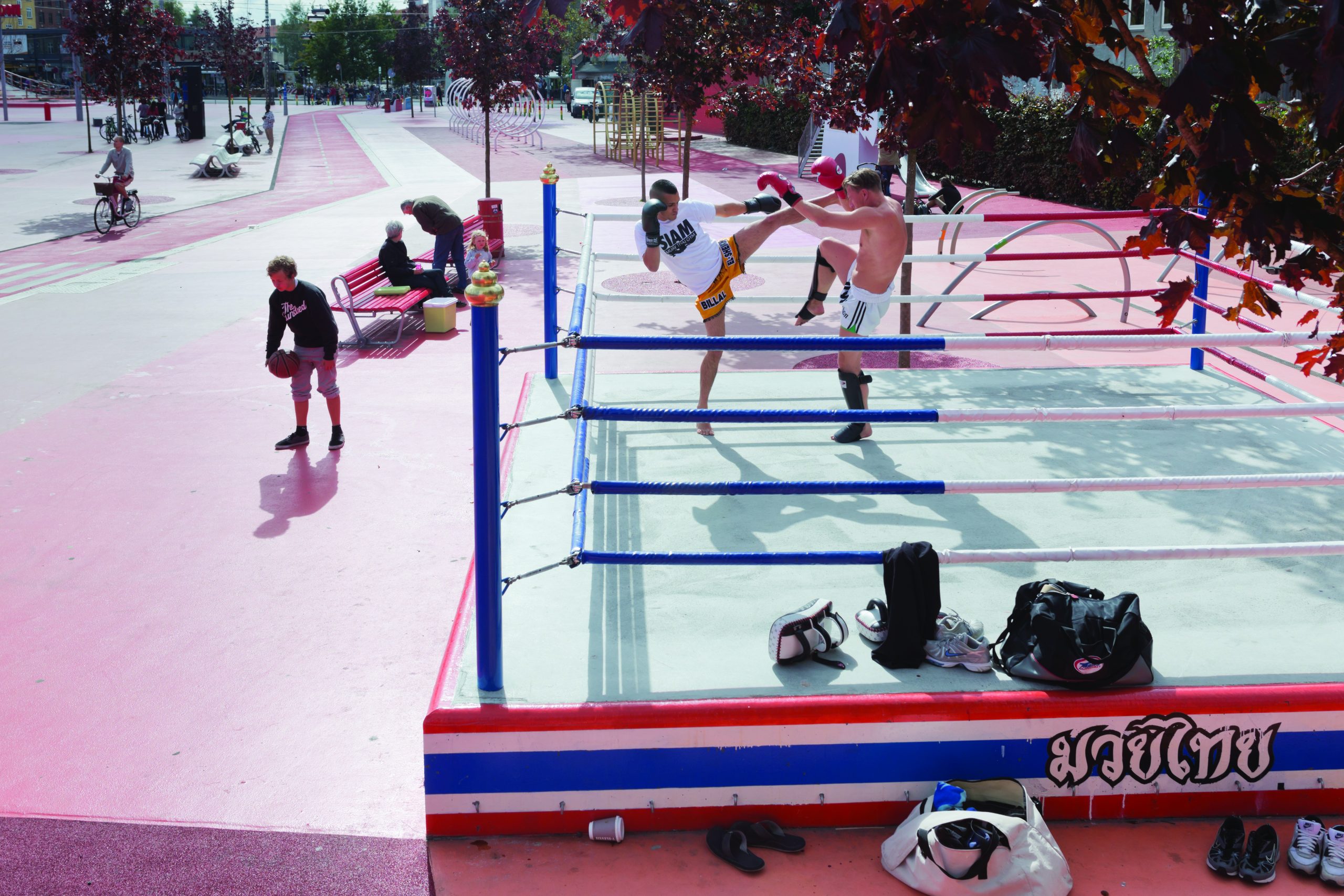
Superkilen, 2012. Red Square. Photo: Iwan Baan.

Superkilen, 2012. Red Square.
Photo: Torben Eskerod.

Superkilen, 2012. Red Square.
Photo: Torben Eskerod.

Superkilen, 2012. Red Square, Thai boxing.
Photo: Iwan Baan.
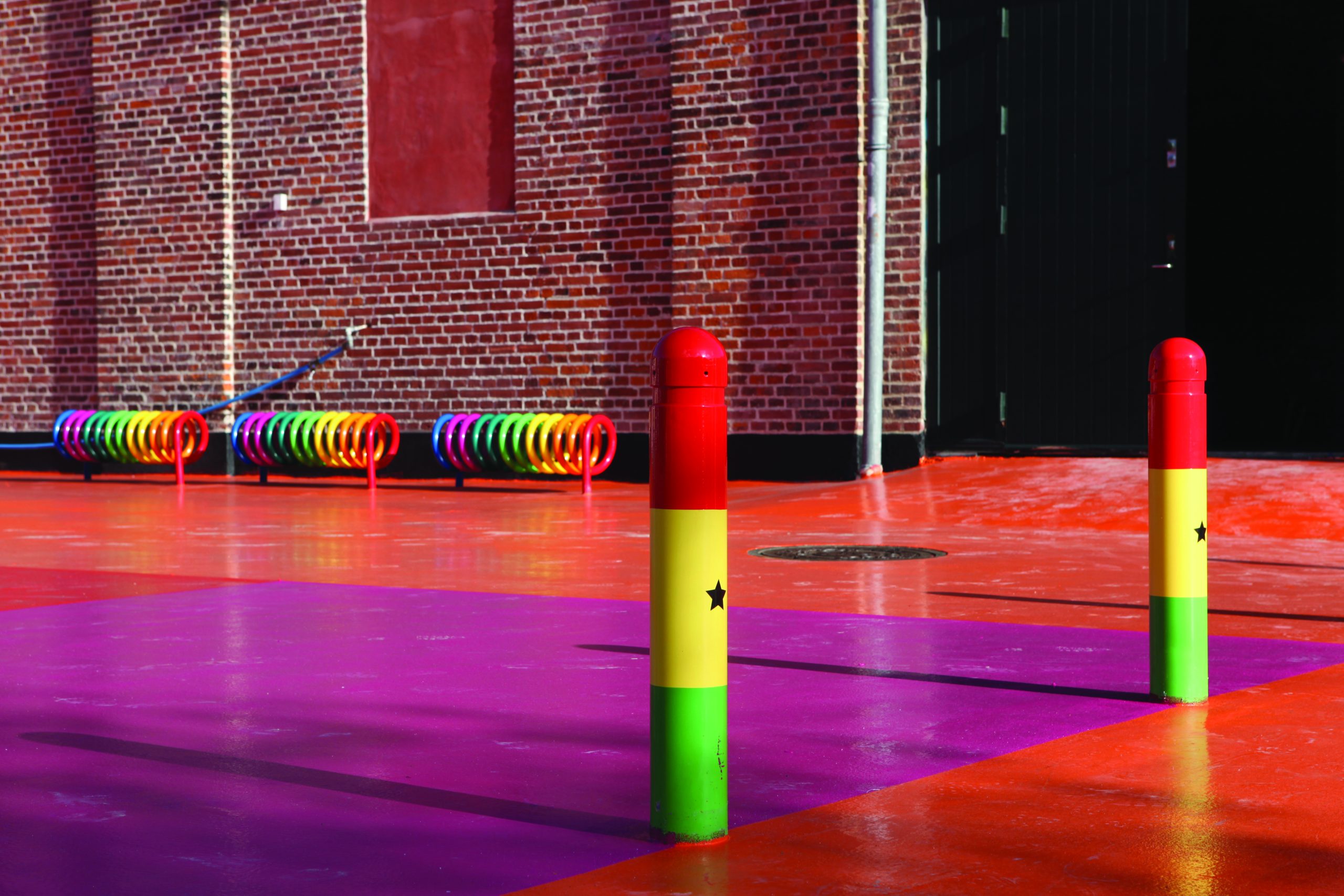
Superkilen, 2012. Red Square.
Photo: SUPERFLEX.
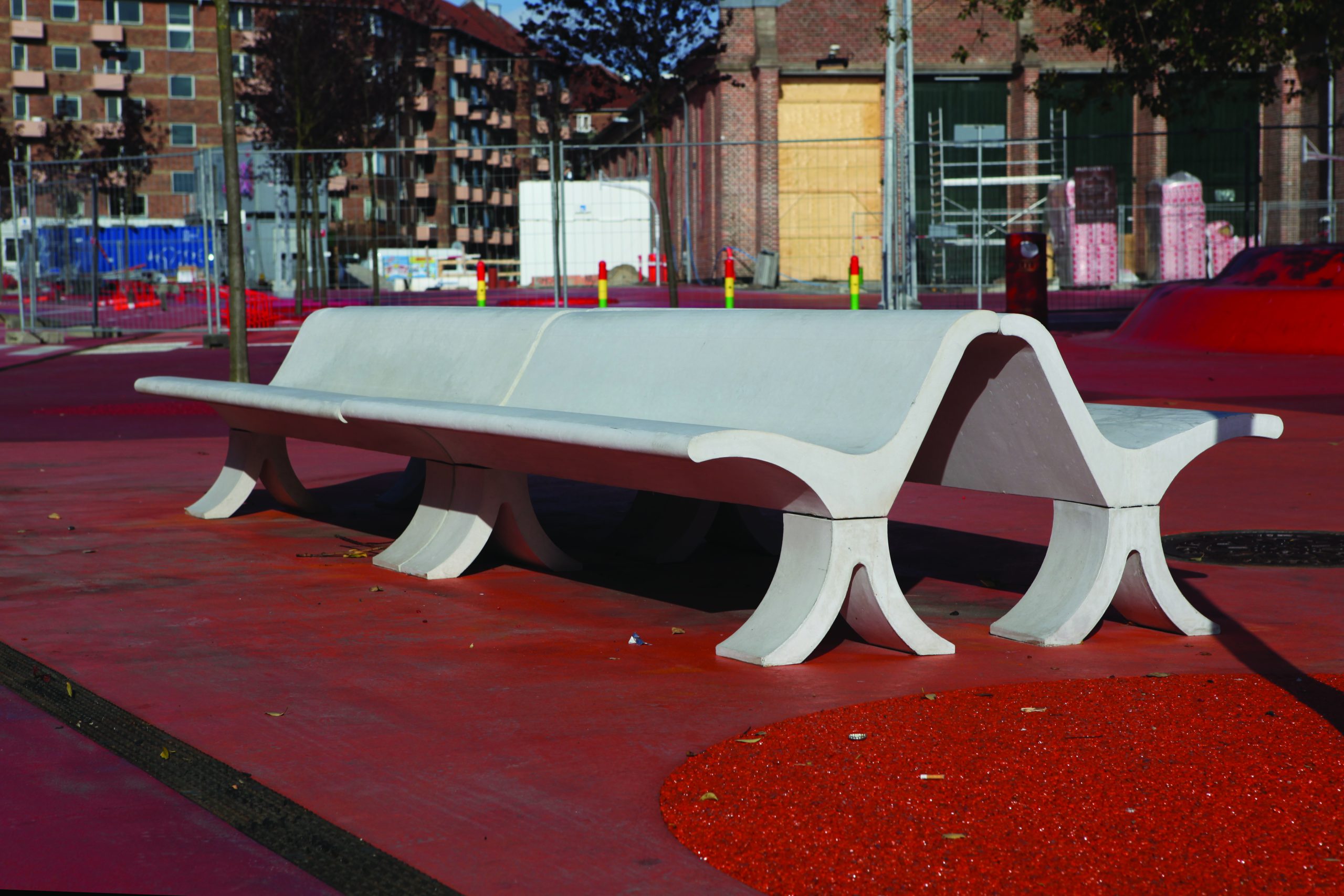
Superkilen, 2012. Red Square, Bench from Salvador, Brazil.
Photo: SUPERFLEX.
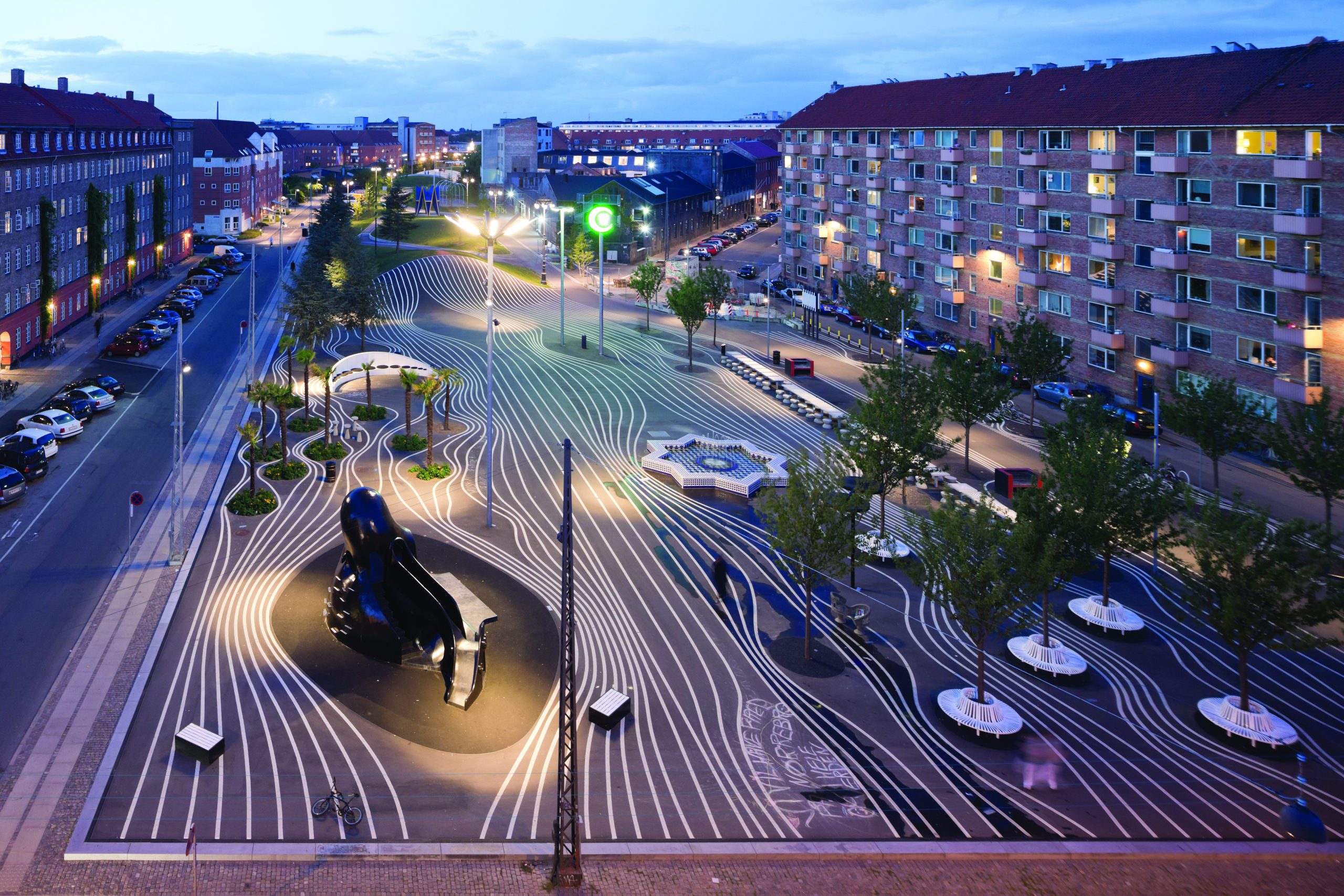
Superkilen, 2012. Black Square.
Photo: Iwan Baan.

Superkilen, 2012. Black Square, Octopus.
Photo: Torben Eskerod.
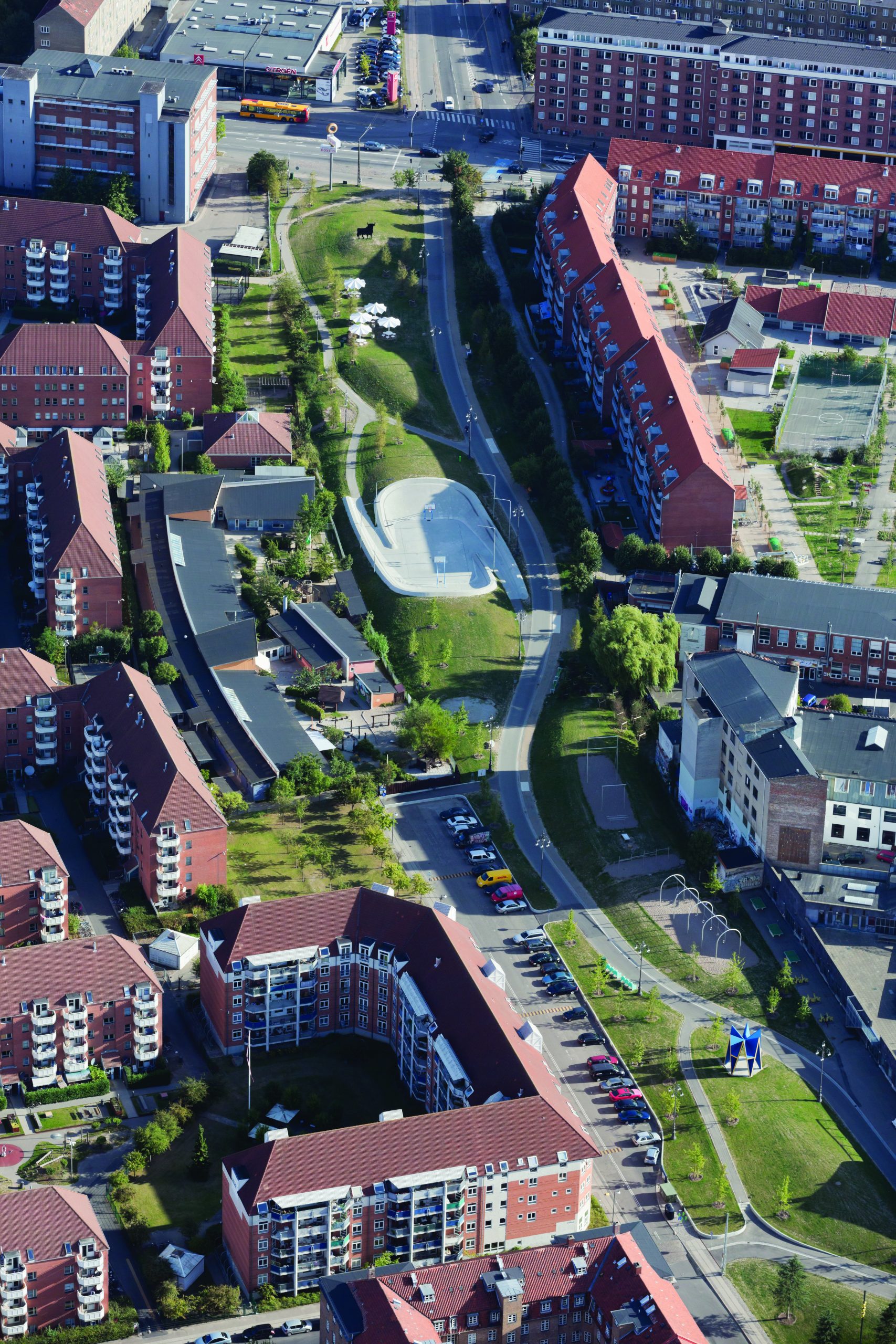
Superkilen, 2012. Green Park.
Photo: Iwan Baan.

Superkilen, 2012. Green Park.
Photo: Jens Lindhe.
All images Superkilen, 2012. Urban park in Copenhagen. Commissioned by City of Copenhagen and RealDania.
Developed in close collaboration with Bjarke Ingels Group (BIG) and Topotek1. Courtesy SUPERFLEX.
Berny Tan
Berny Tan (b.1990, Singapore) is an artist, curator, and writer working in Singapore. Her interdisciplinary practice explores the tensions that arise when she applies systems to – and unearths systems in – her subjective experiences. Tan’s strategies also reflect a fundamental interest in language as it is read, written, and spoken by her. As an independent curator, she has developed approaches built on principles of empathy, sensitivity, and collaboration.In 2022, she was awarded the IMPART Art Prize in the curator category.
Page Break
Page Break was a three-month Curatorial and Research Residency at the Singapore Art Museum, presented as part of the Singapore Biennale 2022, named Natasha. As a project, it looked at how everyday objects and scenes are explored through the medium of the art book, particularly within the context of Singapore.
While residencies tend to be insular frameworks for research, Page Break instead allowed the public access to an open studio that hosted Tan’s personal workspace, an exhibition space, an art book library, and occasional programmes. The exhibition evolved over four ‘drafts’, incrementally incorporating book projects by Atelier HOKO, Catherine Hu, Chua Chye Teck and Liu Liling, Genevieve Leong, Lai Yu Tong, and Marvin Tang. The residency thus functioned as a site for collaborations that built on Tan’s existing connections within the visual art community in Singapore, bringing together artists and designers who make art books that examine the otherwise ordinary.
Extending the material exploration of the print medium, waste from print production was repurposed to create partitions and modular furniture which served as either seating or display surfaces. These structures were designed by art director Pixie Tan with support from Sean Gwee of fabrication collective Made Agency. At the conclusion of Page Break, the materials were returned to the recycling process, minimising the waste generated by the project.
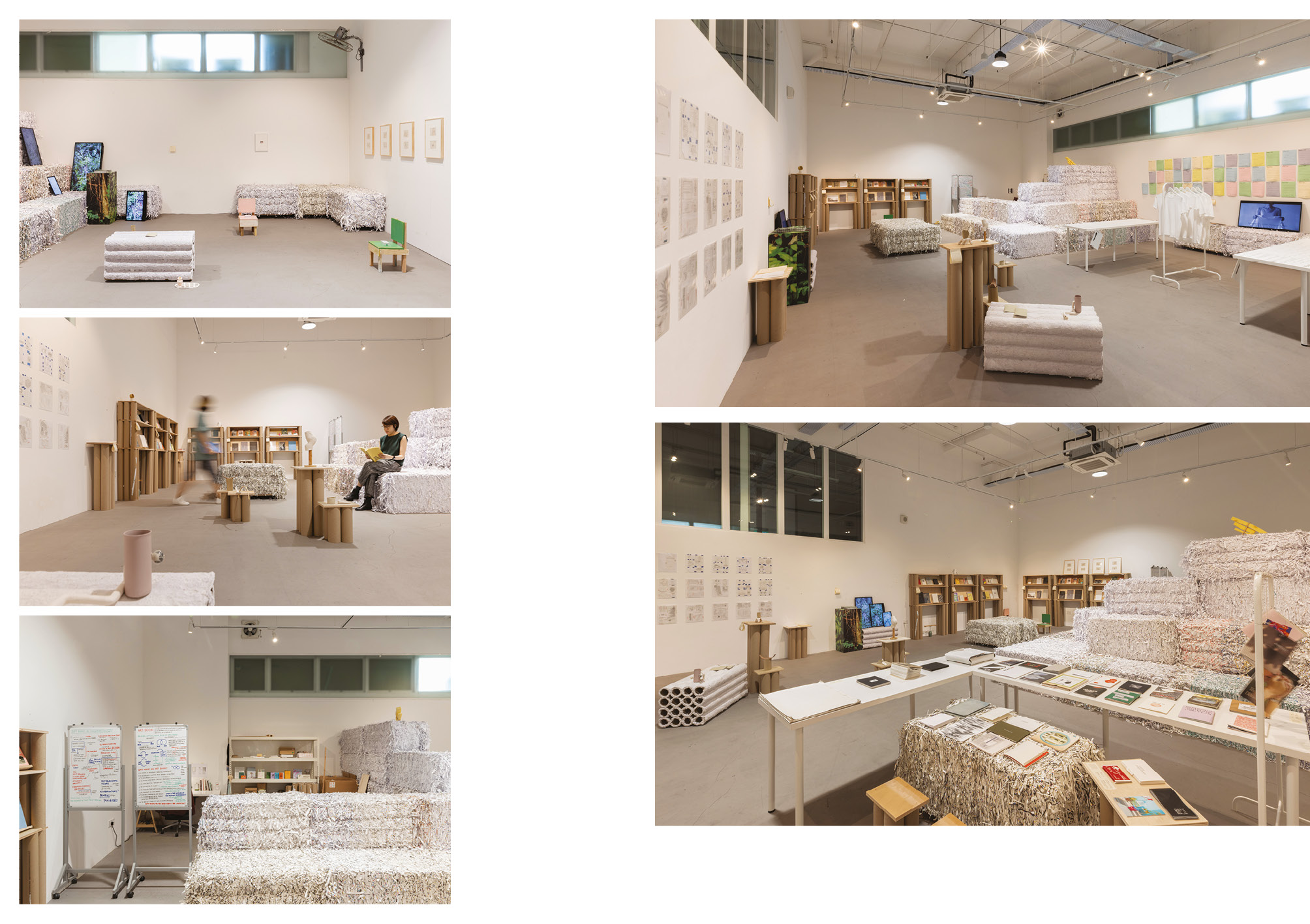
Berny Tan, Page Break, 2022-23.
Curatorial and research residency at SAM Residencies. Installation view at Singapore Biennale 2022 Natasha, Singapore Art
Museum at Tanjong Pagar Distripark. Photo: Marvin Tang. Courtesy the artist.
Sung Tieu
Sung Tieu (b. 1987, Vietnam) lives and works in Berlin, Germany and London, UK. Tieu’s work takes place at the intersection of her personal experiences, global history, and the cultural incursions of European art traditions. Her immersive installations result from her research of the dynamics of hegemonic globalised capitalism, working through and with spatial dislocation while paying heed to the cultural testimony of the Vietnamese diaspora communities in Germany. Through the personal lens of post-colonial identity and cultural membership, she upsets the status of objective narrative and of proof when science works at the service of sociopolitical agendas. While addressing social and cultural class divides in both contemporaneity and recent history, Tieu’s work foregrounds the ways evidence is manipulated in imperialist violence, both of physical and psychological nature.
Loveless
Inside the 18th century decor of the gallery, two dining table units designed for custodial environments have been installed. Across their stainless-steel surfaces empty food containers have been left, suggesting they have been recently used. Ambient sound hovers in the room. Composed of field recordings and audio libraries, the noise of kitchen alarms, gates slamming and neon lights flickering have been built in to a single dissonant rhythm that eventually transitions into a melody. Images move across a stainless-steel encased TV screen. The images, like the field recordings, are observational. Through sound and a newspaper clipping specific spatial locations are invoked while the melodies leave an undercurrent of a personal memory. This is contrasted by the sculptural elements that adjure a blank expression of global universalism for the audience to engage with.
Parkstück
Parkstück is the third in a trilogy of exhibitions each comprised of two artworks: Loveless and Formative Years on Dearth (both 2019). Formative Years on Dearth saw Tieu collect, stage and reinterpret a selection of materials from an extensive research of the John Latham Archive. Tieu creates a visual essay by interweaving histories of John Lathams personal life with her own memories. This intuitive personal account used Latham’s voice to entangle the private and the personal with global social and financial narratives.

Sung Tieu, Loveless, 2019.
Installation view, Loveless, Piper Keys, London, UK, 26 January–24 February 2019
Courtesy the artist; Piper Keys, London; and Emalin, London. Photo: Mark Blower
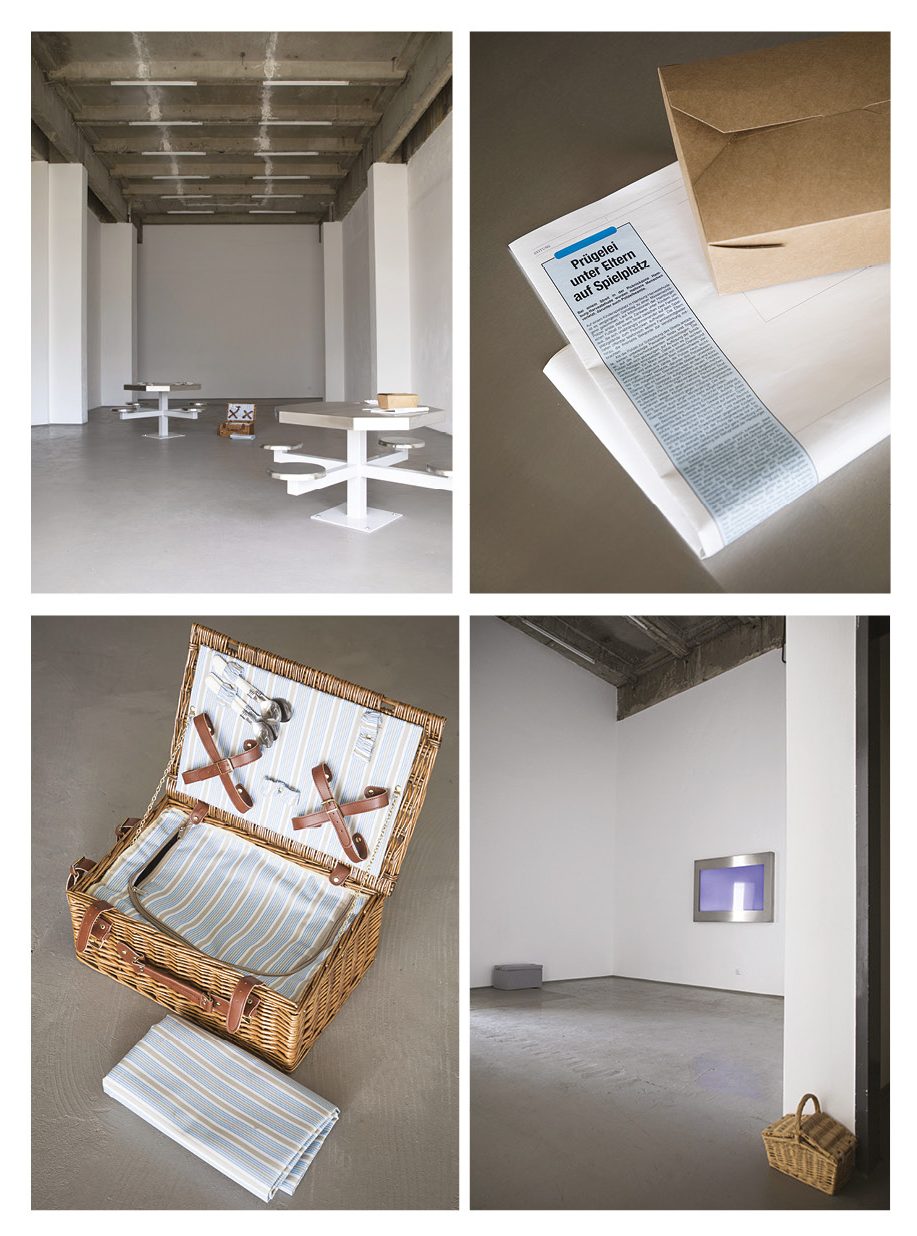
Sung Tieu, Loveless, 2019.
Installation view, Parkstück, Fragile, Berlin, Germany, 01–28 June 2019.
Courtesy the artist, Fragile, Berlin, and Emalin, London.
Trevor Yeung
Trevor Yeung (b. 1988, China) uses botanic ecology, horticulture, aquarium systems and installations as metaphors that reference the emancipation of everyday aspirations towards human relationships. Yeung draws inspiration from intimate and personal experiences, culminating in works that range from image-based works to large-scale installations. Obsessed with structures, he creates different scales of systems which allow him to exert control upon living beings, including plants, animals, as well as spectators.
Mr. Cuddles Under the Eave
Mr. Cuddles Under the Eave is a large-scale installation composed of 13 uprooted pachira aquatica (also widely known as money trees) suspended from the ceiling on an eight– by eight–metre metallic grid. Each tree is leashed onto the hanging structure with ratchet straps tied through the crevices of the tree’s braided branches. The trees are dangled without order, some hanging diagonally and hori-zontally, whilst others are suspended vertically.
The trees are imprisoned to the ruthless harness of ratchet straps, being subjected to a condition of immobility. Standing beneath the installation, one cannot help but feel an imminent menace, weary that the trees may collapse at any moment. The state of restraints embodied in Mr. Cuddles mirrors the lockdowns of the last few years. The interdependency between people during isolation is not unlike the branches of the money trees, which are actually multiple plants woven together during growth; they are fated and without escape. These leashed trees personify a collective anxiety, power-lessness and fragility.
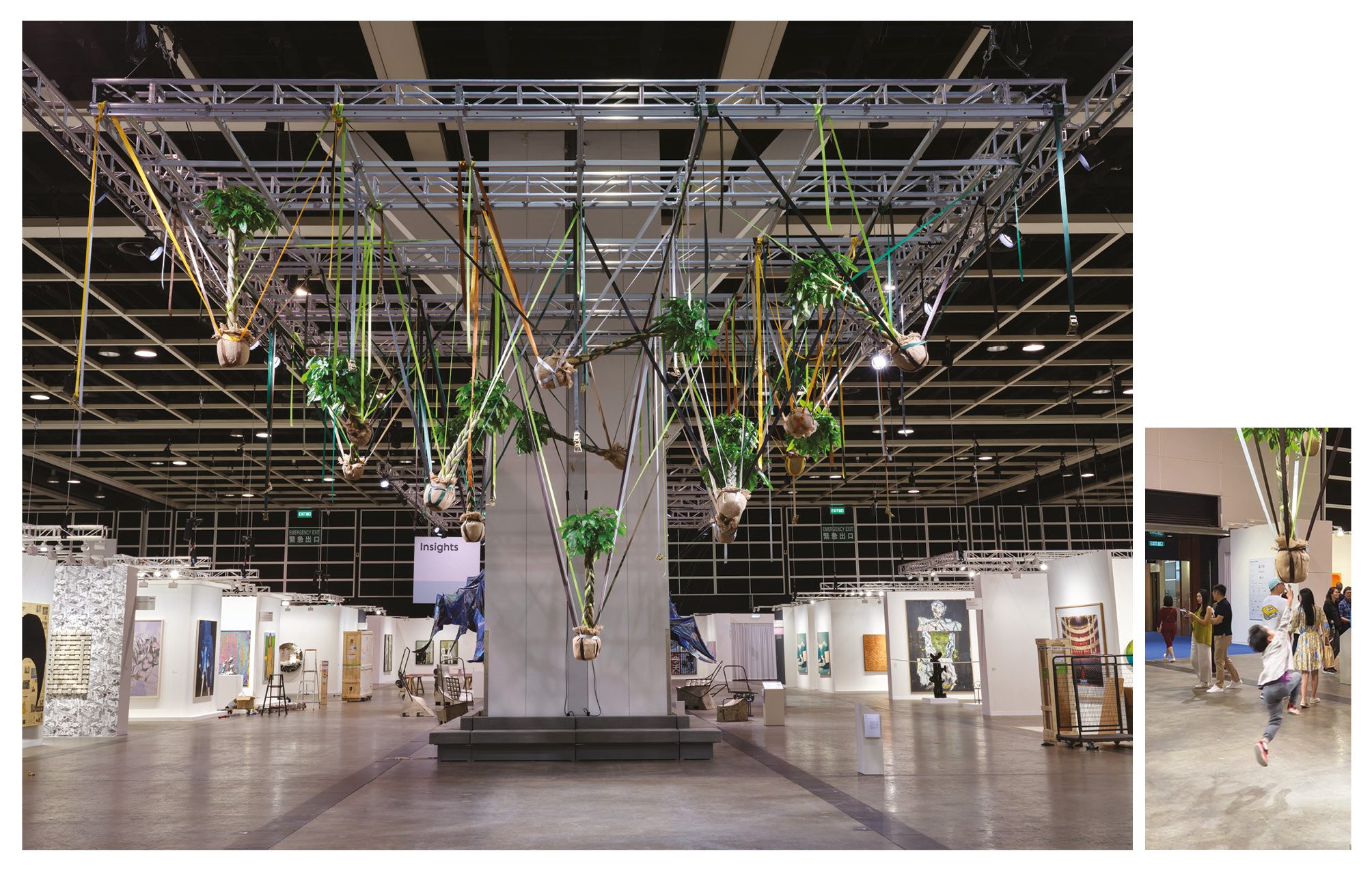
Trevor Yeung, Mr. Cuddles Under the Eave, 2021.
Pachira trees, straps. Dimensions variable. Installation view Art Basel Hong Kong 2023. Photo: South Ho.
Courtesy the artist and Blindspot Gallery.
Footnotes
* Lefebvre, H. (1996). Writings on Cities. Oxford: Wiley-Blackwell. (p.195)
Essays
Time and Tides: Xiao Lu’s Recursive Art, 1989-2019
The inescapable focus of any commentary on the art of Chinese-born female artist Xiao Lu is the action of her firing a gun into her installation Dialogue 对话 (1988-89). That event took place on the opening day of the China/Avant-Garde Exhibition at the China National Art Gallery1 in Beijing on February 5, 1989, four months before the Tian’anmen Square Massacre. It is as if Xiao Lu herself was killed too on that fateful day when she was 26 years old. Her later artwork has received little critical attention, overtaken by a meta-narrative written in 1989 which, it must be said, she has been complicit in enabling through her silence. Fifteen years after the gunshot event, Xiao Lu challenged her own mute stance with an explosive revelation about the deeply personal circumstances relating to the creation of Dialogue and the shooting action. Her declaration called into question a powerful storyline that had developed around the work and its authorship which lessened, and in some instances removed, her agency from the shooting. Dominant male voices in the Chinese art world (emanating from art academies, art criticism and arts bureaucracies) had privileged grander claims of socio-politically inflected intent.
Since 2003—the year Xiao Lu spoke out—she has created a series of powerful artworks, many of them performance pieces. She is one of few Chinese artists who have persisted with the form. While she has moved forward in her artistic practice, she has continually been drawn back into the complex orbit of 1989, a watershed period in recent Chinese history that remains unsettled and contested to this day. Her ongoing reference to the events of 1989, driven by an obsessive desire to correct the historical record, arises from her determination to seek art world recognition for her work and her actions. Despite the notoriety that Xiao Lu has accrued as a result of the work, Dialogue and the related shooting action have also proved a difficult legacy for the artist and those associated with her to negotiate.
In her recent art Xiao Lu has confronted sensitive issues including the difficulties of communication between the sexes, gender inequality and individual justice within Chinese society. At the same time, she often returns to the gunshot—the moment that changed her life—an action that has been forever linked to the bloody suppression of pro-democracy protests in 1989, a highly sensitive topic which remains off-limits for investigation in mainland China. This essay re-positions Xiao Lu’s art as a significant strand of contemporary art practice that is intended to unsettle the viewer. It begins with a detailed account of Xiao Lu’s 2019 work Tides 弄潮, performed at daybreak on the beach at Stanwell Park outside Sydney at high tide2 on 18 January 2019. It is followed by contextualising sections designed to provide interpretive lenses through which to understand the work further. As with the majority of Xiao Lu’s performance works, Tides was developed in response to an invitation, in this case a commission to create a new work for the artist’s first retrospective exhibition, Xiao Lu: Impossible Dialogue 肖鲁:语嘿, at the 4A Centre for Contemporary Asian Art in Sydney.3 The essay argues that Xiao Lu’s art may best be understood as a recursive practice informed by cyclical time and the feedback loop of 1989 in which she and others closely involved in the gunshot event, remain caught.
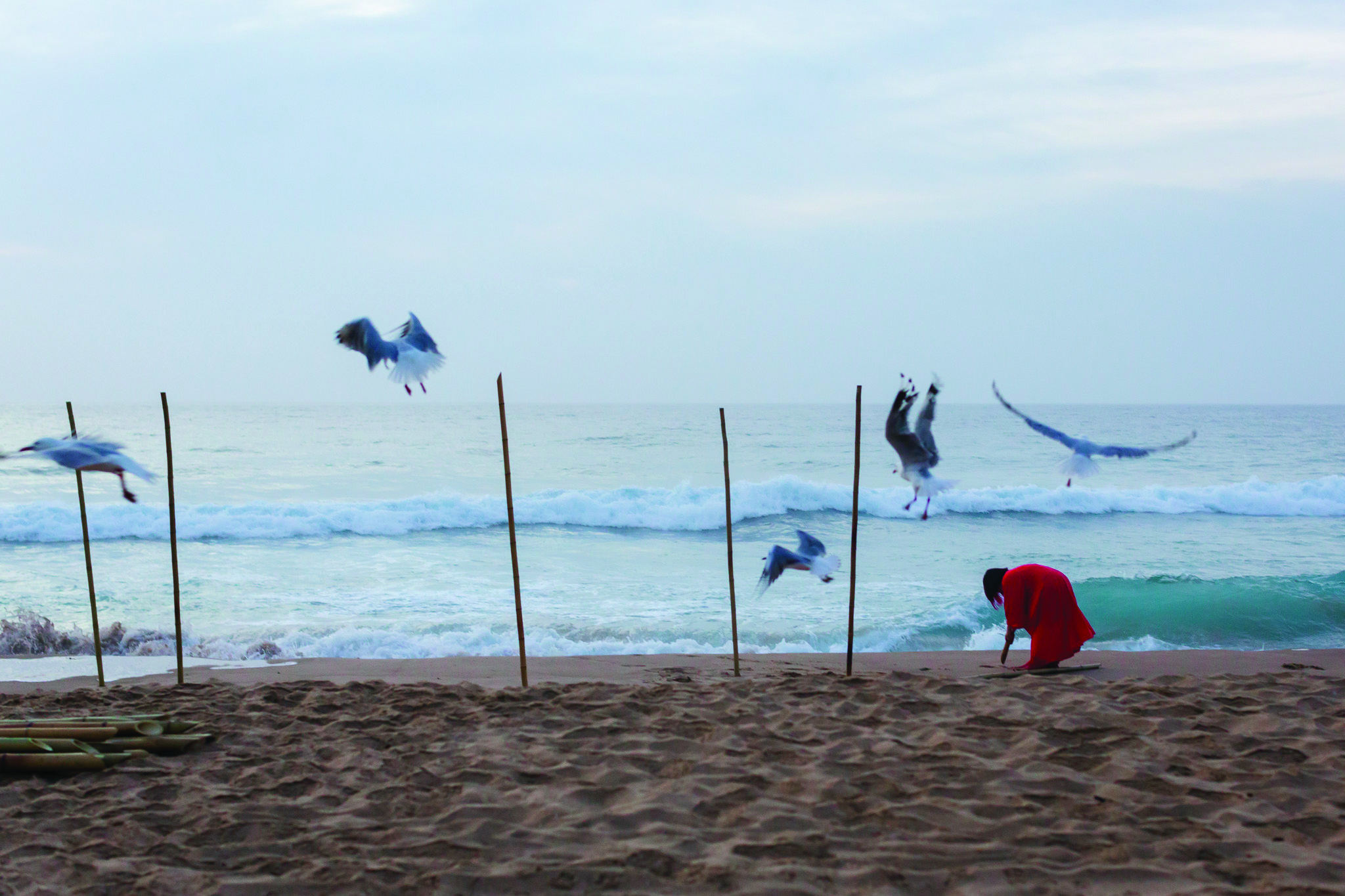
Xiao Lu, Tides 弄潮, 2019, performance documentation, Stanwell Park, Sydney, 18 January 2019.
Commissioned by 4A Centre for Contemporary Asian Art, Sydney.
Photograph by Jacquie Manning. Courtesy the artist.
Action
Making her way to the shoreline of the beach at Stanwell Park as the sky begins to lighten, Xiao Lu gazes out at the Pacific Ocean. The photographers make their preparations. Cirrus and cumulus clouds catch the sun’s first rays; the ocean delivers slow, surging waves. It is a beautiful morning. Without giving any sign the performance is about to begin, Xiao Lu picks up a bamboo pole from the pile of 30, turns and makes her way down to the shore. Using one of the bamboo pole offcuts, she digs a hole in the sand and plants the first bamboo stake, making sure it stands upright. In the cool silence of the early morning, the only noise is the sound of the incoming tide. In the low light it is not possible to make out the artist’s features. She appears as a silhouette against the ocean’s waves, silvery and glistening at first light; a dark, rounded figure carrying a staff. The scene is monochrome, as if rendered in brush and ink.
As the sky becomes lighter a flock of seagulls comes shrieking and careening, flying close to Xiao Lu and around the bamboo poles. Xiao Lu continues to repeat the action undistracted. Before long the seagulls find greater interest on the upper beach. At times, in between planting the poles, Xiao Lu stops to gaze out to sea, catching her breath, her palms facing outwards in a gesture of apparent openness. Stillness follows activity. As she continues, the beachside town south of Sydney comes to life. Lights in distant houses turn on, signalling the start of the working day. Surfers arrive to ride the waves at high tide; morning walkers and runners work out, dog-walkers commune with nature before the mundane dictates of life take over the day. Passersby are bemused by the activity. Some stop and ask what is going on, curious that an art happening is taking place in their community; others merely take note of the strange occurrence and continue with their routines. The surrounding landscape gradually takes on colour. A cargo ship anchored out at sea is now visible on the horizon line. As morning dawns it is possible to see Xiao Lu’s features more clearly: her dark, crimped hair dyed with a shock of red and cut in a short bob, and her long red silk dress created for the occasion by her friend, female artist and designer Feng Ling.4 The intensity and brilliance of the reds contrast strongly with the earth-coloured sand, glistening white-blue ocean and the dark protective headland.5 Midway through the performance Xiao Lu realises the high tide will not be as high as had been anticipated during the previous afternoon’s reconnoitre, and she begins planting the poles much closer to the incoming waves. The distance back to the pile of poles is now greater and requires her to climb up two low banks of sand. The process is tiring and her face reddens. She stumbles and falls, her progress encumbered by the long silk designer dress, now heavy with the weight of water and sand. She injures her hand on the sharp diagonal edge of the bamboo offcut being used as a digging aid and continues by ‘winding’ the poles into the sand, securing their positions with her bare feet. Her toenails are painted bright red. As she winds the poles deep enough into the sand to stand upright, they oscillate in space creating invisible diagonal lines. All the while, Xiao Lu battles incoming waves which increase in intensity, destabilising her footing and that of the poles. Head down, body bent, using both hands and feet, it takes all of her energy to wield the poles into position. Focused on the task, her face is rarely revealed to the cameras. The long kimono-like sleeves of the dress billow in the wind while the wet dress clings to her legs, at times appearing translucent against the brightening ocean and sky.
Part way through the performance one of the bamboo poles moves and then begins a slow, elegant fall, passing from an upright position through a series of diagonals as it topples onto the sand. Rolling into the sea, it is later washed up on the beach and achieves a state of repose. Another pole succumbs to tidal force and is pulled out to sea. Xiao Lu continues with no apparent consideration of its plight. Played with by waves, then caught in a rip, it seems that the pole might well be taken out to sea, but it too is given up by the ocean and deposited back on the beach.

Xiao Lu, Tides 弄潮, 2019, performance documentation, Stanwell Park, Sydney, 18 January 2019.
Commissioned by 4A Centre for Contemporary Asian Art, Sydney.
Photograph by Jacquie Manning. Courtesy the artist.
After planting the last of 30 poles, Xiao Lu stumbles while climbing to the upper level of sand. Exhausted, she pulls herself up and turns to face the ocean, her arms outstretched. She signals that the performance has ended. It has lasted for one hour and ten minutes. The 28 bamboo poles that remain standing are silhouetted against the sand, sea and sky like lines inscribed on nature; their nobbly nodes ensuring that they are more than just straight lines. Out beyond the waves, male and female surfers who had entered the water soon after Xiao Lu began the performance are perched on their boards waiting for the next wave. The container ship on the horizon line is in a queue to come into dock.
Process 1
The conceptualisation of Tides involved a process of refinement and negotiation. An earlier proposal titled Ebbing Tide 退潮 involved a 30-day performance.6. Each morning the artist would collect debris from the strandline of a beach in Sydney—shells, stones, seaweed kelp and rubbish—and place it in a mound on the beach. Over time the daily accretions would form a small mountain. Wu Yanmei and Zhengze Yangping, two young artists who lived in the same artist compound as Xiao Lu in Beijing, would assist. Wu and Zhengze had documented Xiao Lu’s earlier performance work Coil (2018), filmed in her home-studio and would be in Sydney as artists-in-residence. The final proposal, Tides, retained the symbolism of the number thirty and the idea of durational performance, but over one day rather than thirty days. The proposal was communicated by email and then an image sent via WeChat.7 The sketch in brush and ink on paper adopted a horizontal format, unfolding from right to left like a Chinese handscroll. It began with the title 弄潮 or Tides, written in a vertical line, echoing brush strokes that gave form to a sparse grove of poles. A series of gently curving horizontal lines suggested a shoreline; short dashes animated a roiling sea and waves with white caps. Wandering through the scene was a figure facing the ocean, head down, walking in a long gown pulled taut by the weight of water and sand. There was nothing to indicate that the figure was necessarily a woman; it could be an ancient sage, a hag, a shaman even. The sketch had a timeless quality. The brushstrokes varied in intensity, some heavy with wet ink, others dry and ethereal as the ink on the brush depleted in the process of painting. The rhythm of wet and dry consistencies appeared to echo the artist’s breath, suggesting the repeated action of returning the brush to the inkstone to replenish it with ink. Painted in Beijing in September 2018, the sketch had an autumnal chill suggesting the difficulty of imagining the scene on a beach in Sydney in high summer. Despite her art school training in oil painting and drawing inspired by French academic and Soviet models, Xiao Lu has come to prefer the subjectivity of calligraphy-and-ink painting, drawing on the remembered practices of reading and writing and the visualisation of the image in the mind’s eye. She has developed a regular practice of calligraphy and routinely uses ink sketches to give form to her performance concepts. Ink and calligraphy feature prominently in Xiao Lu’s works.8
As with all of Xiao Lu’s performances, the work would not be fully known until the performance was completed. While the brush-and-ink painting conveyed her mental image of the work and was used by the organisers to support the realisation of the performance, at each point in the process of discussion and preparation Xiao Lu insisted on being free to change the work at any time. Used to channelling energy from her surroundings, she insists on keeping open the possibilities inherent in chance occurrences.

Xiao Lu, Tides 弄潮, 2018, performance concept, brush and ink on paper. Courtesy the artist.
Context I – 30 years
The 2019 exhibition Xiao Lu: Impossible Dialogue at 4A Centre for Contemporary Asian Art in Sydney marked the 30th anniversary of Xiao Lu’s arrival in Australia. It was her first retrospective exhibition.9 It coincided with the 30th anniversary of what proved to be the turning point for Xiao Lu—the China/Avant-Garde Exhibition, a large and sprawling survey of experimental art in Beijing in 1989.10 Xiao Lu was one of the youngest exhibitors then and one of only a few women artists whose work was selected. On the opening day of the exhibition on 5 February 1989, the eve of the Lunar New Year, Xiao Lu famously fired a gun into her installation Dialogue 对话 (1988-89). She had completed the work the previous year as part of her graduation portfolio for the Zhejiang Academy of Fine Arts in Hangzhou. The provocative act of submitting an installation for her graduation from the oil-painting department was indicative of the defiant spirit of the times.11 She was the only woman in a class of 11 students. A readymade, Dialogue comprised the facades of two telephone booths, separated by mirror glass and a plinth on which was placed a red phone, the receiver dangling off the hook. Photographic portraits of a woman and a man, viewed from behind and seemingly talking into the phone, were affixed to the interior of the booths, the mise-en scène suggesting the impossibility of dialogue.
After the shooting, Xiao Lu and Tang Song attempted to flee the scene. Xiao Lu slipped into the crowd and left the gallery. She later turned herself in to the police. Tang Song, a male student in the brush-and-ink painting department at the Hangzhou art academy, whose work was not included in the exhibition, and a friend of Xiao Lu’s, was arrested and taken into custody.12 After their release a public statement was prepared denying that the ‘shooting incident’ was politically motivated, which was what the authorities most feared. The statement, signed by both Xiao Lu and Tang Song, formally linked Tang Song to the shooting event, and by association to Xiao Lu’s installation Dialogue, which in the process had been transformed into a stage for what was understood to be an avant-garde art happening.13
1989年.jpg)
Xiao Lu, Dialogue 对话,1989, documentation of installation and shooting, China/Avant-Garde exhibition, National Art Gallery,
Beijing, 5 February 1989. Reproduced courtesy of Wen Pulin Archive of Chinese Avant-Garde Art and Xiao Lu.
Four months later, the People’s Liberation Army brutally suppressed the student-led protests in Tian’anmen Square, Beijing, in a tragedy widely known as ‘June 4’ or the ‘Tian’anmen Square Massacre.’ A nationwide crackdown on dissent followed precipitating the departure of many people from China, including Xiao Lu whose gunshots would later be described as a prelude to the massacre. They “transformed the entire China/Avant-garde Exhibition into one big, chance happening that underscored the opposition to the official line and the political sensitivity of the Chinese avant-garde…” wrote Li Xianting, one of the curators, for example.14 The unimagined brutality of the crackdown on dissent and strictures placed on experimental art further overlaid the work with activist intention, associating it with a defeated idealism. In Li’s words: “The fate of the exhibition was a precursor to the fate of the student movement at Tian’anmen, in the sense that the China/Avant-Garde show became the final demonstration of 80s avant-garde art, marking the conclusion of an era and also the end of its ideals.15
Xiao Lu left China in December 1989 and found refuge in Australia. She would live in Sydney for seven years. She was eventually joined by Tang Song.16 They would return to China together in late 1997. Gao Minglu, the principal curator of the China/Avant-Garde Exhibition, later observed that with Xiao Lu and Tang Song’s removal of themselves from the Chinese art world, a situation resulted in which ‘[n]ormal art historical research [into the shooting event at the China Art Gallery] became completely impossible.17
Context II – Asserting agency
In 2003 Xiao Lu and Tang Song separated acrimoniously, prompting Xiao Lu to finally break her long silence about Dialogue and the ‘shooting incident.’ At the age of 41 she found herself unmarried, childless and in the difficult situation of being on her own. In a series of emails, online posts and performance artworks she claimed that the act of shooting the gun was an integral element of Dialogue.18 Her determination to present her version of events led to a semi-fictional autobiography titled Dialogue 对话 published in 2010 in Chinese and English by Hong Kong University Press.19 In a foreword, Gao Minglu, who had since relocated to the US, describes Xiao Lu’s shooting action as “no dogmatic sociology or random act of conceptualist significance, but, on the contrary, a long-term build-up of oppressions dating back to Xiao Lu’s youth.” Xiao Lu’s story, he wrote, is “a female tragedy within the specific system of Chinese socialism.20
Xiao Lu insisted that the installation and the shooting arose from a complex personal crisis, following a much earlier episode of sexual abuse that occurred while she was a minor studying at high school in Beijing and involving a senior male artist who was trusted as a guardian figure. Xiao Lu described the complex and multi-layered trauma as representing “the death of my body” and “my illness.”21 In aiming the gun at her image reflected in the artwork, Xiao Lu had staged a virtual suicide. The bitter separation from Tang Song 15 years later amounted to a double wound and prompted her decision to finally speak out. The motivation for Xiao Lu’s symbolic act of self-annihilation came from a deep, dark, personal space. Her revelation of it was as shocking as it was brave.
For those in the Chinese art world who linked the shooting to Tang Song and attached larger artistic and socio-political meanings to the event, Xiao Lu’s belated explanation proved difficult to accept. Her attempt to correct the historical record provoked disbelief and anger. It amounted to an undoing of the heroic narrative of the avant-garde and caused humiliation and loss of face for many people, herself included.22
Xu Hong, a leading Beijing-based female art critic, supported Xiao Lu’s claim of agency, citing qualitative differences in Xiao Lu’s and Tang Song’s approaches to art-making among other factors. While Xu Hong criticised Xiao Lu’s earlier silence as “a kind of acquiescence,” she took aim at the persistent “dictatorship of ideology” operating in Chinese art criticism at the time that devalued the expression of emotion in art. In her 2006 essay on Xiao Lu and Dialogue, Xu Hong drew attention to the denigration of women’s creative practice in art world discourse in China (mostly written by men), “perpetuating the myth of male greatness and female insignificanc.”23 In the end, Xiao Lu won the moral battle over authorship through market recognition.24 In 2006 a still photograph of Xiao Lu shooting her installation and a facsimile that she had made of Dialogue (the original work was lost or destroyed in the tumult after June 4, 1989) were listed under Xiao Lu’s name and sold at auction by China Guardian. The installation, which sold for 2,310,000 yuan, was acquired for the Taikang Art Collection, owned by Chen Dongsheng’s Taikang Life Insurance Co. Ltd. and managed by female curator Tang Xin.25 Ten years later, Dialogue was borrowed for the SHE: International Women Artists Exhibition (2016) curated by Wang Wei, the powerful female director of the Long Museum, a private art museum she established in 2014 with her husband Liu Yiqian in Shanghai. In a significant breakthrough, the exhibition juxtaposed the work of Chinese and international artists. Dialogue was placed in the final section of the exhibition titled Self-expression, which also included the work of international artists Jenny Saville, Tracey Emin, Bridget Riley, Miriam Cahn, Shirin Neshat, Ulay and Marina Abramovic, and Ana Mendieta.26 In the catalogue entry for Dialogue, the significance of Xiao Lu shooting a gun into her installation is summed up as having pushed performance art into extreme dialogue with legal and social systems and at the same time raised debate about the discourse of power between the sexes. The exhibition at Long Museum (West Bund) positioned Dialogue as an influential work in the development of women’s art.27
Context III – Becoming a performance artist
Since 2003 Xiao Lu has fired a gun at her own image (15 Gunshots… From 1989 to 2003); staged a mock funeral/wedding in which she marries herself (Wedlock, 2009); asked members of the public ‘what is love?’ (What is Love?, 2009); invited strangers to drink red wine with her, becoming so intoxicated she was rushed to hospital (Drunk, 2009); had her head shaved (Bald Girls, 2012); sought sperm donors in an exhibition in Yan’an that commemorated Mao Zedong’s 1942 “Talks at the Yan’an Forum on Literature and Art” (Sperm, 2006); ran naked from the Museo Diocesano di Venezia exposing her mature body and jumped into the Grand Canal (Purge, 2013); doused herself with a bucket of ink and then water (One, 2015); accidentally severed a tendon while using a sharp knife to cut her way out from within a tower of ice, when she was rushed to hospital and underwent emergency surgery (Polar, 2016); rolled around drunk and wailing in Piazza San Marco in Venice after consuming cup after cup of white spirits (baijiu), (Holy Water, 2017), and once again ended up in hospital.28
These works have been motivated by an unwillingness to accept the status quo and a determination to ask questions as well as to seek recognition as an artist in her own right. No longer content to hide, Xiao Lu has unflinchingly confronted details of her messy and at times traumatic private life. In the process she has challenged stereotypical attitudes towards women and drawn attention to issues of gender inequality and injustice in the Chinese art world and society more generally. Placing herself in awkward situations and making audience members part of the structure of the dynamics of viewing and experiencing, she works with intuition and feeling, living on her nerves. Her art is informed by a raw, disruptive aesthetic that draws on deep emotion, extreme action and chance.
The work Tides (2019) reflects on Xiao Lu’s life over the past thirty years, including the seven years that she spent in Australia—a complex and little remarked upon period of displacement and life experience that is nonetheless central to understanding her artistic formation. It links the histories of Australia and China; connections that have been forged over time by people from both countries crossing the Pacific Ocean for trade and enquiry, opportunity and refuge. Oceans connect land masses and islands. Shorelines are liminal spaces, ever-changing, with no strict boundaries or edges. The constant ebb and flow of water, fluid and yielding, wears away rock; what is soft is strong.29 The fluctuation of tides, the ocean’s breath, reminds us that our being and our actions are influenced by forces that are beyond our immediate control.
Tides joins a series of powerful works that reference the 1989 China/Avant-Garde Exhibition, notably 15 Gunshots… From 1989 to 2003 (2003), Dialogue About Dialogue (2004), and Wedlock (2009).30 What occurred in 1989 was larger than any one individual could anticipate or control. The achievement and significance of Dialogue (1988-89) is its ongoing resonance as a work of art generated by complex sets of conditions and circumstances that have in turn created multiple readings and interpretations. It has generated powerful new works that arise from its instability.
Process II
Originally for Tides Xiao Lu proposed to use poles harvested from a thicket of trees close to her home in Beijing, but the Australian government’s customs and quarantine regulations made that difficult to realise. Bamboo was therefore a material of compromise. It is native in China and there are three species that are native to northern Australia.31 It is evergreen and flourishes in winter making it an emblem of longevity in Chinese culture. Historically, bamboo is a subject favoured by Chinese brush-and-ink artists who see in its uprightness and tenacity the human qualities of integrity and plainness combined with elegance. Along with the plum blossom, orchid and chrysanthemum, bamboo is known as one of the ‘Four Gentlemen,’ representing the four seasons and four aspects of ideal male character. It is a material freighted with cultural meanings and gendered significance.
The Chinese title of Tides, Nongchao 弄潮—literally ‘riding the tide’—contains allusive meanings that run deep in the culture of modern China.32 The character chao 潮 which can mean ocean tide, (social) current or trend, appears in the compound words sichao 思潮 meaning trend of thought, xinchao 新潮 meaning new wave, and gaochao 高潮 meaning high tide, upsurge or climax.
Having acquired 30 bamboo poles and carried out the necessary logistical preparations, the 4A support team travelled with Xiao Lu to the beach at high tide to discuss the performance, filming and photography that would take place the following morning.33 Xiao Lu walked up and down the beach, which was strewn with bluebottles (Physalia physalis), those brilliant blue marine hermaphrodites that periodically wash up on Australian beaches in summer, carried onshore by winds and warm ocean currents, and sting. A location for the performance was decided upon and safety procedures worked out, including the possibility of bluebottles. The pile of 30 three-metre long bamboo poles would be placed in position before daylight. Xiao Lu would plant them one by one along the shoreline, her passage to and fro creating a series of lines radiating outwards from the pile. The end of each bamboo pole was pre-cut on a diagonal to create a pointy end and the interior diaphragms of the nodes in the lower section removed to make it easier to drive the poles into the sand. Xiao Lu practised planting a couple of poles. The bamboo offcuts proved useful for digging holes in the sand. The two videographers, David Ma and Zhengze Yangping, and two still photographers, Jacquie Manning and Wu Yanmei, discussed their respective positions and approaches. An arc would be drawn in the sand to indicate the photographic no-go zone. Xiao Lu did not brief the photographers, preferring that they find their own way to record the performance. Only Xiao Lu, Jacquie Manning and David Ma would enter the water. The photographers would wear thick socks to minimise the impact of any stings from bluebottles. Zhengze Yangping and Wu Yanmei, who could not swim, were asked to stay well away from the shoreline. If Xiao Lu got into trouble—she also cannot swim—there were procedures in place to go to her aid.34 Xiao Lu insisted that no matter what happened, the cameras must keep rolling. The performance would end when she gave the signal.
Setting out from the hotel at around five in the morning on 18 January 2019, the crew set up a base for equipment and supplies immediately behind the performance site, protected by a sand dune. The bamboo poles, tied into bundles of ten, were carried from the van and placed in position. It was pitch black. Torches and mobile phones provided light. The topography of the beach appeared to have altered significantly overnight. It was more undulating, with two steep rises appearing from the shoreline to the beach like steps. The reconfigured topography would make for a more strenuous performance and potentially create a more dynamic visual effect as the incoming waves forced their way up and onto the beach.

Xiao Lu, Tides 弄潮, 2019, performance documentation, Stanwell Park, Sydney, 18 January 2019. Commissioned by 4A Centre
for Contemporary Asian Art, Sydney. Photograph by Jacquie Manning. Courtesy the artist.
In conceptualising the performance it was impossible to know if any of the 30 bamboo poles would remain standing, and if so, for how long. During the course of the performance one pole succumbed to the onslaught of the sea, toppling over—its fate determined by the churn of waves. Another pole was swept out to sea and finally washed up on the beach to form part of the strandline. Separated from the ragged line of poles by some 50 metres and abandoned by cameras that were trained on the artist, it served as a reminder of the role played by chance in Xiao Lu’s art, and of the unexpected events that are part of the heave and pitch of life.
Coda
In 2021 Xiao Lu returned to Sydney where she currently lives and works. Tang Song passed away in Shanghai in 2022. The same year she discovered she had a serious heart condition and underwent an operation to install a defibrillator to prevent a sudden heart attack. Her doctor has advised against the kind of strenuous physical and emotional activity that past performance works such as Tides have demanded.
Footnotes
1 Known today as the National Art Museum of China. See China/Avant-Garde Exhibition, Asia Art Archive.
2 On Friday 18 January 2019 high tide at Stanwell Park was 1.56 metres at 6.29am. First light was at 6.07am and sunrise at 6.33am.
3 Xiao Lu: Impossible Dialogue, 4A Centre for Contemporary Asian Art, Sydney, 19 January–24 March 2019, formed part of the author’s Australian Research Council (ARC) Future Fellowship research project ‘Reconfiguring the World: China. Art. Agency. 1900s to Now’ (FT140100743). The exhibition was co-curated by Claire Roberts, Mikala Tai and Xu Hong. The exhibition and associated public programs were supported by the ARC, School of Culture and Communication, University of Melbourne, and the Australia-China Council.
4 Feng Ling is a graduate of the Harbin Institute of Art (BA, oil painting) and the Central Academy of Fine Arts, Beijing (MA, oil painting). In 2003 she established the Feng Ling Art and Design Studio in 798 Art District, Beijing. Xiao Lu and Feng Ling were among the artists included in the exhibition Sworn Sisters, Vermilion Art, Sydney (2018).
5 In Chinese culture red is associated with the age-old desire for happiness and good fortune.
6 Xiao Lu, Performance art proposal, Ebbing Tide (provisional), 19 July 2018.
7 Xiao Lu, email to the author, 8 August 2018. The initial proposal refers to 30 blue-coloured poles.
8 See for example, Quiet Contemplation (1986), Dialogue (1988), Love Letters (2009-10), Menopause (2011), Skin Paper Room (2013), One (2015), People (2016), Yin Yang Calendar (2013-14), Suspended (2017). See also: Guest 133-151; and Gladston and Howarth-Gladston, 120-129.
9 For details of the exhibition and associated public programs see “Xiao Lu: Impossible Dialogue,” 4A Centre for Contemporary Asian Art. For an analysis of a day-long workshop held at the 4A Centre for Contemporary Asian Art in conjunction with the exhibition; see also Alex Burchmore, “The China/ Avant-Garde Exhibition and Xiao Lu: 30 Years On.”
10 The exhibition had been developed over a number of years by a large group of curators, art critics and art editors including Gao Minglu, Fan Di’an, Fei Dawei, Hou Hanru, Kong Chang’an and Li Xianting. Earlier attempts to stage the exhibition had been thwarted by the government’s Anti-Bourgeois Liberalisation campaign of 1987.
11 In order to satisfy departmental criteria Xiao Lu finally submitted Dialogue plus Red Wall (1988), a competent realist oil painting depicting two Tibetan women standing against a weathered red wall. The subject derived from an academy painting trip to Tibet and was typical of work submitted for assessment at that time.
12 In video footage of the shooting filmed by Wen Pulin and released much later, after Xiao Lu had fired the first shot, Tang Song can be heard shouting “what about another shot.” See “Interview: Xiao Lu” by Carol Yinghua Lu, 14 March 2006 for Asia Art Archive (AAA). This interview records in detail Xiao Lu’s recollection of the creation of Dialogue, the shooting incident and her relationship with Tang Song. See also copies of the Arbitration Notices issued to Xiao Lu and Tang Song, detaining them for five days (Xiao Lu was released after three) for unlawfully carrying a firearm, dated 6 February 1989, in Li Xianting Archive/ AAA. With thanks to Genevieve Trail for assisting with access to these and other related materials.
13 Tang Song’s understanding of his involvement in the ‘shooting incident’ was conveyed in a letter to Hans van Dijk, dated 10 March 1989, Hans van Dijk/ AAA. See also Borysevicz, “Tang Song (1960-2022)” in Artforum, 15 July 2022; and Weng Zijian, “Tang Song fang tan (Interview with Tang Song)” recorded at Tang Song Studio, Hangzhou, on 27 November 2009.
14 Li Xianting xix. See also Gao Minglu viii.
15 Li Xianting xix.
16 In May 1991, after living in a resettlement camp in Hong Kong for six months and without any prospect of soon obtaining a visa for Australia, Tang Song stowed away on a cargo ship bound for Australia. On arrival in Sydney, Tang was arrested as an illegal immigrant and spent seven months at Villawood Detention Centre. In his artistic biography, he describes the journey as “a unique example of performance art.” See Tang Song, Curriculum Vitae, Xiao Lu in a fax communication with the author, June 28, 2002.
17 Gao Minglu viii.
18 After a chance encounter and conversation with Gao Minglu in Beijing, Xiao Lu formally wrote to Gao who, since 1991, had been living and working as an academic in America. She also wrote to Li Xianting. The details of their exchanges were later published online and included in a dossier of material relating to Dialogue that formed part of the performance Dialogue about Dialogue (2004). In that work Xiao Lu stood in front of a replica of the Dialogue installation, read out a poem explaining her actions in 1989, and then proceeded to a cut a lock of her hair, which had not been cut since 1989, placed it on a dossier of documentary materials and handed it out to audience members, one after another. The lock of hair was intended as a sign of sincerity and truth. See references to the communication with Gao in Xiao Lu, Dialogue, 205. See also Carol Lu’s “Interview: Xiao Lu.”
19 The English language edition was translated by Archibald McKenzie.
20 Foreword, Dialogue xiii.
21 Dialogue 1-2.
22 See Gao Minglu xiii.
23 Xu Hong, “Ta, Tamen, Ta, (Her, Them, He)” 16. The essay was written in response to discussion at the Second Shenzhen Critics’ Forum, 30 November 2005. Xu Hong was the only female among 29 critics from across China. See also Xu Hong, “Zouchu shen yuan (Walking Out of the Abyss)” 17. Xu Hong was a participating artist in the 1989 China/Avant-Garde Exhibition.
24 For many years Tang Song continued to list the ‘shooting incident’ in his Curriculum Vitae. Tang Song’s work Crime Scene (Fanzui changjing, 2013) included in his online solo exhibition on Artshare.com alludes to his ongoing pre-occupation with the incident. See “Kuangre jiqing de siyu (Whispers of Raging Passion),” Artshare.com.
25 China Guardian Auctions Co., Twenty Years of Contemporary Chinese Art (Zhongguo dangdai yishu ershinian, Zhongguo Jiade 2006 qiuji paimai hui), 22 November 2006, items 260 and 261.
26 The accompanying publication, by Wang Wei (ed), is divided into four chronological chapters. The first chapter Self-annihilation was reserved for historical works by Chinese artists; the second Self-liberation included the work of one international artist, France Leplat; the following chapter Self-introspection included works by Jenny Holzer, Maya Lin, Yoko Ono, Kiki Smith, Mona Hartoum, Louise Bourgeois, Marlene Dumas, and Joan Mitchell.
27 Wang Wei 224, 246.
28 For details of works see Xiao Lu’s website Xiao Lu Art.
29 This idea alludes to the words of the ancient writer and founder of philosophical Daoism, Laozi, in the Dao De Jing, chapters 43 and 78. See Dao De Jing, Chinese Text Project.
30 The works were commissioned to mark the 30th, 15th and 20th anniversaries of the China/Avant-Garde Exhibition respectively.
31 For an analysis of the biogeographic implications of Australian native bamboo, see Franklin, Taxonomic interpretations of Australian native bamboos.
32 See Geremie R. Barmé, “Tides Chao 潮.” With thanks to Geremie for drawing this essay to my attention.
33 The support team comprised Mikala Tai, Michael Do, Kai Wasikowski from 4A, and
Claire Roberts.
34 Mikala Tai, Director of 4A, distributed a document outlining procedures and safety instructions for all those present at the performance.
References
Barmé, Geremie R. “Tides Chao 潮.” China Heritage Quarterly, no.29, March 2012, http://www.chinaheritagequarterly.org/glossary.php?searchterm=029_chao.inc&issue=029. Accessed 28 February 2023.
Borysevicz, Mathieu. “Tang Song (1960-2022).” Artforum, 15 July 2022, https://www.artforum.com/passages/tang-song-1960-2022-88813. Accessed 28 February 2023.
Burchmore, Alex. “The China/ Avant-Garde Exhibition and Xiao Lu: 30 Years On.” 4A Papers, Issue 6, 2019, https://4a.com.au/articles/china-avant-garde-exhibition-xiao-lu-alex-burchmore. Accessed 28 February 2023.
“China/Avant-Garde Exhibition.” Asia Art Archive. https://aaa.org.hk/en/collections/search/archive/fei-dawei-archive-exhibition-documents/object/chinaavant-garde-exhibition-exhibition-information-english. Accessed 17 April 2023.
China Guardian Auctions Co., Twenty Years of Contemporary Chinese Art (Zhongguo dangdai yishu ershinian, Zhongguo Jiade 2006 qiuji paimai hui), 22 November 2006, items 260 and 261, https://auction.artron.net/paimai-art43820260. Accessed 28 February 2023.
Dao De Jing. Chinese Text Project, https://ctext.org/dao-de-jing. Accessed 28 February 2023.
Franklin, Donald C., Taxonomic interpretations of Australian native bamboos (Poaceae: Bambuseae) and their biogeographic implications, Telopea 12, no. 2, November, 2008, pp. 179-191. https://www.researchgate.net/publication/228762508_Taxonomic_interpretations_of_Australian_native_bamboos_Poaceae_Bambuseae_and_their_biogeographic_implications. Accessed 23 February 2023.
Gao, Minglu et al. “Foreword.” Dialogue. Translated by Archibald McKenzie, Hong Kong University Press, 2010, pp. vii–xvi. Online: JSTOR, http://www.jstor.org/stable/j.ctt1xwc5m.3. Accessed 16 Apr 2023.
Gladston, P. and L. Howarth-Gladston. “Beyond Dialogue: Interpreting Recent Performances by Xiao Lu.” di’van: a Journal of Accounts, Vol. 5, 2019, pp. 120-129.
Guest, Luise. “Reclaiming Silenced Voices: Feminist Interventions in the Ink Tradition.” Shifting the Ground: Rethinking Chinese Art, special issue of Australian and New Zealand Journal of Art, Vol. 21, no. 1, 2021, pp. 133-151.
“Kuangre jiqing de siyu (Whispers of Raging Passion): Tang Song Solo Exhibition.” Artshare.com, http://www.artspy.cn/activity/view/5342. Accessed 28 February 2023.
Lu, Carol Yinghua. “Interview: Xiao Lu.” Asia Art Archive, 14 March 2006, https://aaa.org.hk/en/collections/search/library/interview-xiao-lu
Li Xianting. “Major Trends in the Development of Contemporary Chinese Art.” China’s New Art, Post-1989. Hanart T Z Gallery, 1993, pp. x- xxii.
Li Xianting. “1989 China/Avant-Garde Exhibition.” Li Xianting Archive/ Asia Art Archive. https://aaa.org.hk/en/collections/search/archive/li-xianting-archive-1989-chinaavant-garde-exhibition-beijing. Accessed 17 April 2023.
Roberts, Claire, Mark K. Erdmann & Genevieve Trail. Shifting the Ground: Rethinking Chinese Art, special issue of Australian and New Zealand Journal of Art, Vol 21 no. 1, 2021, pp. 1-4.
Van Dijk, Hans. “Letter from Tang Song to Hans van Dijk.” 10 March 1989, Hans van Dijk Archive/ Asia Art Archive, https://aaa.org.hk/en/collections/search/archive/hans-van-dijk-archive-tang-song. Accessed 17 April 2023.
Wang Wei, editor. Tamen: Guoji nüxing yishu tezhan (SHE: International Women Artists Exhibition). Shanghai shuhua chubanshe, 2016, pp. 224, 246.
Weng Zijian. “Tang Song fang tan (Interview with Tang Song).” Materials of the Future: Documenting Contemporary Chinese Art from 1980-1990/ Asia Art
Archive, https://www.china1980s.org/tc/interview_detail.aspx?interview_id=92. Accessed 28 February 2023.
Xiao Lu. Dialogue. Translated by Archibald McKenzie, Hong Kong University Press, 2010. JSTOR, http://www.jstor.org/stable/j.ctt1xwc5m. Accessed 16 Apr 2023.
“Xiao Lu: Impossible Dialogue.” 4A Centre for Contemporary Asian Art, https://4a.com.au/exhibitions/xiao-lu-impossible-dialogue-xiao-lu-yu-mo. Accessed 28 February 2023,
Xiao Lu Art. http://www.xiaoluart.com. Accessed 28 February 2023.
Xu Hong. “Ta, tamen, ta – cong Xiao Lu ‘Duihua’ yinnqi de sikao (Her, Them, He–Reflections Prompted by Xiao Lu’s Dialogue).” Jiangsu huakan, Vol. 16, January 2006, pp. 10-16.
Xu Hong. “Zouchu shen yuan–gei nü yishujia yu nü piping jia de xin (Walking Out of the Abyss: A letter to female artists and critics).” Jiangsu huakan, Vol. 7, 1994, p. 17.
Essays
Psychogeography: The City as Playground
in memory of Ralph Rumney
The City as Playground
Walking, running, and other variations on sport and game playing, including swimming, have been integral to the expanded practice of a growing number of international artists in recent years. Walking in particular, connects the Dadaists and the Situationists from the early and mid-20th century to contemporary art tendencies. But we can go as far back as Renaissance pageants and processions to see art and human movement coming together. And while we are there, it is worth remembering the playful practical jokes that Leonardo da Vinci was famed for playing on his fellow artists and patrons, gleefully described by Giorgio Vasari in his Lives of the Most Excellent Painters, Sculptors, and Architects (published in 1550). Particularly memorable was his habit of leaving visitors in one room of his house, then going into the adjoining room and using a pair of bellows to inflate a cow’s intestine like a huge balloon, often terrifying the guest. Moral of this story: one person’s play can be another’s fear.
Much closer to the present, by the 1970s, Nesa Paripovic, an experimental Serbian conceptual artist, made and filmed performative actions based on walking. As Felicity Fenner describes in her recent and very timely book Running the City Why Public Art Matters:
In one of his most famous works NP 1977, the artist, well-dressed in the attire of a Parisian flaneur, can be seen walking in a straight line through the centre of Belgrade. To prepare for the walk he drew a line through a map of the city, from the outlying suburbs straight through the very centre. As he follows that line, he stops for nothing and noone.1 Maintaining his course with complete disregard for private property or the urban planning infrastructure designed to control pedestrian thoroughfares in city streets, he climbs over fences and other obstacles in his path, strolls though playgrounds, and jumps over walls and onto roofs. All the while the artist mutters to himself, looks increasingly dishevelled2 and occasionally sits down for a cigarette break. Undertaken in this unorthodox manner, the route seems more labyrinthine than linear. As subversive as it is absurdist, this highly experimental work also provides a unique snapshot of Belgrade at the time, taking the viewer through working-class and well-off suburbs and revealing everyday details in the spirit of [Guy] Debord’s psychogeographic explorations.3
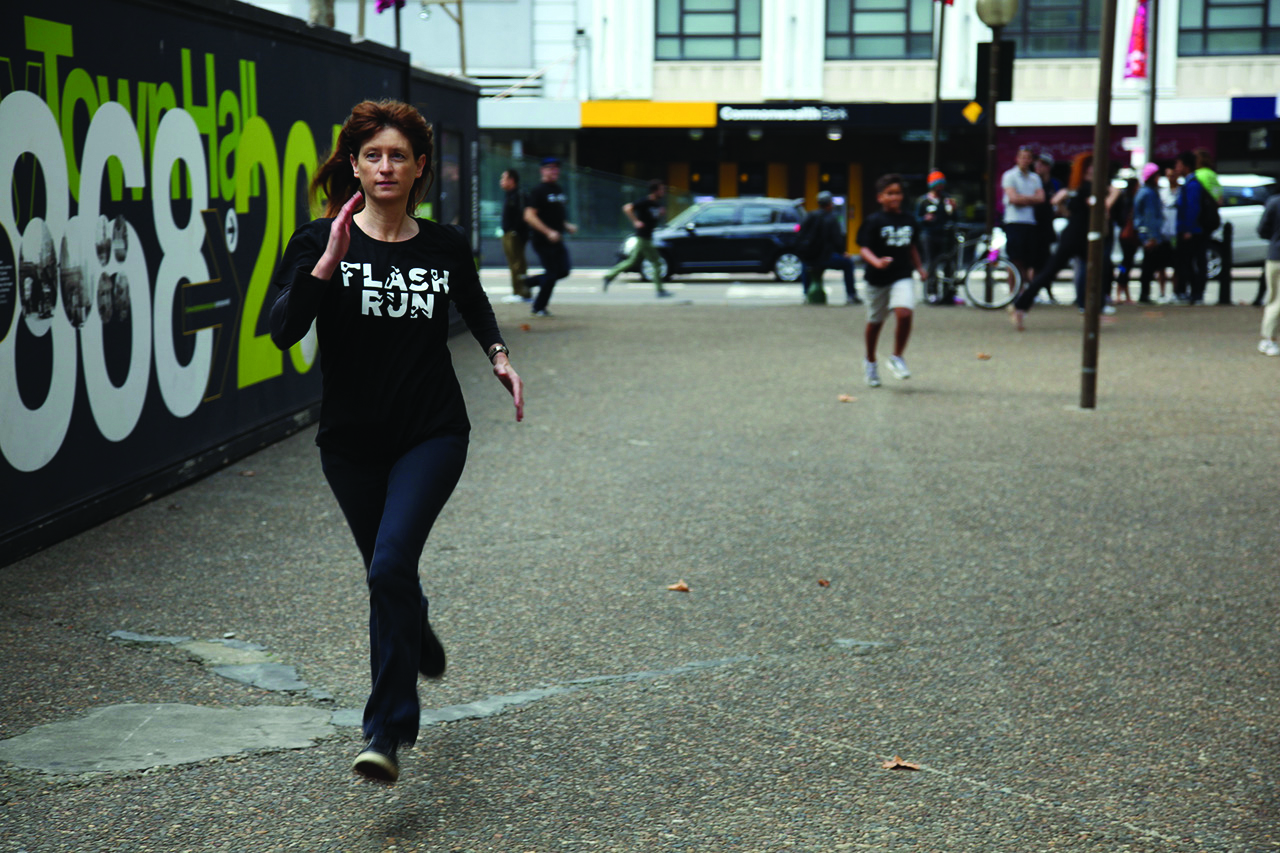
Felicity Fenner
Flash Run, Sydney, Australia, 7 June–20 July 2013
From Running the City: Why Public Art Matters
What is Psychogeography and who were the Situationists?
The Situationists (SI: Situationist International) were a pan-European group of artists, notionally led by the above-mentioned Guy Debord, and evolving out of the Lettrist International. They (a small group of less than a dozen) formed at a conference in Cosio d’Arroscia, Italy, in July 1957. Their stated aim was to eliminate capitalism “through revolutionising everyday life.” One of the main tools to do this came through harnessing a sense of play and of spontaneity. The Scandinavian artist Asger Jorn,4 a founding member of the CoBrA5 group of artists was one of those who joined on that momentous day. Others, as described in Tate Modern archives “were made up from two existing groupings, the Lettrist International and the International Union for a Pictorial Bauhaus. As well as writer and filmmaker Guy Debord, the group also prominently included the former CoBra painter Asger Jorn and the former CoBra artist Constant Nieuwenhuys [usually just known as Constant]. British artist Ralph Rumney was a co-founder of the movement.”6
I knew Ralph Rumney well. We became very close friends in the late 1980s, through to his death in 2002, aged 67. We completed many nocturnal explorations of different cities. The creation of Psychogeography, especially where ‘play’ is the guiding principle, is as much an invention of Ralph’s (I find it hard to refer to him as Rumney—too formal for the most informal of sentient beings) as it is of Debord’s.
As Lori Waxman writes in her page-turner of a book, Keep Walking Intently:
One of the greatest game players of all was Ralph Rumney, sole member of the London Psychogeographical Committee, an organisation he made up on the spot at Cosio [d’Arroscia in 1957]. Lost in Cologne, without a chart or any understanding of German, he used a map of London to find what he was looking for: Daniel Spoërri’s artwork-cum-restaurant and the Fluxus artist George Brecht. [On another occasion] drunk one night in Saint-Germain-des-Prés, he and a Swedish friend, having been kicked out of their hotel, decided to split up, one to the left, the other to the right, and meet in New Delhi.7 His friend made it all the way to India, only to find that Rumney had gone to Sicily and stopped.8
Chance and spontaneity play a huge part in the many art movements and tendencies that Waxman examines in her book. And it was through chance that Ralph and I first met in 1988 in The Plough Tavern, opposite the British Museum in Bloomsbury. I was on my way to the Cologne Art Fair which opened the next evening. I was looking for Peter Townsend, editor of Art Monthly magazine,9 used that pub more-or-less like an office. I was hoping for a commission or two. I was disappointed and surprised to find that he was not there. Then I spotted Jack Wendler, Art Monthly’s publisher who in the past ran a successful New York gallery for many years. Sitting next to him was a tall man, who to me looked elderly,10 dressed entirely in denim except for a black beret. Jack, with his cycle helmet and trouser clips on the table, ushered me across for a drink. Several hours later, Jack had cycled home, and Ralph and I were still talking. A whole new world was opening up to me. Eventually Ralph said, “It’s time we went on a dérive.” What’s a dérive, I wondered silently, suspecting I would soon find out? It was my first introduction to the art form. We kept walking almost until dawn, weak sunlight eventually lightening the Thames. Weaving through backstreets, stopping at late-night cafes and bars, ducking into theatres for the final (free) twenty minutes of a play, jumping on and off night buses at random…talking endlessly about art and ideas. He would be both delighted and amused to know that in 2023 a few voices on social media predict he (and his philosophy of game playing) will be to the 21st century what Marcel Duchamp was to the 20th. That night, we made plans for Ralph to come up to Edinburgh to satisfy his desire to meet and interview Ian Hamilton Finlay whose various battles from his moorland home and garden of Little Sparta I had been chronicling over a period of months for Art Monthly.
Ralph moved, as his friend Guy Atkins wrote, “between penury11 and almost absurd affluence. One visited him in a squalid room in London’s Neal Street, in a house shared with near down-and-outs. Next, one would find him in Harry’s Bar in Venice, or at a Max Ernst opening in Paris. He seemed to take poverty with more equanimity than riches.”12
Over the years I heard all the much-repeated stories—playing chess with Duchamp (“He was such a gentleman, I was young and he always lets me win”); his marriage to Peggy Guggenheim’s daughter Pegeen. Her eventual suicide, successful, as Ralph told me in an interview,13 on the 17th attempt. All this was confirmed and expanded upon in Waxman’s book:
Rumney even made a game of grave situations. After his wife Pegeen committed suicide, her mother Peggy Guggenheim had Rumney followed by private detectives [in Paris] while trying to bring a case against him for aiding and abetting her death. (It was eventually dropped.) Since they were trailing him everywhere, he walked a lot, wearing the PIs out by making them go on dérives without knowing it.14
Later, she describes the most fabled of Rumney’s dérives: “The Leaning Tower of Venice presented a psychogeographical investigation of the floating city. The first page declares: ‘It is our thesis that cities should embody a built-in play factor. We are studying here a play-environment relationship.’ ”15
This, astonishingly, from over sixty years ago.
Playful interjection16
I’ve just been Googling Ralph and have discovered an astonishing document. I was pretty sure he was the son of the Vicar of Wakefield (he was). My search was simply “Ralph Rumney son of the vicar of Wakefield.” About four listings down I came across this link:
https://www.editions-allia.com/files/pdf_468_file.pdf
This internet dérive had taken me to a catalogue of a posthumous Ralph Rumney exhibition held in Paris in 2010.17 In addition to photographs of the rare, physical artworks that he made18 there was a shot of his passport, multiple images of him playing chess, and several short essays in English written by friends and collaborators. The leading essay was published in French and was written by Michèle Bernstein. I am eager to get it translated. Bernstein was a founding member of both the Lettrist and the Situationist movements19 and one of the main contributors to the journal Potlatch. She married, first, Guy Debord and many years later (long after Pegeen’s suicide) became the third wife of Ralph Rumney. Much earlier, Debord had expelled Ralph from the Situationists for submitting his psychogeographical report on Venice a day late.
Venice, appropriately for a car-free city, has been the site of many walking projects since Ralph Rumney, including Sophie Calle, Janet Cardiff and George Bures Miller, Larisa Kosloff, and my own Word of Mouth project.20

Janet Cardiff and George Bures Miller
Night Walk for Edinburgh (Scotland), 2019, duration 55 minutes.
Photo: Dr Peter Hill (this walk and others can be accessed at:
https://cardiffmiller.com>walks>night-walk-for-edinburgh)
Influencing Contemporary Tendencies
The Situationists gave us two major devices (both playful in their intent) to navigate and engage with the mid-20th-century life of the city. These were the dérive (at its most basic level an unplanned ‘drift’ through the city during which decisions were taken spontaneously and ‘getting lost’ was seen as an achievement to be welcomed rather than feared); and the detournement, when a physical object (and sometimes an idea) was ‘turned’ into something else, to achieve an entirely different purpose. Both of these elements were, in the decades following, to influence the student demonstrations in Paris and England in 1968, and the Punk movement in music and fashion as envisaged by Vivienne Westwood and Malcolm McLaren in mid-1970s London. They continue to influence young artists and curators in the 21st century. For example, in Paris in 1968, students overturned café tables (put them through a détournement) and piled them high to form barricades in laneways as a barrier between the riot police and themselves. Australian cowboys (known as “boundary riders”)21 used their belt buckles to open bottles of beer, another detournement.
Michèle Bernstein famously published two détourned novels through Buchet/Chastel, whose moderate success “helped her convince her publisher to publish Debord’s major theoretical text, The Society of the Spectacle (1967), despite its non-commercial nature. In All The King’s Horses (Tous les chevaux du roi, 1960; republished Paris: Allia, 2004) and The Night (La Nuit, 1961; republished by Allia in 2013), Bernstein tells the same story in two different ways, adapting the plot of Les Liasons Dangereuses to create a ‘roman à clef despite itself featuring characters based on herself, Debord and his lover Michèle Mochot.”22
Over four decades after the student demonstration in Paris, in a work called Track and Field at the 2011 Venice Biennale, the artist team of Allora & Calzadilla ‘turned’ a 52-ton tank from the era of the Korean war, upside down and fixed a treadmill to its chassis. A classic détournement on an ambitious scale. This was the contribution for that year’s United States’ pavilion. Every day, outside the pavilion and throughout the six-month event, Olympic athletes in their uniforms took turns to run for 30-minute sessions on the ‘tank-treadmill.’ Meanwhile, inside the pavilion, further détournements between sport and contemporary life were made.
Reviewing these works in The New York Times in 2011, Roberta Smith says:
Body in Flight (Delta) and Body in Flight (American) are on view in the two galleries flanking the vestibule. As in Track and Field, performances by trained athletes, in this case gymnasts, provide momentary life. Here polychrome wood replicas of airplane seats—a Delta first-class flatbed seat and an American business-class reclining seat in sleep-ready position—serve as gym equipment while also reflecting both the luxuries and the class distinctions of air travel. The Delta seat functions as a balance beam for a female gymnast whose sensuous performance evokes an attractive model demonstrating appliances or cars at a trade show. The male gymnast uses the American seat as a pommel horse, and the loud thumps of his many energetic jumps, mounts and dismounts, executed without benefit of padding, provided a painful sound accompaniment. It seemed like debilitating, delegated endurance art.23
Other artists, such as the ever-playful Martin Creed, have used professional sportspeople in their projects, most notably in Work No. 850. He tasked professional runners with running through Tate Britain “as fast as they could, in a straight line, as if their lives depended on it.”24 This introduced not only movement to the usually static gallery, but also smell, through the artist’s sweat and perspiration, and sound through the slap of feet on marble. Both of these projects are also well-documented in Fenner’s Running the City.
On our (always playful, but deadly serious) route to the core of psychogeography, we should take note of some of the tendencies and individual projects that set our parameters. And we should never lose sight of that great Situationist dictum, “The Map is Not the Territory.”
Artists’ bars around the world are great places for chance meetings, as we have seen, and playful encounters. I remember in Amsterdam in the late 1980s meeting a South American arts entrepreneur called Eduardo Lipchitz Villa (descendant of the great Cubist sculptor Jacques Lipchitz) in a cafe called Het Paleis, close to Dam Square. He told me how he was trying to gain permission for a NASA satellite to film Ulay and Marina Abramovic walking along the Great Wall of China. I don’t know whether the satellite ever materialised, but Fenner also describes how in 1988 they deliberately ended their personal and professional relationship “beginning from opposite ends 5000 kilometres apart and crossing in the middle to say goodbye.”25


Lee Wen
Yellow Man, 1992–2012
Photo: Courtesy of iPreciation Gallery, Singapore
In Asia, Fenner writes, “Singaporean artist Lee Wen’s Yellow Man is a politically motivated performance involving walking through the city state, his semi-nude body caked in yellow pigment; and for Cities on the Move [South Korean conceptual artist] kimsooja undertook an eleven-day, 2727-kilometre performance walk through Korean cities carrying large bundles of cloth which referenced, among other things, the displacement of peoples.”26
Elsewhere in Running the City, Fenner writes pen pictures in dazzling prose of a variety of contemporary artists who expand the field of walking and running as an artwork. These range from the bigger-than--film-scenarios of Canadian partners Janet Cardiff and George Burres Miller, in which real fear is often induced in participants who undertake their “directed walks,” to the many public projects of David Cross in Australia and New Zealand, and Swedish artist Per Huttner’s extensive Jogging in Exotic Cities projects. The latter artist is described as “an absurdist alien runner.”27

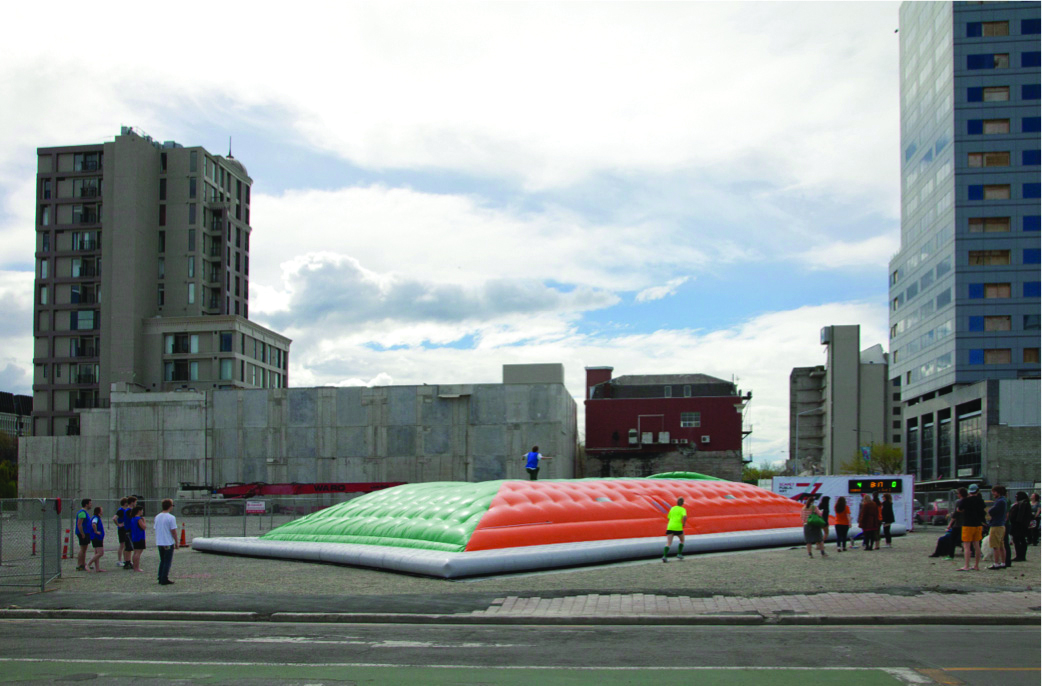
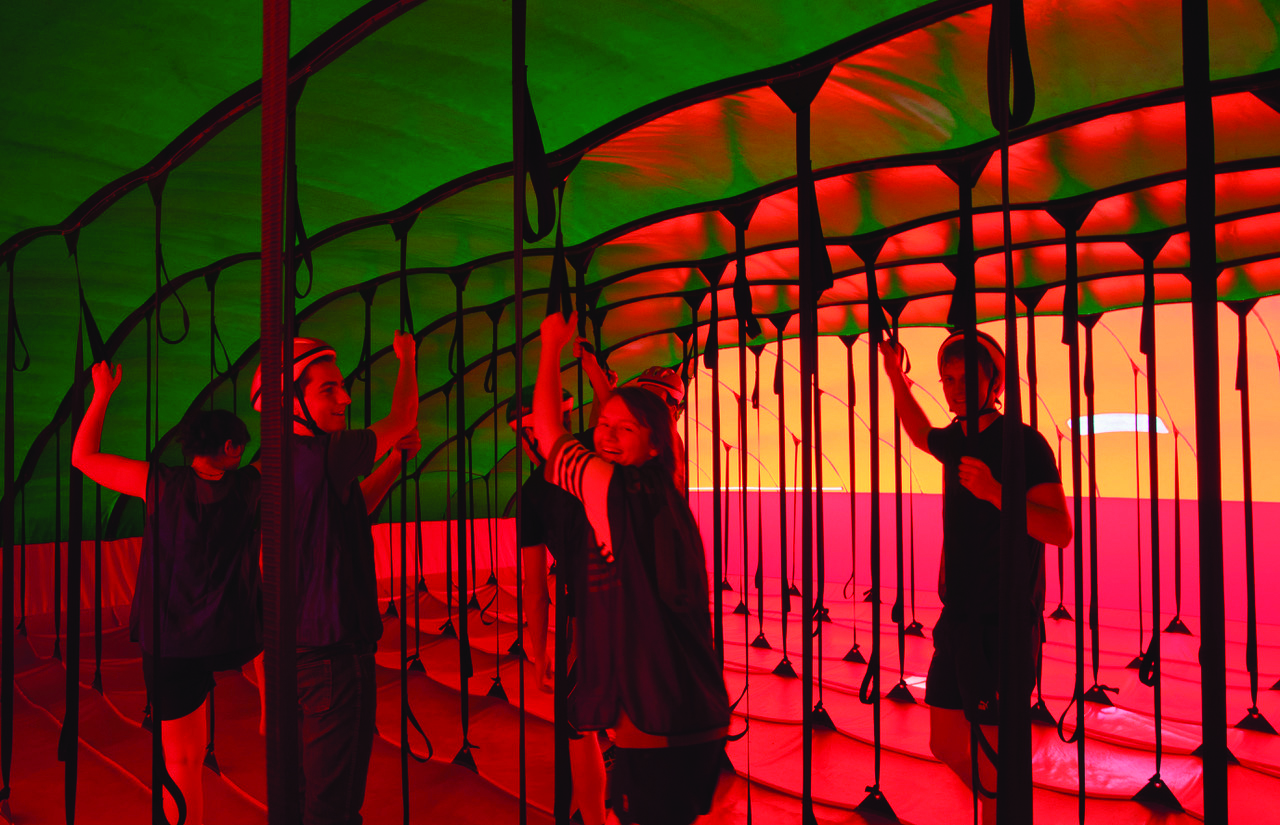
David Cross
Level Playing Field, Scape 7, Christchurch, New Zealand, 2013
Commissioned by Scape Public Art, curated by Blair French
Photo: Shaun Waugh
Spontaneity
Having to take quick and spontaneous decisions can produce some of an artist’s best works.
In 1921, Man Ray—having relocated from New York—after months of trying, finally secured a solo exhibition in Paris. His fellow Dadaist Tristan Tzara wrote the press release for the show, as described by Mark Braude in his recently published biography Kiki Man Ray.28 It was “pure Dada hokum: Man Ray, before stumbling upon Paris, had been ‘a coal miner, a millionaire several times over, and the chairman of a chewing gum trust.’”29
Braude reports that “Man Ray failed to attract any buyers despite pricing his work aggressively…the show garnered only a couple of sentences in the press.”30
However, “The best thing to come from the exhibition was a work inspired by Erik Satie. He showed up a few hours before the opening, more undertaker than composer with his black bowler hat, black umbrella, black frock coat, silvery goatee, and pince-nez. Meeting Man Ray for the first time Satie challenged him to create an object on the spot for the show. They went together to a hardware store where Man Ray bought a flatiron and some shoemaker’s tacks. He glued the tacks to the iron’s base, creating a compact machine for destroying clothes, which he titled Gift.”31
This readymade sculpture was lost during the run of the show. However, his photograph of it became a Surrealist icon, and as Braude remarks, “By Man Ray’s twisty Dada logic, this secondhand representation exuded even more aura than the original.”32
Another example of artistic quick-thinking happened on one of several crazy dérives I had with the German ‘Bad Boy’ artist Martin Kippenberger. It was at the first Frankfurt Art Fair (1989) and we were in a bar (of course). Stopping mid-sentence, Martin suddenly leapt across the tent to retrieve a white box that a waiter was throwing out. On its exterior, the word Martini was printed in large black letters. It probably held six bottles. With a wicked smile on his face, he put the box on his head and, raising his left hand obscured the last letter i. As if by magic, I was looking at the word Martin.
“The Directed Dérive”
A few years ago, in a COVID-free world, I was commissioned by ACCA (Australian Centre for Contemporary Art, Melbourne) to construct one of my own psychogeographic walks, taking inspiration from their then current exhibition of around a dozen artists who worked in Mexico City. Titled, Dwelling Poetically: Mexico City, a case study, it included works by Francis Alÿs, Andrew Birk, Ramiro Chaves, Martin Soto Climent, Abraham Cruzvillegas, Chelsea Culprit, ektor garcia, Yann Gerstberger, Jaki Irvine, Kate Newby, Melanie Smith, and Isabel Nuño de Buen. It was developed by guest curator Chris Sharp.33
This project is an example of how a dérive can be ‘directed’ by an artist yet remain “a magical mystery tour” to the participants being directed. Seventy percent of the dérive might be planned in great detail but 30 percent remains spontaneous. Many of these artists hailed from other countries but had made their home base in Mexico. One such was the Belgian Francis Alÿs. His videoworks were a useful introduction for my participants to the possibilities of psychogeography, especially one where he walks through the streets of Sao Paulo, Brazil, with a leaky can of blue paint, leaving a thin but colourful spoor across the city.
For the ACCA project, I wanted the participants to navigate the gap between visual art and literary fiction, to initiate their own Superfiction project, and to workshop this over three hours with each other, through walking and talking.
I directed the Events Curator Anabelle Lacroix to deliver a one-sentence summary of the projects of each of the 12 participants in the exhibition. She did this, as I expected, brilliantly. This allowed a complete tour of the show to be made in under 10 minutes. At the time, by chance, I’d been reading Last Evenings on Earth (1997), the book of dark and edgy short stories by Roberto Bolaño, who, fittingly for the project, spent most of his childhood in Mexico City. Better still, there were the same numbers of artists in the show as short stories in the book.
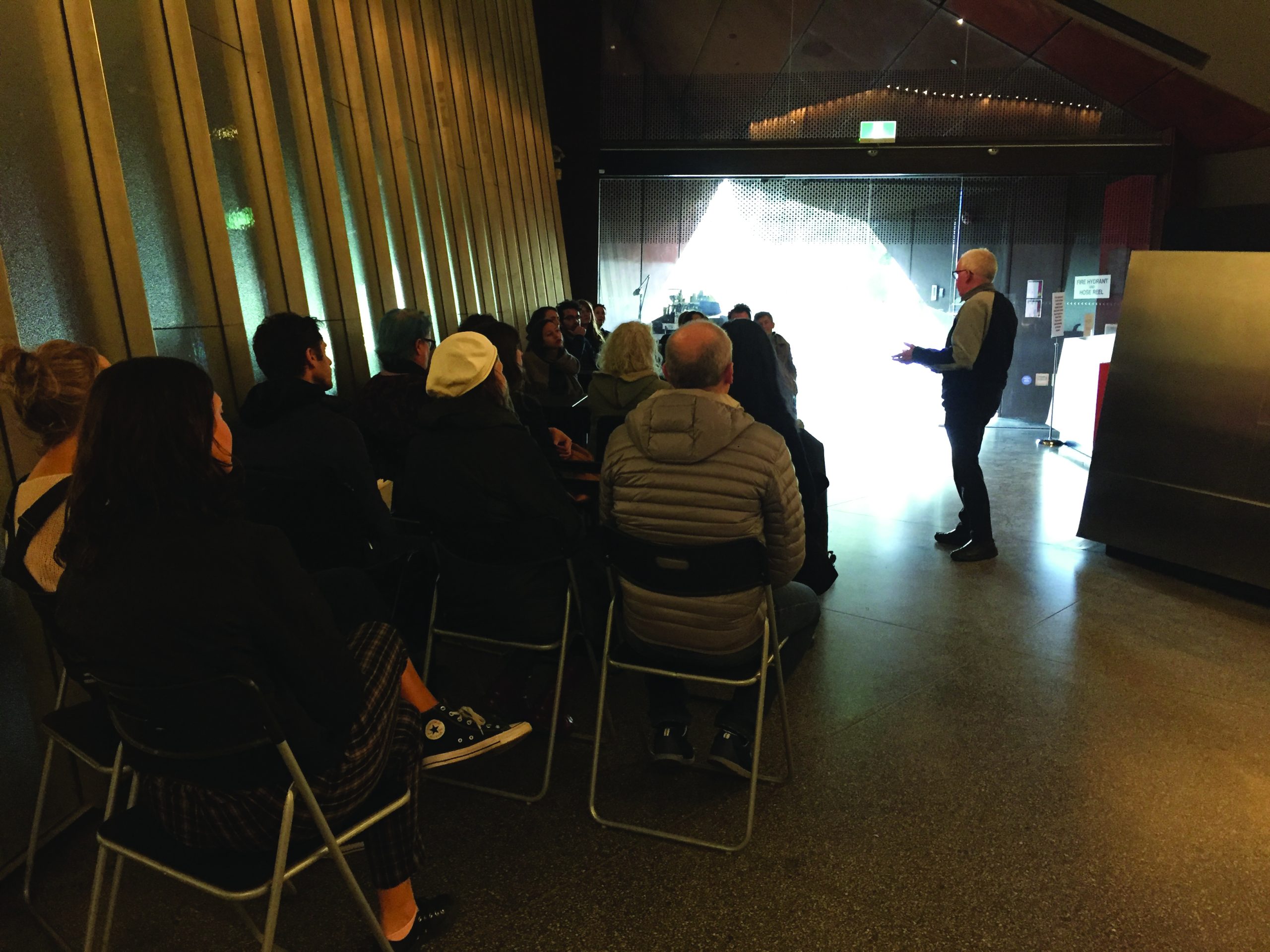

Peter Hill runs Psychogeography Workshop: Last Exhibition on Earth at ACCA, Melbourne, Australia, 2018
left Peter Hill instructs participants on Psychogeography and the (non)rules of the game
right Peter Hill leads the group around Melbourne CBD
Photos: Anabelle Lacroix
Returning to the foyer of ACCA, I handed each of the 25 participants34 an envelope containing just the first page of one of the short stories (this meant at least two participants would be getting the same short story page). I gave them a few minutes to read their texts, and then to choose an artwork from the show to pair with the text. We set off on our dérive with everyone instructed to remain silent for the outward journey and to use the walking time to reflect on what kind of artwork they would plan to make at a later date. It could be entirely text-based or object-based, but I hoped they would come up with solutions that bridged the gap between disciplines. Unknown to the group I had researched in advance two exhibition openings that would be happening in Melbourne that afternoon, with wine, conversation, and stimulating art. We attended these and then headed back to ACCA. One of my spur-of -the-moment decisions was to line up the entire group outside the second gallery in order of height, from tallest to shortest. I then paired them up with whoever was next to them and encouraged them to discuss their ideas as the drifted back to ACCA by whichever route they chose. This did two things: it meant they were probably paired with a stranger; and it meant being roughly the same height they had mouths and ears at the same level, useful with the noise of trams, crowds and traffic on a Saturday afternoon. Back at ACCA they used the final half hour to write up a plan of what they intended to make/write. Other devices I have used—often combining lectures with derives—include:
Navigating the city by changing traffic lights, and always going with whichever light is green;
Stopping the lecture three-quarters of the way through, at the point where I am describing dérives, and inviting the audience to put down their bags and “follow me”; I then lead a dérive through the city;
Arriving at a pre-planned gallery space where I have arranged small canvasses for the participants to work on in acrylic paint, sometimes “sitting inside a three-dimensional painting” and making paintings about painting;
In 1999, during a project at The Museum of Modern Art (Oxford, UK), I arranged to be kidnapped from the podium by three students dressed like terrorists, dragged into a waiting car and driven with my curator to Heathrow airport from where we flew to Stockholm and continued the project there.
The Next Step
Professor Antoinette LaFarge, based at University of California, Irvine, recently published the first academic book on Fictive Art (a tendency I call Superfictions). Titled Sting in the Tale: Art, Hoax, and Provocation,35 the hundreds of examples she details exhaustively, in six well-defined parts, range from Marcel Broodthaers’ The Museum of Modern Art, Department of the Eagles; and David Wilson’s Museum of Jurassic Technology in Los Angeles; to Angela Washko’s The Game: The Game (1918); and Guillaume Bijl’s Four American Artists (circa late 1980s).36
According to LaFarge, in the case of Bijl, his primary intention was “to satirise the recent rise of Neo-Geo abstraction as typified in the work of artists like Jeff Koons and Peter Halley. The works of [fictional artists] Janet Fleisch, .William Hall, Sam Roberts, and Rick Tavares thus bore many hallmarks of Neo-Geo work, including bright geometric elements alongside everyday objects such as baseball bats.”37
We immediately see how satire and parody can combine with narrative and biography in a way that is typically playful. But rather than the playfulness of the playground or the dérive through a city, it is a playfulness that exists in one’s own head, sparked by the use of fictive objects and moments in time (in this case contemporary art practice), existing in the gap between installation art and literary (or junk) fiction.

Peter Hill, The Art Fair Murders,1989–ongoing, detail of banner within larger
art fair “slice” (2014), at 45 Downstairs Gallery, Melbourne.
Photo: Dr Peter Hill
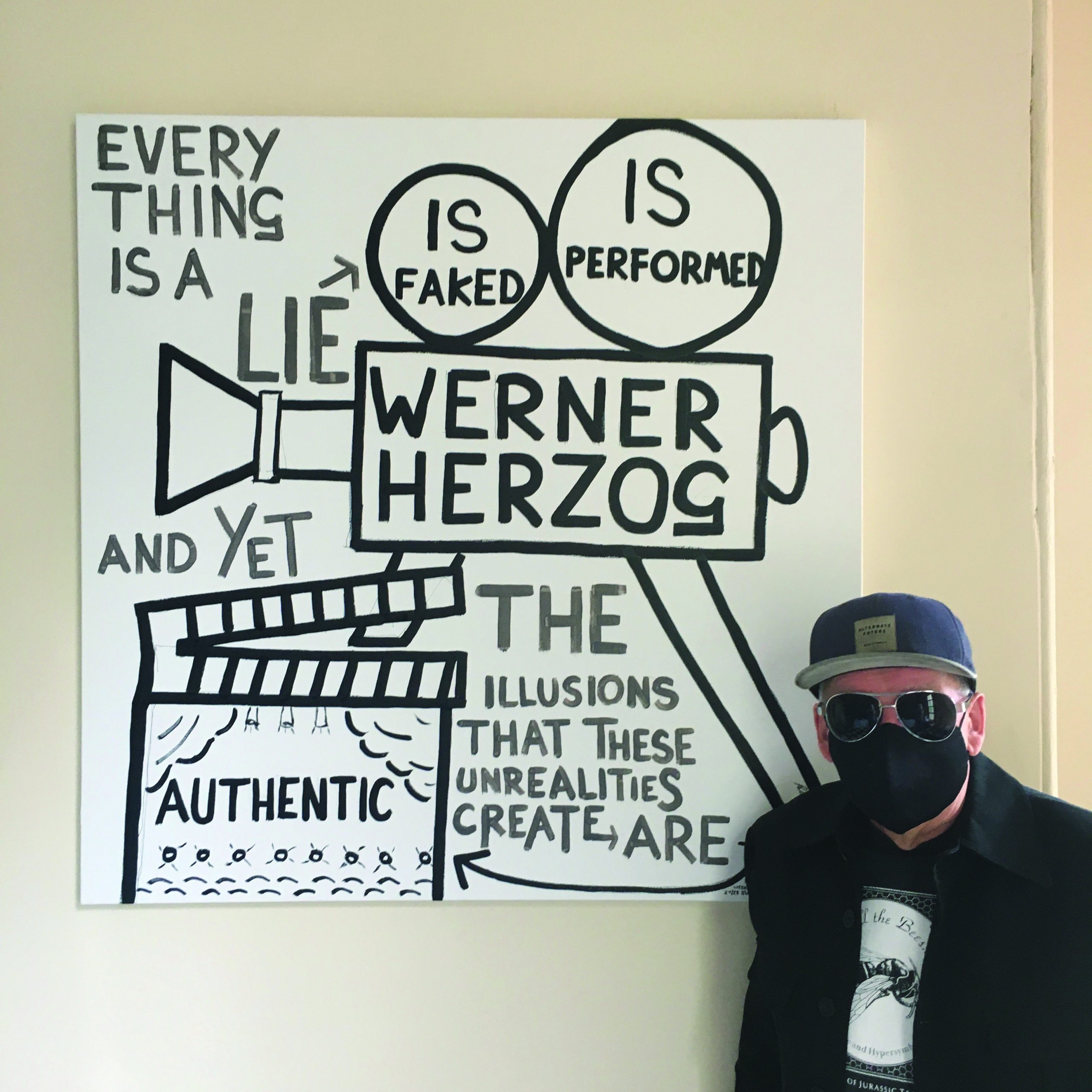
Peter Hill working as the Superfiction artist known as Stickleback,
a character in The Art Fair Murders and The After-Sex Cigarette (both 1989
ongoing). Painting made during COVID lockdown, Sydney, 2020.
Acrylic on canvas, 1m x 1m. Photo: Dr Peter Hill
In my own ongoing The Art Fair Murders, which speculates on a serial killer being loose in the art world, killing a different art world personality (artist, dealer, critic, collector, auctioneer etc) at each of 12 ‘real’ art fairs that were mounted in 1989 in cities as varied as Cologne, Chicago, London, Hong Kong, and Amsterdam, I created a love triangle between two abstract artists Herb Sherman and Hal Jones who fight for the love of Mexican-American graduate student Lisa Fernanda Martinez.38 They became literary devices as a way of introducing ‘plot’ to the act of abstract painting, extending the way ‘narrative’ had previously been fused with lyrical abstraction.

Peter Hill working as the Superfiction artists Herb Sherman and Hal Jones,
characters in The Art Fair Murders: Aesthetic Vandalism, 1989-ongoing.
Margaret Lawrence Gallery, Melbourne, 2012
I have recently been looking at a Melbourne-based artist Nick Selenitsch39 whose work has evolved over many years, from examining the physicality of play (playgrounds, sporting events, sport equipment, games etc) to sophisticated, and often very funny, fictional constructs.40
In a recent solo exhibition at Savage Garden, Melbourne, in November 2022, I was immediately drawn to Selenitsch’s project called Australian Crawl. In it, he imagined an alternative art history in which Piet Mondrian decided to move to Australia rather than New York. I will conclude this essay with some of the notes that accompanied this astonishing work, and the thought that this, and similar projects by a range of artists around the world, represent ‘the next step’ in the growth of genre-switching Superfiction projects, that also takes ‘plot’ into the realm of fiction:
Imagine the following alternative art history scenario: Piet Mondrian is an obsessive swimmer instead of a jazz tragic. Based on his passion, Piet flees Europe during WW2 to relocate to Australia rather than to New York. He gets a studio in Bondi, naturally, and to make ends meet he teaches swimming lessons on the weekends… While his art is embraced by Sydney’s underground contemporary art scene, he is ignored by the nation’s art establishment who believe that his artwork is a hoax;
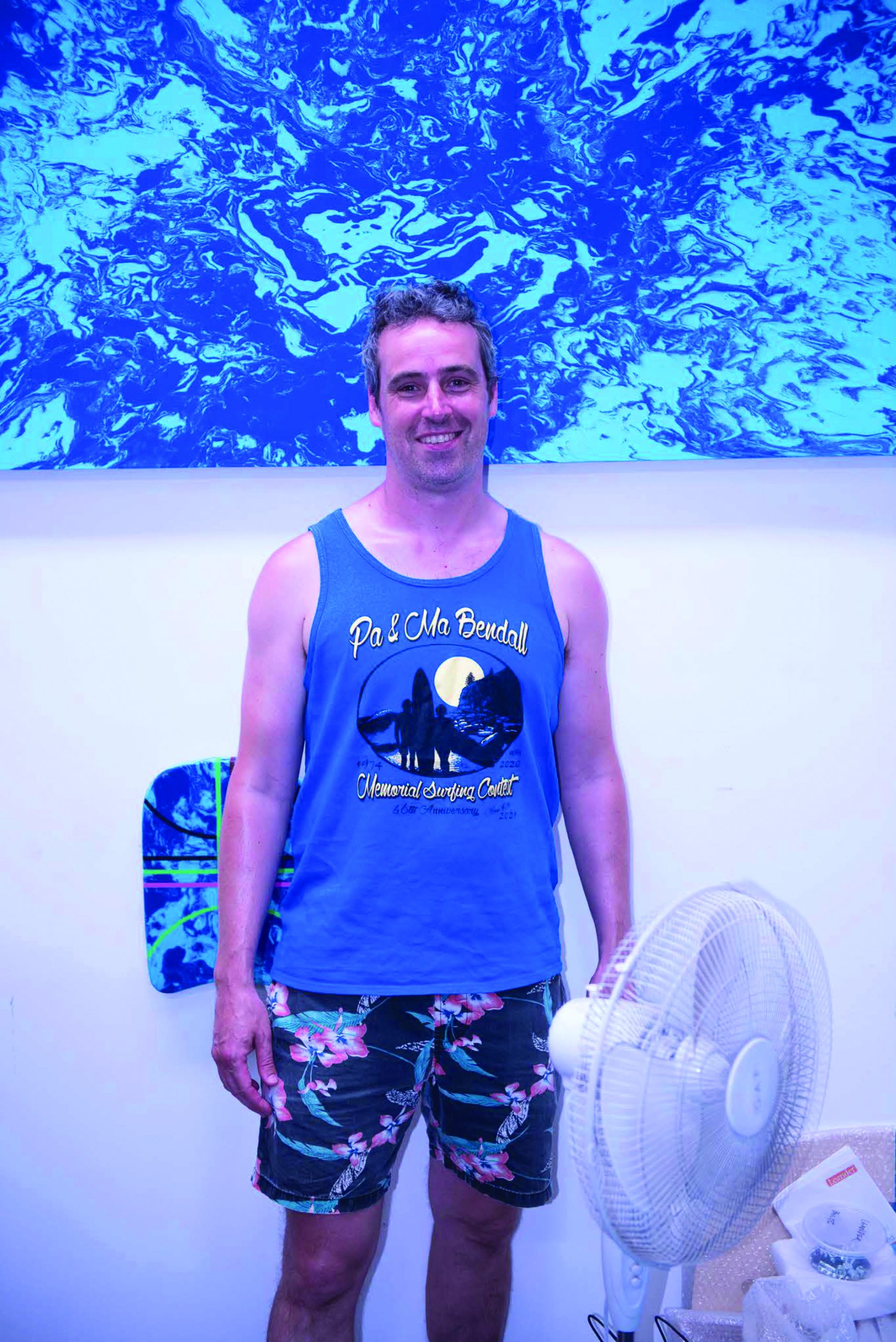
Nick Selenitsch in his studio, November 2022.
Photo: Savage Garden

Nick Selenitsch, /, (f), Synthetic polymer paint on foam kickboard,
36 x 25 x 3 cm, 2022
Photo: the artist and Sutton Gallery, Melbourne
all Modern Art, they believe, is a hoax. Instead, the only official honour he receives in Australia is to be placed on the honour board of the Bondi Surf Bathers’ Life Saving Club, for ‘services to the local community.’ Decades later, long after his death and, coincidentally, around the same time as his Bondi studio is being demolished for luxury apartments, Mondrian receives a posthumous retrospective at the Art Gallery of New South Wales.41
Footnotes
1 Not unlike a contemporary parkour participant.
2 There are echoes here of John Cheever’s great short story The Swimmer (The New Yorker, July 10, 1964), about the man who swims across America from garden pool to garden pool, drinking hard liquor along the way and slowly going demented, as one season turns to another.
3 Fenner 25
4 Asger Jorn founded Scandinavian Institute of Comparative Vandalism in 1961. He developed a philosophical system of “Triolectics” which led to the creation of “three-sided football.”
5 The name CoBrA is a playful construct from the first letters of the capital cities from which the founders hailed: Copenhagen, Brussels, Amsterdam.
6 Some dispute that Ralph Rumney was a founding member as he does not appear in the group photograph taken that day in Cosio d’Arroscia. However, Ralph was behind the camera, took the photograph and, some would say typically, wrote himself out of history.
7 German ‘bad boy’ Martin Kippenberger (mentioned again later in this essay) similarly indulged in pan-continental projects when he instructed a student he was mentoring to walk across Africa from West to East. Apparently, he did.
8 Waxman 131
9 Peter Townsend was previously editor of Studio International magazine, setting the bar high for all art magazines that followed, from Artforum to Frieze. Stories about him are legendary including his work with the French resistance and his meeting with Chairman Mao in Beijing.
10 Although Ralph was 19 years older than me, bizarrely we both shared the same birthday – 5 June (much to the amusement of my superfiction group AAA (Art Against Astrology).
11 Around the time I first met him, Ralph was ‘signing on’ social security at Brixton in London as you only had to appear every nine weeks. He would cash his cheque and hitch-hike to the south of France, a perpetual nomad, often finding lodgings in the village of Manosque.
12 Atkins, “A Biographical Essay,” 1985
13 Unpublished interview, Edinburgh, April 1989, with art historian and friend Alan Woods.
14 Waxman 131
15 ibid. 131
16 There are a number of ways one can make playful interjections into texts, academic or otherwise. The great Irish writer Flann O’Brien (pseudonym Myles na gCopaleen, pseudonym for [real name] Brian O’Nolan) turned the use of footnotes into wonderfully playful interventions in his novel The Third Policeman, mostly in relation to his fictional philosopher de Selby.
17 Ralph Rumney, La Vie d’artiste
18 Some owned by Tate, London.
19 According to the French philosopher and occasional associate of the Situationist International, Henri Lefebvre, Michèle Bernstein supported the Situationists financially by writing horses’ horoscopes for racing magazines.
20 With Dr. Jacquelene Drinkall and 23 other participants from Australia, Singapore, and Scotland (2019).
21 See catalogue to Anthony Bond’s ground-breaking 9th Sydney Biennale (1992-93).
22 Wikipedia.
23 “Combining People and Machines in Venice,” 8 July 2011
24 Tate What’s On, 1 July–16 November 2008.
25 Fenner 21
26 op.cit 23
27 op.cit 36
28 Based on Kiki de Montparnasse, cabaret star, model, muse and Man Ray’s famous companion in the 1920s.
29 Braude 70
30 Ibid. 71
31 Ibid. 71
32 According to Braude: “Nearly 50 years later Man Ray would oversee the production of 5000 replicas of the original…he signed each replica Gifts and sold them for $300 apiece,” earning many millions of dollars at today’s exchange rate.
33 Melbourne, 21 April–24 June 2018
34 This whole project was repeated several times with different participants and different variations each time.
35 LaFarge, 2021
36 Also of interest in the field of art and fiction are: Burrows and O’Sullivan, Fictioning: The Myth Functions of Contemporary Art and Philosophy, 2019; and Ayesha Hameed, Henriette Gunkel, Simon O’Sullivan, Futures and Fictions, Repeater (2017), also available on Kindle
37 LaFarge 54
38 Within the fiction, Hal Jones discovers his partner Lisa is having an affair with the abstract painter Herb Sherman, for whom Hal works as studio assistant. While Sherman is in Las Vegas selling his gaudy abstracts to casinos and hotel atriums, Jones destroys many of Sherman’s canvasses in a way that the judge later describes as “Aesthetic Vandalism.” Jones is sentenced to one month on a Texas prison farm. The inmates have to paint the exterior fence one colour, and when finished repaint it another colour, say, orange to blue, or green. On his release, Jones began his Fence series, works that are now collected by every major museum, much to the anger of Sherman who is bitter about the museum world, having never sold an artwork to a museum.
39 Nick Selenitsch’s research page at the VCA (University of Melbourne) says: “His work presents and promotes the artistic and social importance of play, specifically the concept of exploration without conclusiveness.”
40 A 2014 exhibition descriptively called Play at Shepparton Regional Gallery, Victoria (now SAM), showed how easy it is for spectators to become participants: “Play presents a selection of key works by Melbourne-based artist Nick Selenitsch that can be both looked at and interacted with. Selenitsch’s practice uses familiar imagery and signs associated with games and sport, and transforms the markings, colours and participation in these activities into sculptural works using everyday objects and materials. Installed across the ground floor of SAM, Play presents newly commissioned work alongside specially re-created past works including Wallpiece (2008), and Aircraft (2007). You’re invited to get active and limbo under the pole, throw the squash ball into the wall, fly the paper plane and enjoy this engaging and hands-on exhibition.” https://www.art-almanac.com.au/nick-selenitsch-play/
41 Selenitsch, Catalogue for solo exhibition ‘Australian Crawl’, 4
References
“Asger Jorn.” Art and Artists. Tate, https://www.tate.org.uk/art/artists/asger-jorn-1375
Atkins, Guy. “A Biographical Essay, 1985.” Ralph Rumney, La Vie d’artiste. Galerie Lara Vincy, 2010.
Bernstein, Michèle. Wikipedia. https://en.wikipedia.org/wiki/Mich%C3%A8le_Bernstein
Bolaño, Roberto. Last Evenings on Earth. Anagrama, 1997. Translated by Chris Andrews. New Directions, 2006.
Bond, Anthony. The Boundary Rider, 9th Sydney Biennale. Catalogue. The Gunnary, 1992.
Braude, Mark. Kiki Man Ray: Art, Love, and Rivalry in 1920s Paris. Two Roads, 2022
Burrows, David and Simon O’Sullivan. Fictioning: The Myth Functions of Contemporary Art and Philosophy, Edinburgh University Press, 1st edition, 2019.
Cheever, John. “The Swimmer.” The New Yorker, 10 July 1964.
“CoBra.” Art and Artists. Tate, https://www.tate.org.uk/art/art-terms/c/cobra
Fenner, Felicity. Running the City: Why Public Art Matters. NewSouth Publishing, 2017.
Hameed, Ayesha, Henriette Gunkel and Simon O’Sullivan, editors. Futures and Fictions. Repeater, 2017.
LaFarge, Antoinette. Sting in the Tale: Art, Hoax, and Provocation. Doppelhouse Press, 2021.
“Martin Creed Work No. 850.” Tate What’s On, 2008. Tate. https://www.tate.org.uk/whats-on/tate-britain/martin-creed-work-no-850
“Nicholas Selenitsch.” Centre of Visual Art/Centre Fellows, University of Melbourne, https://sites.research.unimelb.edu.au/cova/home/people/centre-fellows/nicholas-selenitsch
“Nick Selenistsch: Play.” Art Almanac, 30 January 2014, https://www.art-almanac.com.au/nick-selenitsch-play/
“Nick Selenistsch: Play.” Shepparton Art Museum, 2014.
Rumney, Ralph: La Vie d’artiste. editions allia, 2010. https://www.editions-allia.com/files/pdf_468_file.pdf
Selenitsch, Nicholas. Catalogue for solo exhibition ‘Australian Crawl.’ Sutton Gallery, 2022.
Smith, Roberta. “Combining People and Machines in Venice.” Art Review, The New York Times, 8 July 2011.
Vasari, Giorgio. Lives of the Most Excellent Painters, Sculptors, and Architects. 1550.
Waxman, Lori. Keep Walking Intently: The Ambulatory Art of the Surrealists, the Situationist International, and Fluxus. Sternberg Press, 2017.
Essays
Rules of the Game
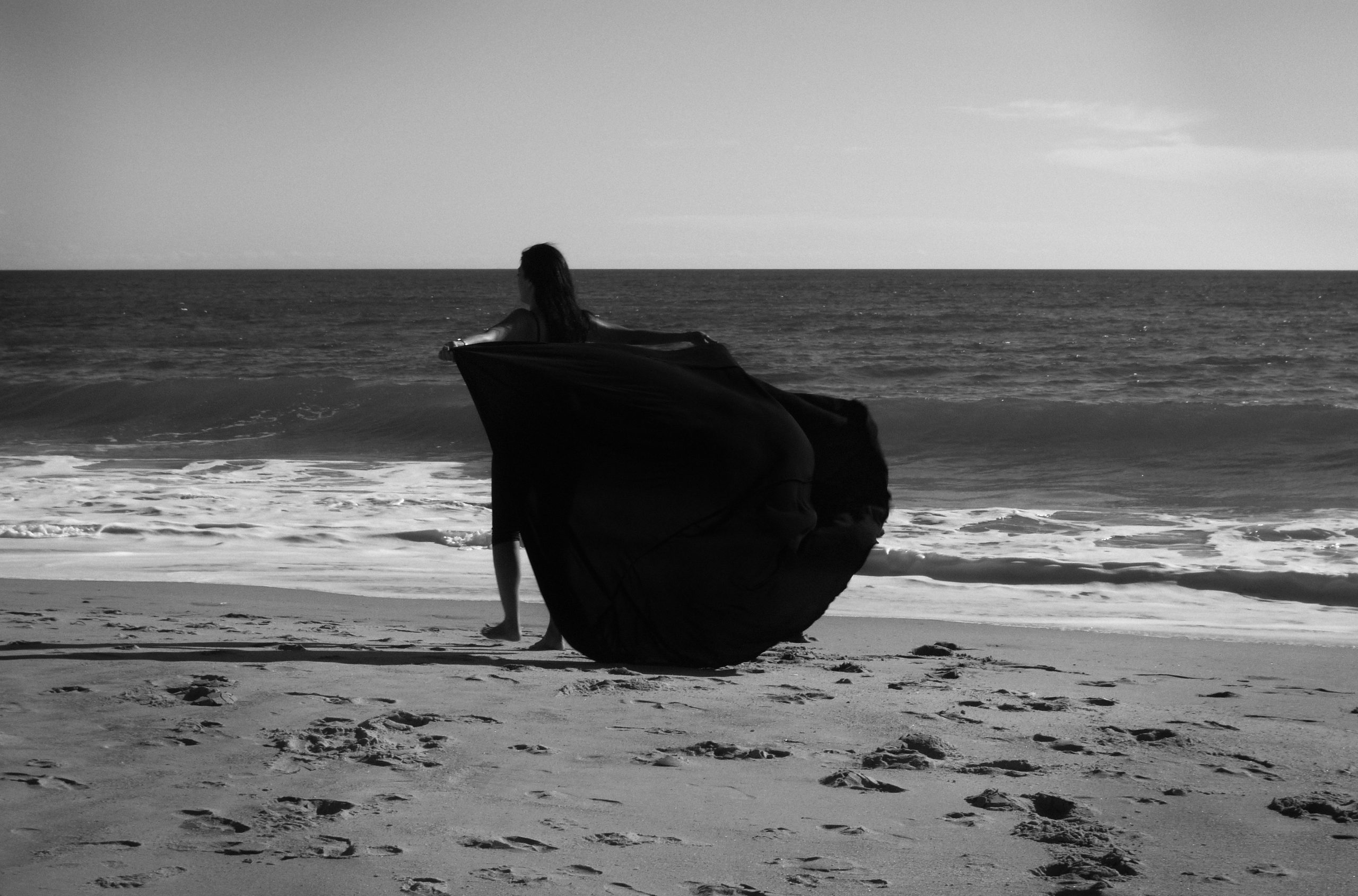
Liberation (Restless), 2010
Giclée print on Hahnemuhle German etching paper
The following article is divided into two parts. The first will address the work of the Iranian-Australian artist Nasim Nasr who has been working from 2009 to the present. The second part of the article looks at the theory and development of modern European playgrounds from the 1930s on.
The reason for bringing these two subjects together is that Nasr’s work could be viewed as analogous to a game of social chess, especially given the artist’s experience of living and working in a cross-cultural context. This analogy can be understood in the context of social play, wherein the chess board becomes the playground on which each move has a strategic significance and impact on the outcome of the game. However, an appreciation of Nasr’s work and of playgrounds shows that this perceived analogy is both constrictive and misleading. Playgrounds require a different set of skills from those required for chess and offer a creative potential insofar as one can shift or break the rules of the game. As Richard Bailey has summarised in his study of the literature around children’s play:
The image of chess is really insufficient to capture the intricacies of normal childhood social exchange. Firstly, not all social interactions are competitive, and even co-operative behaviour requires considerable mindreading skills. Secondly, for most of us, chess requires intense thought and effort, whilst children’s social exchange is carried out with consummate ease and intuition. Unlike chess players, children can adapt or break the rules; they can change identities—pawns suddenly become knights or kings— and they can even switch sides.1
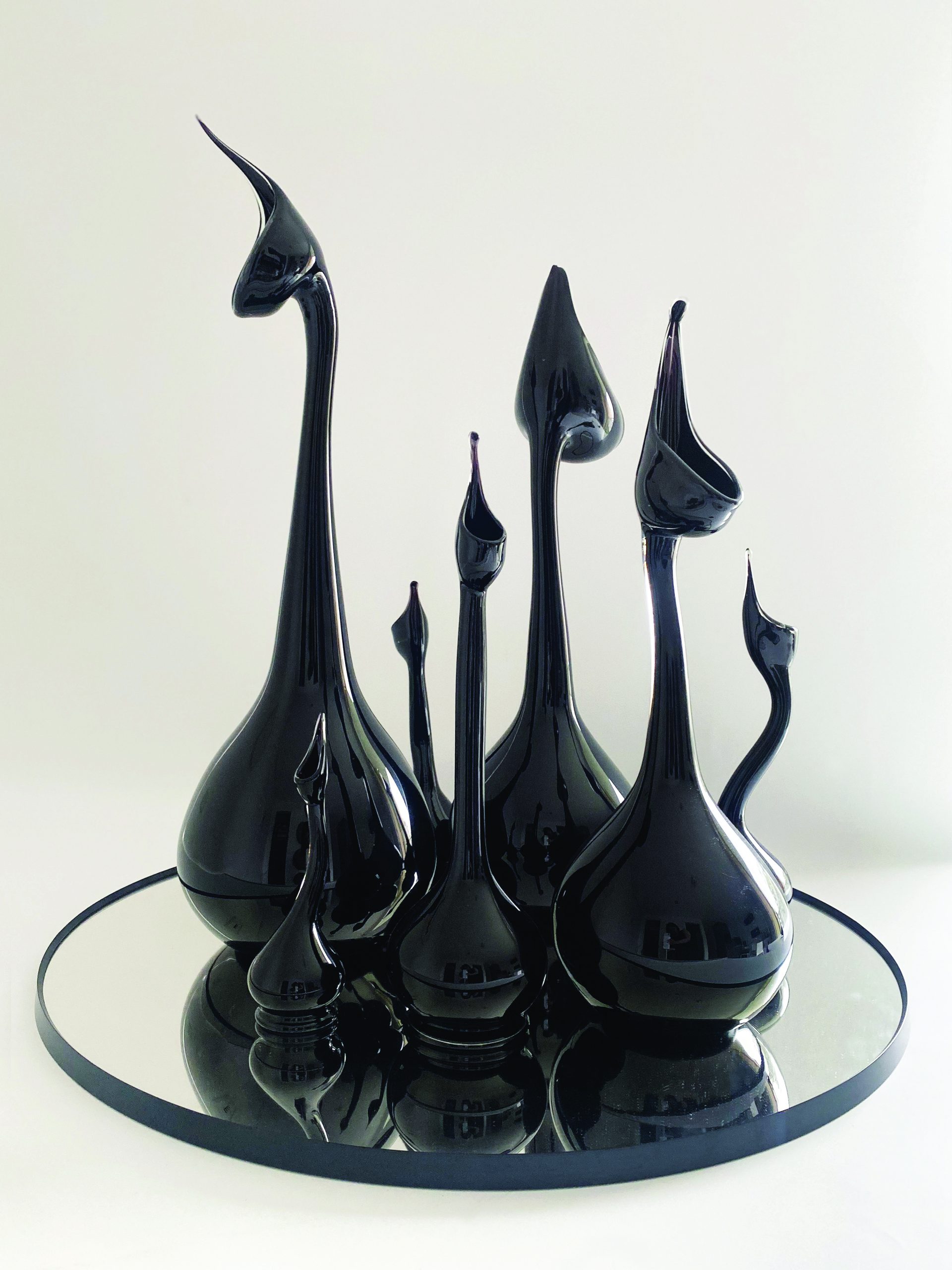
Ashkdān (Tearpots) 2, 2022
Blown glass group of seven, 95 cm (H) x 65 cm (W) x 65 cm (D)
Signed with monogram on base
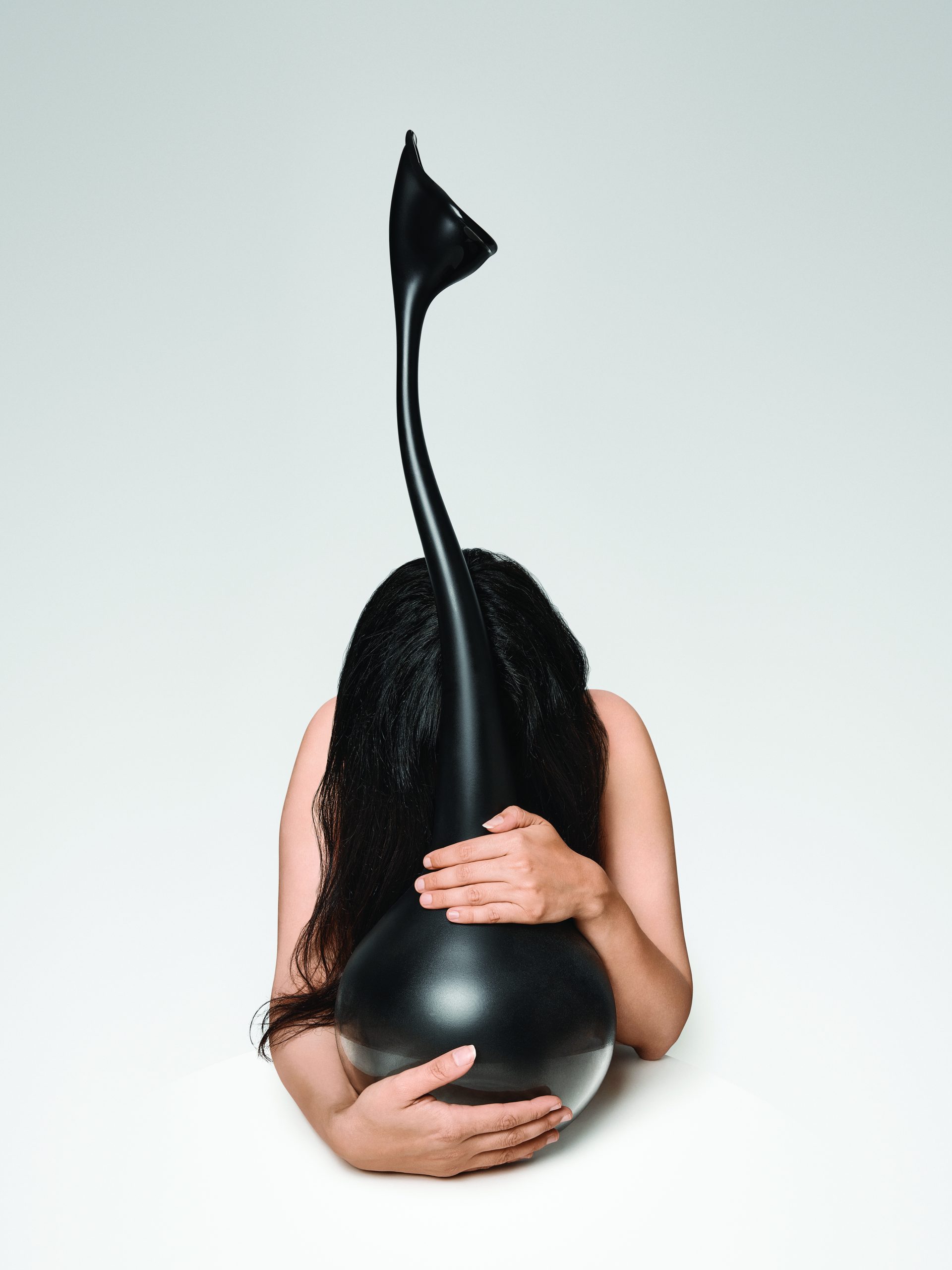
Measure of Love (Ashkdān), 2022
Archival pigment print on Hahnemühle Photorag Baryta
Part One: Nasim Nasr
Over the past year Nasim Nasr has been making a series of sculptural objects entitled Measure of Love (Ashkdān). They are a contemporary interpretation of an Iranian glassware tradition, the ‘ashkdān’or glass ‘tear-pots.’ The glass bottles have a distinct tear-shaped opening at the top which flows into a thin curvilinear neck, before expanding into a larger round body at the base. In this regard, they have a visual resemblance to the curved and attenuated neck of a swan.
The tradition of the ashkdān began under the reign of Shah Abbas I (1587-1629), notably in both the Shiraz (south-central Iran) and Isfahan (central Iran) provinces. Inspired initially by 16th-century Venetian glassware imported into the Muslim world, ashkdān were made by the women during the Qajar dynasty (1794-1925) in the 17th –18th centuries in Iran.2
Folklore has it that ashkdān were used as both rose water sprinklers and to collect the tears of wives separated from their husbands, often in times of war—hence the Persian appellation ashkdān, ‘container for tears.’ The women invented these tear-pots to measure and contain their love, pain and emotions during these separations, of being alone and in isolation, while their family members were absent. Nasr made a series of these tear-bottles as she wanted to address ‘the measure of love’ in contemporary times. As Nasr recently noted, “how can one measure the emotions and love during separation in pandemic time and battle [sic].”3
This work recalls one of Nasr’s earliest works, Unveiling the Veil, 2010, a video that captures the artist wiping eyeliner off with her tears, as if to gain better or clearer sight. Seen in the context of Islamic culture, this gesture suggests a greater symbolic meaning. It is one of her first videos and in Nasr’s words, the work “explores repressive conventions relating to gender, especially the chador, in a poetic and hypnotic way…(It) comprises close-up black-and-white footage of her rubbing her eyes so they weep, making her mascara run. This emotionally intense gesture is filled with sorrow and remorse.”4 Her eyes filled with tears express her emotions about the limitation and lack of freedom; the tears a result of separation from her past life in Iran. It is a gesture that poignantly captures that the burden of difference that lies in the hands of ‘the other’, to resolve themselves by their own disavowal. As Muslim women, they are reduced to the point where they feel that there is noone to blame but themselves.
Born in Tehran in 1984, Nasr received a BA in Graphic Design at the Tehran University of Art in February 2008. From 2006, she had begun to participate in exhibitions with drawings and paintings of female nudes, a subject not allowed in Iran. This was to be expected as it was difficult for women in Iran, as in Afghanistan, to have control over their own rights. Nasim decided to leave and by February 2009, moved to Australia. There she began her studies for a Masters of Visual Arts at the University of Newcastle in the state of New South Wales. By August, Nasim had moved to Adelaide in South Australia to increase her chances of gaining citizenship as there was less demand in comparison with the Eastern states.5
Once settled, Nasr continued her studies at the University of South Australia.
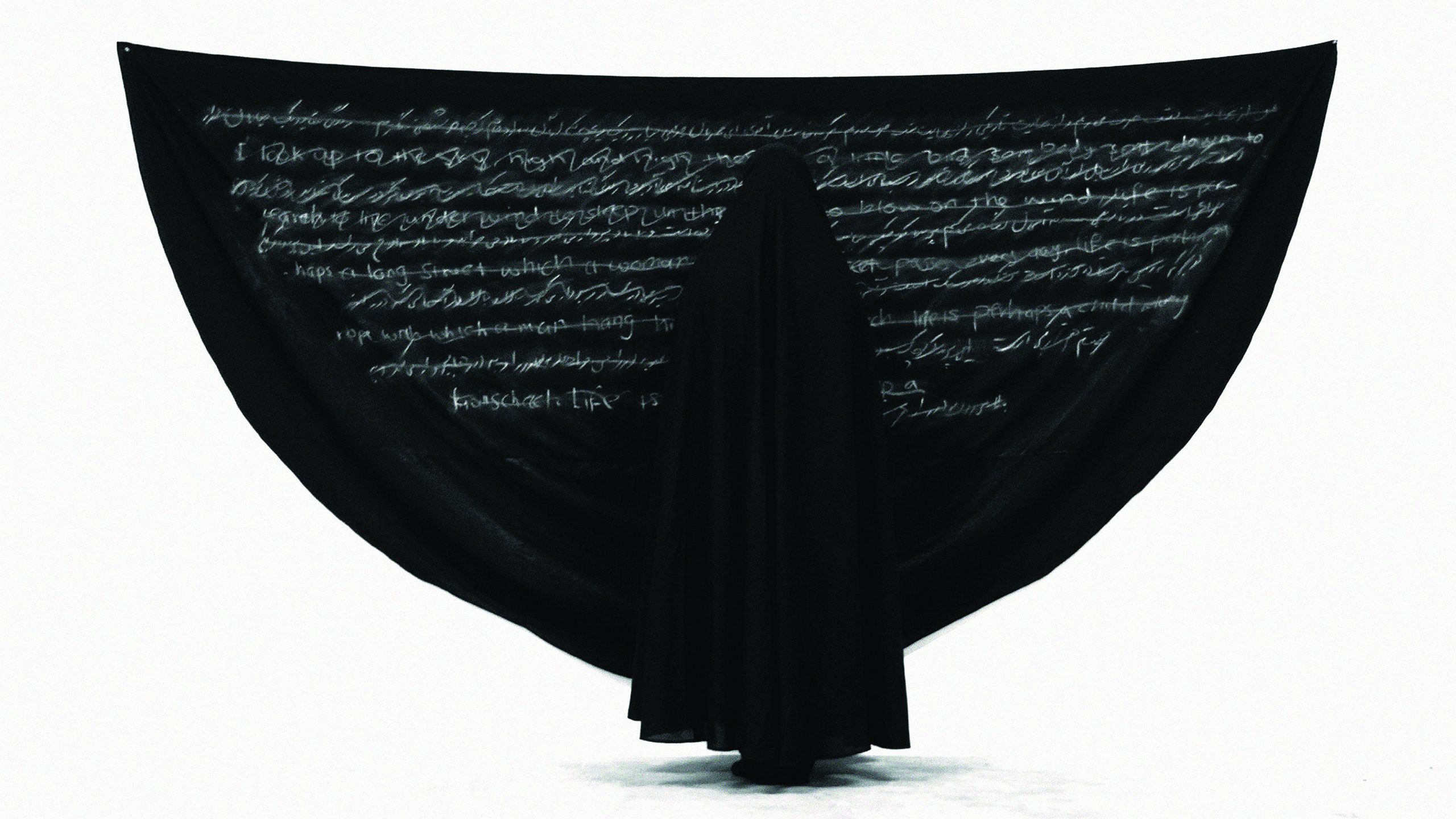
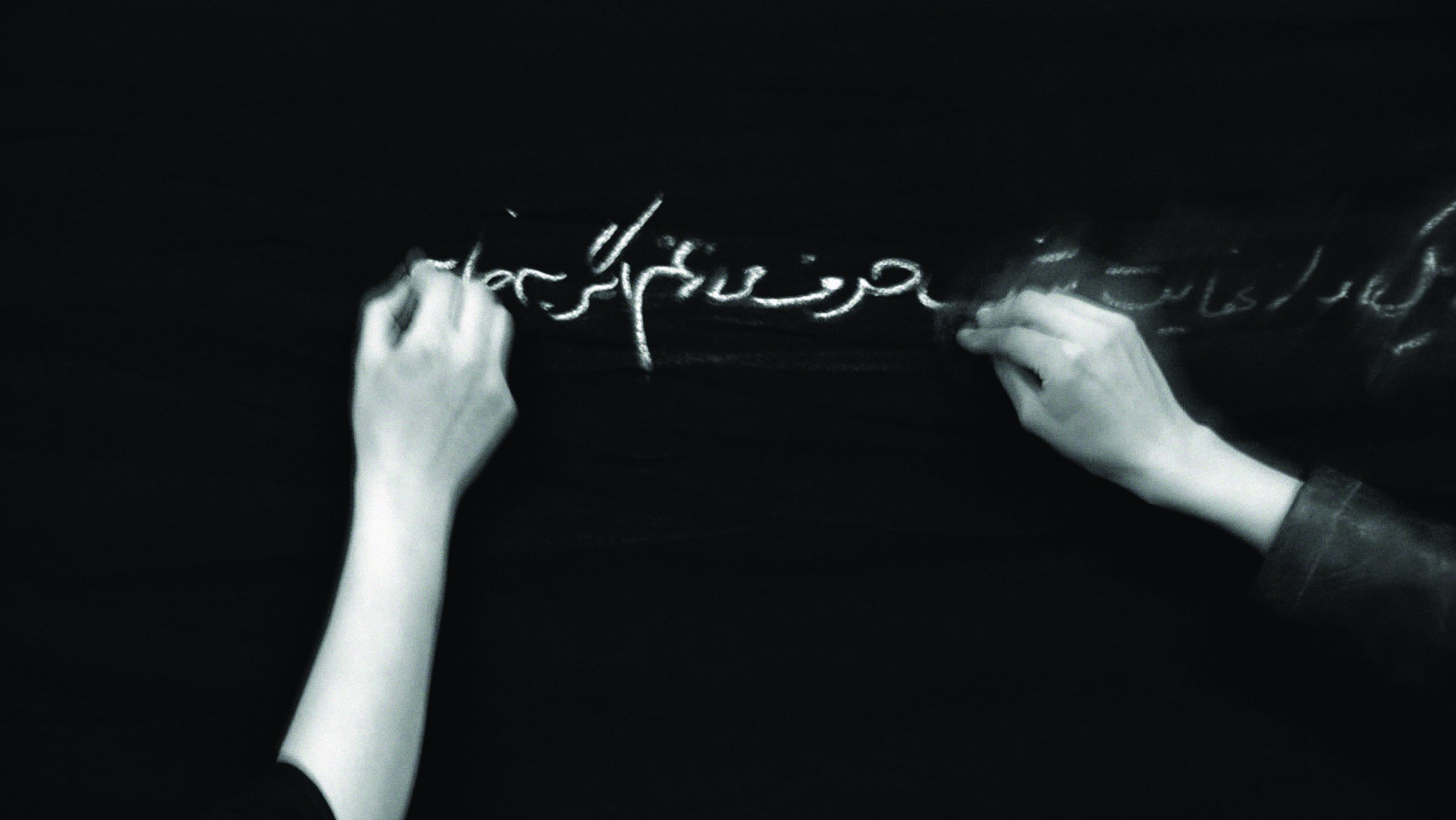
Erasure, 2010
video stills, left and right screens,
Two-channel HD video monochrome; sound
Early on in Adelaide, Nasr was taken to visit the nearby Maslin Beach. It was a nudist beach and she saw public notices at its entrance stating people were not allowed to enter wearing clothes. It was initially a shock to her, contrasting radically with the rules governing women and men in her homeland of Iran. Recognising the stark contrast between her Iranian past and the present—in particular, between the censored and veiled female form in Iran and the present openness in her newly adopted country, Australia—Nasr’s art practice took a new direction. She began to shift towards photography and video and had her first Australian exhibition at Format Gallery (a government-funded experimental art space) held from December 2009 to February 2010. She was still a student. Her exhibition Liberation was a series of photographs depicting the artist wearing a black chador taken at Maslin Beach.6 As Nasr explains: “It (was) a contrast between what I used to do back in Iran and what I am now in Australia. I was looking at how it might work to shift from nude drawing in a religiously restrictive country to covered women in this new free land—at Maslin Beach, the nude beach. I wanted it to be an ironic visual presentation.”7 Moreover, a study of Nasim’s practice serves as a catalyst towards exploring the complexity of issues facing many diasporic women from the Middle East.
In 2010, Nasr made a two-channel video, Erasure.8 It shows a woman dressed in a black chador, writing a poem in Farsi (written right to left) with white chalk on a black chador draped on a wall. Part of the poem reads in English as follows:
Life perhaps is that cloistered moment
When my gaze comes to ruin in your pupils
Wherein there lies a feeling
Which I shall blend
With the light’s impression
And the night’s perception.
In a room the size of loneliness
My heart the size of love
I will plant my hands in the garden, I will grow, I know I know,
I know...
The writing of this poem in Farsi on a chador is closely followed by the artist’s hand erasing the written text. This is closely followed by a text (presumably a translation of the original) being written in English (from left to right), overlaying the partially erased Farsi text. A final movement then follows with the woman’s hand who had initially written the poem in Farsi, trying unsuccessfully to erase the English. Coming to the end of a line of what has been written, the woman’s hand then works back over the partially erased English text. Running an erratic line through, she tries unsuccessfully to make illegible what has been written.9 The two texts in Farsi and in English are contesting each other. Full erasure never succeeds—there is always the trace of the original, however much we succeed in its overwriting and suppression.

Unveiling the Veil, 2011
video stills,
Single-channel HD video monochrome; no sound
The original text of Erasure is a famous Persian poem called Rebirth or Another Birth by Forugh Farrokhzad (1935-1967), an Iranian poet and filmmaker who had difficulties publishing her poems in Iran during her short life. Nasim recalls that she thought the poem could work perfectly for what she trying to express: “I used this poem as I always felt so connected to its words and meaning and as I was dealing with the idea of erasing memories of my past in Australia dealing with a new language.”10 In 2012, Nasr presented Women in Shadow 1, a performance through which she addressed the subject of veiling/unveiling as symbolic of issues surrounding the discrimination against Muslim women. In the performance, professional models wearing the chador with heavy makeup and high heels, parade along a catwalk over the 45 minutes of its duration.

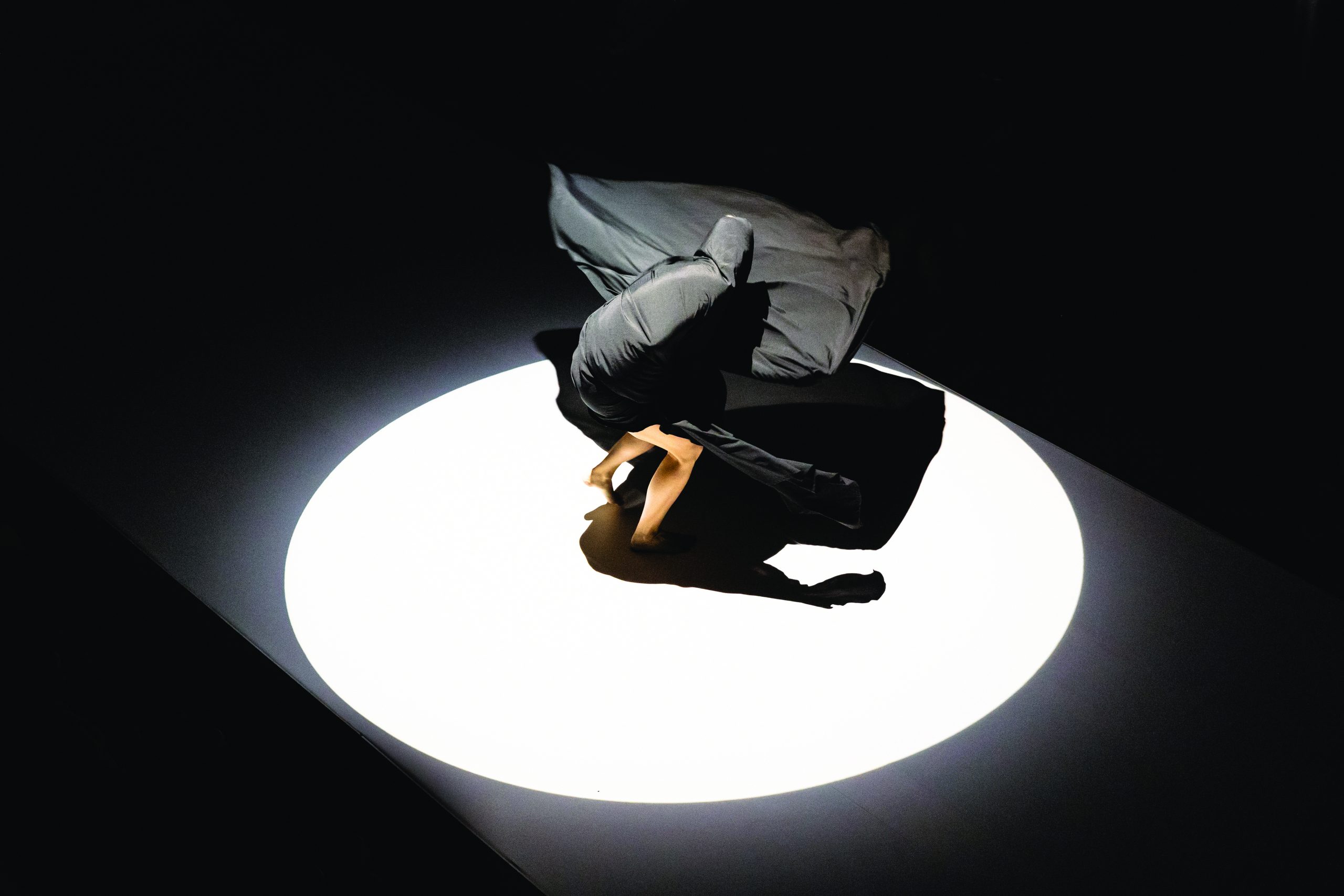
Women in Shadow II, 2018
performance stills,
Archival pigment print on Hahnemühle Photorag Baryta
The subject of invisibility/visibility is played out as the veil dissolves into the shadows. This invokes the socio-cultural invisibility of women in Islamic countries but, equally, the overexposed, commodified image of women in the West.11 This is not simply a dichotomy of the veiled or unveiled, containment or freedom, East vs. West. Rather, either way, both terms are mobilised, as if held in an oscillating counter-balance, anticipating the essential dialectic that drives Nasr’s work. Nasr’s work represents an unsettling encounter with difference—a difference that destabilises Western norms of the body as free only when it reveals itself. This institutes a politics of othering.12 Looking back, the significance of the work is its anticipation that women’s struggle for freedom from imposed constraints of identity is far from over.
The veil in Women in Shadow 1 becomes a flashpoint for the relationship between the body and knowledge, the politics of freedom grounded in the body. But the impulse to unveil is more than a desire to free the Muslim woman. Behind the desire to release (Muslim) women’s bodies from the veil is the intolerable possibility of limits. As Talal Asad contends in Formations of the Secular: Christianity, Islam, Modernity, an aggressive re-centring of discourses of the west occurred following the events on the 11 September 2001.13 This led to a renewed commitment to the values of democracy and freedom, terms believed to be exclusively affiliated with a western liberal tradition.
The preoccupation with the veiled woman is a western defense that preserves neither the object of orientalism nor the difference embodied in women’s bodies. Rather inversely, it is based and insists on the idea of a universal free subject that privileges the west. What lies at the heart of the politics of othering, in this case the fantasy of saving the Muslim woman, is recast here as the west’s desire to save itself. The veiled and unveiled activates an imagining—the possibility and impossibility of a stable “west” and the epistemic conditions of freedom, truth and knowledge which sustain it.
For Nasim Nasr, born and raised in Iran and living in Australia for the past 14 years, issues around the discrimination of gender and continuing anxiety around identity have been points of continuing focus throughout her work.14 Her work has explored, as the editorial of this journal ISSUE states, the “contested freedoms in the determination of space, what is contained within a space and who should be in this space.”15 These issues persist today, especially for women, in different ways and forms, not only within Islamic countries but globally.
Recently, the new work of Nasr extends while reflecting back on her earlier work. One of these new works is Impulse, composed of a dance-work collaboration between one male and one female each moving with and struggling against a black chador and a white chador. Like pieces on a chess board, it suggests the contrast and struggle between Nasr’s past and present.
This work also relates to her Liberation series of 2010 and back to her performance Women in Shadow 1 of 2012. The potential liberation and tension of the moving figures in relation to the chador, symbolic of identity formation, captures both the necessary and possible liberation of the figure. The dance builds, intensifying with each movement, as if capturing and exposing the layers of emotion to an uncontrollable point where they might fragment or evaporate. The movement of the figure offers a glimmer of hope that it will free itself of societal constraints defying the rules of the game and, in that moment, both define itself and be liberated.
Part Two: Playgrounds
From the turn of the last century until the 1980s, playgrounds in the Western world reflected the changing status of children within society and its impact on urban planning, architecture and art. Playgrounds were developed as defined and controlled spaces for children. Moreover, the element of play belongs mostly to an aesthetic impulse that corresponds with the impulse to create an orderly form which animates play. The connection between playgrounds and art is characterised by Gabriela Burkhalter when she writes:
“The history of play sculpture and playgrounds in general can be understood as yet another overlooked chapter of modernism. Connecting play, art, education and public space, it finds itself at the centre of some of the 20th century’s most pressing issues. Playgrounds became lively, interactive and imaginative public spaces.”16 The first playgrounds were built at the end of the 19th century, when child labour had begun to be outlawed and children’s leisure and security became a concern. The emergence of the welfare state brought children’s creativity into focus. Play activities were designed for public spaces and with children’s needs in mind.
During the inter-war period, the Dutch historian Johan Huizinga (1872-1945) wrote Homo Ludens: A Study of the Play Element in Culture in which he proposed that all play moves and has its being within a playground marked off beforehand either materially or imaginatively.17 Just as there is no formal difference between play and ritual, so the `consecrated place’ cannot be formally distinguished from the playground. Inside the playground a special order reigns absolute. There is an affinity between play and order. It brings a limited, if temporary, perfection into an imperfect and unpredictable world or haphazard way of daily life.
Huizinga also argues that there is a fusion of play and poetry. He suggests that the function of the poet is fixed in the play-sphere where it was born. Poesis is a play-function and proceeds within the playground of the mind, in a world of its own which the mind has created for it. It lies beyond seriousness, in the region of dream, enchantment, ecstasy and laughter. It is bound by rules that must be consciously entered into. “It proceeds within its own proper boundaries of time and space according to fixed rules and in an orderly manner.”18 There things have a very different physiognomy from the one they wear in ‘ordinary life’ and are bound by ties other than those of logic and causality. The capacity of poetry and play is its potential for unlimited transformation or, in a Nietzschean sense, the way that being is undermined by becoming. Play contains an intrinsic paradox that teases us simultaneously with seriousness and playfulness, flow and structure, liberty and order. Such is its undoing, for according to Huizinga, as soon as we enter the play-mood, respect for the rules of play, for its order and form, must be zealously maintained or else we risk being brutally thrust from its sphere.
Roger Caillois (1913-1978), one of the founders of the College of Sociology in Paris along with Georges Bataille in the 1930’s, would later dispute Huizinga’s conception of play in his book Man, Play and Games.19 Caillois redefined play as an activity connected with no material interest—no profit can be gained by it. It proceeds within its own proper boundaries of time and space according to fixed rules and in an orderly manner. It promotes the formation of social groupings which tend to surround themselves with secrecy and to stress their difference from the common world by disguise or other means. Caillois argues that play and games give us an appreciation of the patterns and themes of a culture. An art work, installation or performance can tease out material differences and commonalities as symbolic of social life and exchange.
For a long time, artists and the avant-garde have embraced playgrounds as a sphere of experimentation and place of freedom for children. With this potential, the playground became a laboratory of experimentation, a defined and yet liberating ground on which contestation and freedom to break the boundaries has always been a latent potential.
Artists in the early days of the Soviet Union in the 1920s engaged closely with all spheres of education and the arts, most especially under the short-lived guidance of Anatoly Lunacharsky, at one time the People’s Commissariat for Education (Narkompros). By the late 1920s such foresight disappeared from government cultural policy and by the early 1930s, the avant-garde was closed down and eradicated by Stalin’s regime. As with elsewhere in Eastern Europe, playgrounds became part of the State apparatus. One such case was the mass distribution of climbing frame equipment on the playground, part of which were rocket-style climbing frames in the 1950s. At the time, a large number of children dreamed of being astronauts. The astronauts Yuri Gagarin and Valentina Tereshkova became heroes and role models for millions of children and adolescents and their portraits were a common attribute in every school. Playgrounds became a symbol of State ideological propaganda and helped in the construction of an image of a strong communist party. After perestroika and the complete collapse of communism by the beginning of the 1990s, playgrounds began to change again and slowly were more liberated from ideological determinism.
In Western Europe, the first adventure playground opened in Denmark in 1943, and between the 1950s and 1970s other activist initiatives and methods to encourage children’s play became widespread. In the late 1940s, the artist and architect, Constant Nieuwenhuys (1920-2005), emphasised collective creativity. He was at the time, a member of CoBrA, a movement which he had co-founded with Danish, Belgian and Dutch dissident surrealists. They advocated free and spontaneous art and, together with Christian Dotremont, Eph Noiret, Corneille, Karel Appel and Asger Jorn, published La cause était entendue (The cause was heard) in 1948. After his CoBrA years, Constant became interested in the influence of the built-up environment on human activity; his abstract constructions from those years can be seen as architectural or urban planning studies for the spatial application of colour. He called for a movement towards nomadism and the generalisation of playful behaviour.
In the early 1950’s, Constant began collaboration with the group Team X, most notably his fellow Dutchman Aldo vVan Eyck (1918-1999). Born in Driebergen (the Netherlands), Van Eyck grew up in London between 1919 and 1935 and then studied architecture at the Eidgenössische Technische Hochschule in Zurich from 1938 to 1942. During these years, he became acquainted with the international avant-garde and remained in Zurich until the war ended. In 1946, Van Eyck moved to Amsterdam and began working for the urban development division of the city’s Department of Public Works under Cornelis van Eesteren and Jakoba H. Mulder.
Van Eesteren (1897-1988) was chief architect of Amsterdam’s Urban Development Section since 1929, after having trained in Amsterdam and Rotterdam. During this time, he was influenced by the Bauhaus and by Van Doesburg and became involved in the Dutch De Stijl movement and their theory of neoplasticism. Following his training, he concentrated on urban planning at the Institut d’urbanisme de l’université de Paris (IUUP) at the Sorbonne in Paris.
From 1930 until 1947, Van Eesteren was chairman of the Congress International d’Architecture Moderne (CIAM). In 1933 he was asked to prepare a number of analytical studies of cities for the main meeting of CIAM that was planned for Moscow. The concept for these studies was the ‘Functional City,’ a concept that had come to dominate CIAM thinking after their third conference, held in Brussels in 1930. Le Corbusier had exhibited his ideas for the ideal city, the Ville Contemporaine in the 1920s, and during the early 1930s, began work on the Ville Radieuse (Radiant City) as a blueprint of social reform. The Ville Radieuse was a linear city based upon the abstract shape of the human body with head, spine, arms and legs. The design maintained the idea of highrise housing blocks, free circulation and abundant green spaces proposed in his earlier work. These were based in part on urban studies undertaken by CIAM in the 1930s.
At a meeting in Zurich in 1931, CIAM members—Le Corbusier, Walter Gropius, Siegfried Giedion, Rudolf Steiger and Werner M. Moser—discussed with Van Eesteren the importance of solar orientation in governing the directional positioning of low-cost housing on a given site. In CIAM’s Athens Charter of 1933, Le Corbusier opted for a massive rebuilding of cities in which the functions of labour, living, and leisure are spatially segregated, and street life was reduced to traffic flows. Van Eesteren embraced a strict functional separation of housing, work, traffic, leisure and nature, and envisaged highrise blocks and huge traffic arteries to replace traditional cities.
In postwar Amsterdam, Van Eesteren together with the engineer Theodor Karel Van Lohuizen developed the the city’s zoning plans—the Amsterdam Expansion Plan—that would predict overall future development in the city, including population development, the use of land, buildings and transport. They relied upon the rational methods being promoted by CIAM at that time, which sought to use statistical information for designing zone uses rather than designing them in any detail. The town planning section of the city of Amsterdam wanted to have a playground in each neighbourhood of the city of which parts had been destroyed during the war. However, although the importance of leisure and children’s play was recognised by Van Eesteren and members of CIAM, they imagined leisure in ‘idealised settings,’ away from the houses of the children.
Meanwhile, Constant had begun to focus on construction and experimented with sculpture, inspired by neoplasticism and then neo-Constructivism. From 1954 until 1956, Constant collaborated with Nicolas Schöffer, creating several spatio-dynamic projects, and this led to an introduction to the Espace group, of which Schöffer was a member, founded (in 1951) by André Bloc and Felix Del Marle. While working as an engineer Bloc had become interested in architecture. Through magazines he founded and led, notably L’Architecture d’aujourd’hui and Art d’aujourd’hui, he was an ardent supporter of a renewal of the relationship between art and architecture in reaction to Le Corbusier. While Constant participated with Dutch members in meetings of CIAM, he was personally drawn to the Espace group who advocated a new synthesis of the arts in France. They viewed architecture and art (painting and sculpture) as a social phenomenon and integrated constructivism and Neoplasticism in city planning and the social atmosphere.20
In 1956, Constant joined the International Movement for an Imaginist Bauhaus, which Asger Jorn had founded as a reaction against the International Style of Le Corbusier. That same year, he abandoned painting to exclusively dedicate himself for 18 years to New Babylon, a radical illustration of “unitary urbanism” by Guy de Debord. He also participated in the founding of the Situationist International in 1957, who saw play as essential to the ontological freedom of the human being. Expanding on Huizinga’s concept of play, Constant along with other leading SI members, notably Guy de Debord and Asger Jorn, believed that the ability to play had been lost—a phenomenon that could be directly attributed to a passivity in the face of the spectacle. To redress this, they proposed that homo ludens become itself a “way of life” that could respond to this human need for play, as well as “for adventure, for mobility, as well as the conditions that facilitate the free creation of his own life.”21 Constant argued that, in opposition to a postwar commodity culture, play should be thought of as a guiding ideal. He wrote that the liberation of man’s ludic potential is an essential part of the liberation of the social being.22 Similarly, Van Eyck viewed architecture very differently from Van Eesteren and CIAM, believing it should aim at creating places that fostered dialogue and stimulated community life in which children take part. At that time the contrived playgrounds were generally isolated places. Van Eyck’s playgrounds were never fenced. Contrary to the program of CIAM that proposed a massive rebuilding of the city, Van Eyck used existing and ignored spots in the neighbourhoods of the cities to create places for social gathering and children’s play. He developed an architecture of the in-between realm in which there were no sharp boundaries that separated the playground from the rest of the city.23
The significance of Van Eyck extends beyond his contribution to Dutch culture to that of the architectural planning of cities, especially in postwar Europe, in which he advocated dialogue and community. This was exceptional in the 1950s and 1960s and encouraged by the citizens of Amsterdam, who had explicitly asked for a playground in their neighbourhood, Van Eyck transformed over 700 public playgrounds designs located in parks, squares, and derelict sites in Holland over the course of the next 30 years.24
Conclusion
As I have explored, playgrounds may be seen as being somewhat analogous to a chessboard, but they are not. The latter is over-determined by the rules of the game while the former, if seen within a progressive tradition, are quite the opposite.
If chess is analogous to Nasr’s work, it is only in recognising the strategic significance and the potential impact of each move on the outcome of the game. That is chess, like social customs, has strict rules and conventions. However, this where the analogy ends. Rather, we see in Nasr’s work that as a woman and a Muslim, she is faced with social conventions both in the Middle East and in the West, in particular, Australia. That is, women have a place but no position, nor voice. They are virtually invisible. What Nasr seeks is to play with these social conventions, if only then to break them. Her art seeks to deconstruct the rules of the game, to contest or break with these rules, offering a perspective from her point of view as both a woman and a Muslim.
Playgrounds, on the other hand, embody the ludic potential of people, a potential that was seen in postwar Europe as liberating man from the growing oppression of a commodity-driven culture. The collaboration between Constant and Van Eyck brought theory and practice together and the progressive history of postwar reconstruction in Amsterdam is indebted to their work.
The practice of Nasr and of Constant and Van Eyck together challenge any analogy between chess and playgrounds. Their work deconstructs the dominant social conventions and world of unfreedom where one can only play according to the rules of the game. They recognised that while playgrounds are spaces of social interaction, these spaces also embody a creative potential latent within social exchange. This creative potential is why playgrounds can be defined as laboratories of experimentation and places of freedom.
All photos courtesy Nasim Nasr and Mars Gallery, Melbourne
Footnotes
1 Bailey 165
2 Before then, the Iranian Safavid dynasty (1501–1722) had been a high point for the art of the book and architecture as well as ceramics, metal, glass, and gardens. During this time the bottles were used to hold wine or other beverages or to adorn wall niches.
3 Artist’s correspondence with the author, 9 January 2023.
4 ibid.
5 Australian Citizenship was based on a point system at the time. A person could receive 25 points in the state of South Australia but only 15 points in the state of New South Wales. The number of points depended also on age, professional skills and proficiency in English.
6 Akira and Tomoko Nakayama, who lived in Adelaide, came to the exhibition and bought the entire series of work, which was a welcome economic lift and gave Nasr greater confidence, especially in her new direction.
7 op.cit. correspondence with the author.
8 Erasure (2010) can be seen on Vimeo.
9 Both Farsi and Arabic are written right to left.
10 op.cit. correspondence with the author.
11 There are different Islamic veils, including the Burka that covers the woman’s face, the Niqab, that shows a woman’s eyes and the Chador that shows her face. Chador comes from the Turkish chadir meaning tent, the home of one who is not otherwise allowed to be in the world of men. As Çagla Hadimioglu notes: “The chador is thus conceptualised as a mobile home that facilitates a woman’s movement around the city and her dealings with men. It essentially describes an extended boundary that assures that she always occupies a private space.” See Hadimioglu 19. In the late sixties and seventies, wearing the chador became a form of protest against the Shah and western cultural contamination. In 1983, the Ayatolla instituted the Islamic Dress Code, enforcing the wearing of the chador. 12 We are reminded of Orientalism (1978) by Edward Said who transforms the meaning of the term revealing it as an expression of power relations and western style for dominating, restructuring and, as such, having authority over the Orient. It implies that the ideas of western societies were more developed and superior, involving specific patronising acts and opinions that came from mostly Western Europe and North America projected upon Middle Eastern, Asian, and North African Societies.
12 We are reminded of Orientalism (1978) by Edward Said who transforms the meaning of the term revealing it as an expression of power relations and western style for dominating, restructuring and, as such, having authority over the Orient. It implies that the ideas of western societies were more developed and superior, involving specific patronising acts and opinions that came from mostly Western Europe and North America projected upon Middle Eastern, Asian, and North African Societies.
13 Asad, 2003.
14 I wish to thank the artist and Alan Cruickshank for their correspondence with me about Nasr’s work.
15 See the Editorial by Venka Purushothaman.
16 Burkhalter, 2014. See also De Donno et al (ed), 2017. This book is divided into three sections: Eurovision, Performativity and Playgrounds, exploring the relationship between art and game. The playground or sports field is seen as a place to experiment with the relationship between the body and space, a physical territory capable of hosting the production of new mental scenarios. A playground is a social space, a way of experiencing the city.
17 Huizinga, 1938.
18 ibid 26.
19 Caillois, 1958
20 Artists, architects and city planners such as István Beöthy, Sonia Delaunay, Jean Dewasne, Jean Gorin, Stephen Gilbert, Félix Del Marle, Edgard Pillet, Ionel Schein, Nicolas Schöffer, Pierre Szekely and Victor Vasarely joined the group.
21 Nieuwenhuys, New Babylon, 1958. See New Babylon: a nomadic town, catalogue, 1974.
22 In 1953 Constant published in collaboration with Van Eyck, Voor een Spatiaal Colorisme in which they called for spatial colourism, reaffirming the importance of colour in architecture (as had De Stijl). Constant’s utopian project for a planetary city preceded Yona Friedman’s research and radical groups such as Archigram, would become an iconic reference in the architectural imagination of the 20th century.
23 These interconnections between art, the playground and public space continued in the Netherlands. One instance was the Amsterdam-based Eventstructure Research Group (ERG), co-founded by Jeffrey Shaw with Theo Botschuijver and Sean Wellesley-Miller. In 1969, they performed six unannounced events in the urban environment of Amsterdam, using inflatable objects with which people could play. One of these events was Waterwalk, a tetrahedron (a triangular pyramid composed of four triangular faces) made of plastic, floating on a local lake that people could climb into. Once inside, the tetrahedron was closed by a waterproof zipper enabling people to walk through it and across the lake. These events were discussed by me in ‘Play, in spite of, Play,’ 2020.
24 See De Roode et al (ed), 2002
References
Asad,Talal. Formations of the Secular: Christianity, Islam, Modernity. Stanford University Press, 2003.
Bailey, Richard. “Playing Social Chess: Children’s play and social intelligence.” Early Years: An International Research Journal, vol.22, No.2, 2002, p.165.
Burkhalter, Gabriela. “When play got serious: Etc. Essay: Art and the playground.” TATE ETC, 18 July 2014, https://www.tate.org.uk/tate-etc/issue-31-summer-2014/when-play-got-serious
Caillois, Roger. Man, Play and Games. Librairie Gallimard, 1958. (Eng. ed. translated by Meyer Barash, The Free Press of Glencoe, 1961).
De Donno, E., Ariaudo F. and Pucci L. (ed). Sportification: Eurovisions, Performativity and Playgrounds 1965-99. Viaindustriae, Foligno, 2017.
De Roode, Ingeborg and Lefaivre, Liane (ed). Aldo van Eyck: The Playgrounds and the City. Stedlijk Museum, 2002.
Hadimioglu, C. “Black Tents.” Thresholds, vol. 22, Spring, 2001, pp. 18-25.
Huizinga, Johan. Homo Ludens: A Study of the Play-Element in Culture, 1938 (Eng. ed. transl. by R.F.C. Hull, Routledge & K. Paul, 1949).
Lunetta, Matteo.”Leisure Water Uses as Urban Commons: A Play Element in Metropolitan Brussels.” issuu, 22 Jan 2021.
Merewether, Charles. “Play, in spite of, Play.” Tropical Lab Singapore, LASALLE College of the Arts, 2020, https://www.tropicallabpresents.com/charles-mereweather
Nasr, Nasim. “Erasure.” Vimeo, uploaded by Logan Macdonald, 2009, https://vimeo.com/95712410
Nieuwenhuys, Constant. New Babylon: a nomadic town, catalogue published by the Haags Gemeetenmuseum, The Hague, 1974, https://www.notbored.org/new-babylon.html
Nieuwenhuys, Constant, and Van Eyck, Aldo. Voor een Spatiaal Colorisme. G.A. Verweij te Schiedam, 1953.
Said, Edward. Orientalism. Pantheon, 1978.
Essays
The Spirit of Play as the Seed of Change
This essay is based more on my experiences as an artist experimenting with producing artworks and observing the development of Indonesian art, than on theories or theoretical explanations of creation. My experiment was based on a sense of play, trial and error, and ‘madness,’ practised in the context of resistance to the establishment, and as such, strongly opposed by established artists at the time.
As an art student, I did not have strong drawing skills. However, I did not give up because I believe art is not based only on good craftsmanship. I believe that ideas are quite important in the creation of art, and they do not come from drawing skills.
According to my seniors and teachers, an artist’s hand is similar to a seismograph needle1; it can show the vibration of the artist’s emotions and feelings while creating works of art. An artist’s hand creates strokes that authentically represent the artist’s emotions, feelings, and soul.
What about themes, colour schemes, and critical approaches to presenting the painted objects? Is it all based solely on feelings? Is it true that an artist’s intelligence and reason are irrelevant? What about ideologies, concepts, and mediums?
It is my argument that the idea of the artist’s hand as a seismograph does not exclude the need for the artist’s intellect. The artist’s hand as a seismograph manifests the intellect, feelings, emotions, techniques and the whole being of the artist’s experience and life authentically manifested on the canvas. Teachers, senior artists and other students consider that reason and critical analysis are not part of creation but part of criticism or writing. In my opinion, I do believe that intellect, feelings, emotions, techniques and the whole being of the artist’s experience and life are authentically part of creation. Ultimately, what we should question is why the artist’s hand is privileged here in manifesting the ‘visible soul’, a question raised by artists from the The Indonesian New Art Movement (Gerakan Seni Rupa Baru, or GSRB).
We, from the New Art Movement, see that the teachings about the soul appear to be represented by the hands that make art, clearly setting aside ideas and concepts in the creation of works of art. Senior artists consider that emotions and feelings are more important than thoughts, ideas and concepts. In hindsight, only after we understood the ideology of modernism and postmodernism do we understand that prioritising emotions, feelings, and expressions is a representation of the ideology of modernism. However, the seniors did not actually understand the ideology of modernism correctly.
These questions compelled me to reconsider the place of reason in the understanding that humans are primarily composed of both reason and feelings. Reason encourages a critical approach to seeing and placing creation in its social context. Emotions and feelings do not have to be expressed through strokes only but can be noticeable through colour selection, composition, a playful creation process, and other elements.
I was required to attend painting classes in 1973. I used a ruler and a compass to paint flat colours. I was inspired to paint by the concept of space and the play of optical effects. I did not use any texture or brushstroke in my paintings. Fortunately, the lecturer who taught the painting class, Fadjar Sidik, was an abstract painter. He liked and approved of my painting style. Fadjar Sidik described my painting style as ‘geometric’.
In FX Harsono: A Monograph (FX Harsono: sebuah monografi), Hendro Wiyanto, an art critic, curator and writer, wrote about my work: “The canvasses’ surfaces are divided with a ruler and measured with a compass, then the faces are evenly coloured, and the compositions are orderly and neatly designed, sometimes implying a double perspective on space. The paintings appear playful and depart from the mimetic art tradition of creating the illusion of depth of space. The flat surface has evolved into an independent subject, rather than merely a backdrop for presenting objects or representing specific images.”2
At the time, teachers and seniors, who still adhered to modernist ideologies that highly valued craftsmanship, dominated educational institutions. Artworks must be original because artists were viewed as geniuses who should not be interfered with. The work produced should have an aesthetic aura because the artist’s soul is considered to be a crucial component of creation. In contrast, I believe that ideas, concepts, and playful ways of creating art are valid as creation ideologies; this was not in line with the teachers’ ideology, who were also senior artists. As a result, they rejected my concept.
Dimensi 3 Bulatan Dalam Ruang dan Gerak Garis is related to the primacy of ideas and playful ways of creating; it serves as an entry point to discuss ideas of playfulness and concept. It shows the process of creation from my rejecting the statement “the hand as a seismograph needle,” and developing the idea through several years of experimentation that led to the work, Space 74 no. 4 (Ruang 74 no. 4).
Indonesian Identity
In 1972, a debate erupted in Indonesia’s largest newspaper, KOMPAS, between Sindoesoedarsono Soedjojono, a painter, and Oesman Effendi, a painter and writer. Oesman Effendi declared there was no such thing as Indonesian fine art whereas Soedjojono claimed that Indonesian identity was present in the populist spirit that inspired the creation of the painting.
Oesman Effendi’s criticism stemmed from his observation that all media, painting creation processes, and theories used to critique art originate from the West. We found this polemic to be a hot topic of debate. To us students, this topic became a pivotal question for us to think about the identity of art in the context of Indonesian culture.

Dimensi 3 Bulatan Dalam Ruang dan Gerak Garis
(Dimensions of 3 Circles in Space and Line Motion), 1972
oil on canvas, 60 x 60 cm.
Photo: Courtesy of FX Harsono
“How can art present an Indonesian identity?” was the starting point for our experiments. We also examined the medium, the artistic process, and the theme. The educational framework and resources we used came from the institutions where we were studying.
The education system was based on a very limited discourse on European modern art and the lecturer’s experience as an autodidact artist. There was no room for exploration or experimentation. What the teachers said was absolute truth that was inviolable. Drawing skills and craftsmanship techniques were highly emphasised. Theories were subordinated to the practice of creation. The importance of drawing skills and craftsmanship techniques is foregrounded. Practice is prioritised over theory.
Teaching materials derived from European and American modern art theories were not taught thoroughly, resulting in a superficial understanding of them. As students, we were dissatisfied because we realised we were not receiving a proper and good education to be artists.
The dissatisfaction and the thirst for finding our Indonesian identity drove us—Bonyong Munni Ardhi, Siti Adiyati, Nanik Mirna and myself—to experiment. The spirit of play was essentially a form of resistance to the dominance of Western-style education, which shackled creative freedom. In that freedom, I discovered the ability to think critically about the search for identity, theme selection, and the creative process. The spirit of play and ‘madness’ fosters freedom, which cultivates the courage to break the rules of Western-centred creation.
Moreover, I started to get restless because I felt that the existing forms of work and creative processes were disconnected from social issues. This restlessness prompted me to begin experimenting in the spirit of play. I combined found objects with geometric shapes.
In 1974, I created a piece entitled Space 74 no. 4 (Ruang 74 No. 4), 1974. It was a flat red square canvas 100 x 100 cm with a concave in the centre of an eight-centimetre depth. I placed an object in the centre of the circle, a toy known at the time as Nik-Nok or Clackers. This toy is currently gaining popularity under the names Lato-Lato or Ethek-Ethek.
I also created a smaller work titled Space 74 no.5 (Ruang 74 No. 5), 1974. It was an 80 x 80 cm canvas divided in two, with the top flat and the bottom wavy, on which I placed a brightly coloured trumpet made of zinc and strings.
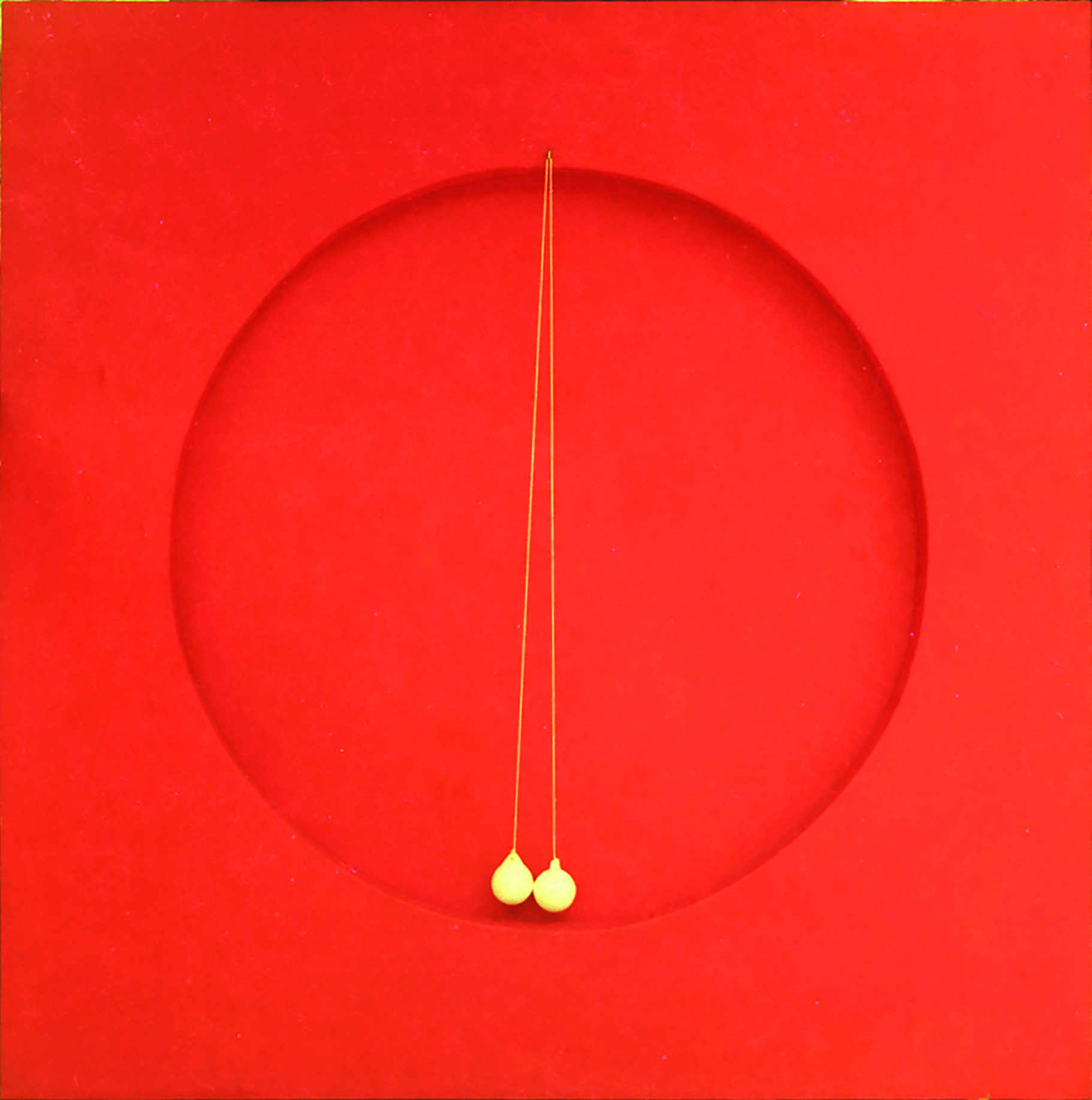
Space 74 no. 4 (Ruang 74, No. 4), 1974
acrylic on canvas, crackle toys, 100 x 100 cm.
Photo: Courtesy of FX Harsono.
Both paintings were on display in 1974 at the first (Pameran Besar Seni Lukis Indonesia),Great Exhibition of Indonesian Painting3 organised by the Jakarta Arts Council (Dewan Kesenian Jakarta), which took place at Taman Ismail Marzuki. My works, as well as the work of several other young artists, were presented with a spirit of playfulness and mischievous experimentation. During the award-judging process, our works received frank and harsh criticism from the jury:
“It is an attempt to experiment with what is ‘new’ and ‘strange’, which can only be interpreted as trial and error, a gimmick, or evidence of a scarcity of ideas and creativity.”
Furthermore, it was assumed that originality, as unquestionably essential for artists, means that the artist’s work must be unique, so using found objects was considered a violation of originality.
The debate over how ‘originality’ was defined in the 1970s is worth unpacking further. For example, can originality be located in new ideas, or new ways of using materials in art? Originality remains one of the most fundamental touchstones of Modernism in ‘Western art’ and yet is still relevant today as a criterion for assessing art.
The “soul that appears” is considered to represent the artist’s self and it is there that originality appears. Meanwhile, for the artists of the New Art Movement (GSRB), ideas and concepts are considered as the basis of creation. Originality must be born at the hands of artists. There is a distinction in the meaning of originality between modernist artists and younger artists. Found objects do not represent originality but under the new art, they are presented with and given new meaning. For modernist artists, this method is considered not to reflect originality.
We responded quickly to the criticism and we were backed by several other artists. Then we started a petition stating that artists should be free to experiment in any way they want. The petition became known as Black December because it occurred in December 1974. We distributed the petition and made a flower wreath similar to those given to the deceased, with the words (in Indonesian) “Condolences on the Death of Indonesian Painting” written on it. The wreath was then presented during the presentation of awards to the five selected painters.4

Black December wreath 1974, from young artists.
Photo: Bambang Bujonio / Tempo Magazine

The first exhibition of New Art Movement, 1975, at Taman Ismail Marzuki. Photo: Sri Atmo, 1975, Courtesy of FX Harsono
New Art Movement (Gerakan Seni Rupa Baru, or GSRB)
The jury immediately responded in anger. Some of the jury members and awardees were from our campus, STSRI ‘ASRI’.5 Following the exhibition, our teachers summoned us and put us on ‘trial’. We were kicked off campus because our actions were seen as political activism. During the New Order era, students and citizens were prohibited from engaging in any political activity. This prohibition was known as “depoliticisation”.
The dismissal of four STSRI ‘ASRI’ students, combined with the Black December statement, prompted us—six “ASRI” students from Yogyakarta, four young artists from the ITB (Bandung Institute of Technology), and one young artist from Jakarta—to form the New Art Movement (GSRB). In August 1975, the GSRB’s eleven members held our first exhibition at Taman Ismail Marzuki in Jakarta. Installations, found objects, and non-lyrical two-dimensional works depicting everyday objects were among the works inspired by the concepts of play and experimentation that we displayed.
The GSRB exhibition in 1975 drew harsh criticism from critics. They could not identify the works using their modern art references. They claimed that the artworks in the exhibition were vandalism, pornographic, or disrespectful of Indonesian culture. We did, however, have the support of young critics. As a result, a debate erupted in the media at the time.
We did not know what to call our creations, so we just called them “new art.” The process of creation and the forms of our works, according to Sanento Yuliman, a lecturer and art critic based in Bandung, were indeed novel and distinct from previous artists. “So far, our paintings and sculptures have only provided a poetic sense,” Sanento Yuliman wrote, “however, the Indonesian New Art Exhibition ‘75 clearly illustrated a trend that went beyond this... they are against the surreal, magical experience of art; they offer concrete objects.”
By “concrete objects” Yuliman refers to “found objects”:
Some of the artists here ‘play’ with the feeling of concreteness, mixing it with other ‘conventional’ elements as if to surprise us with the concreteness and make it more striking…The bookshelf in Hardi’s painting, for example, or the letterbox in Munni Ardhi’s work are both concrete, as are other works by Harsono such as a plastic gun, a plastic flower in a plastic bag...6
This playful spirit, it turns out, has created a new form of art and a new space of appreciation that is close to the audience. It offers a one-of-a-kind experience in which the audience can interact with the works of the artists. Cracker Pistol, or “What would you do if this cracker pistol turned into a real pistol?” is one of my audience-engaged works. The piece encourages audiences to write down their thoughts as they mull over should the pistol cracker transform into a real gun. This piece is part of a series on anti-militarism.
For this work, I bought two sacks of crackers (biscuits) from a cracker vendor. The crackers were shaped like pink pistols. I piled the crackers on the floor. In front of the cracker pile, a table and chair were set up. A book and a pen sat on the table. On the cover of the book were the words: “What would you do if this cracker pistol turned into a real pistol?” The audience was encouraged to write down their responses to this question. This was a brave act considering the event took place in 1977 when the Soeharto regime7 was extremely repressive and backed by the military. The military’s role in the Soeharto regime was criticised in the majority of audience responses.
I incorporate text into my works when there is a strong need for play. The aim of ‘play’ is to deconstruct creation norms that I consider conservative and out-of-date. It also presents criticism in an indirectly mocking, satirical, or ridiculing manner. Criticism in the spirit of play will produce ambiguity. On the one hand, it criticises; on the other, it appears to be playful and not serious. This is one of the strategies for avoiding government prohibition and arrest.
I also use text within the work with the intention of directing these forms of play. The text is not meant to be provocative, but it may contain slogans, statements, or instructions. In Cracker Pistol, for example, the text reads, “What would you do if this cracker pistol turned into a real pistol?” Another example is The Top 75, which contains the text “The Top 75.” Therefore, I combine visual and written language so that the audience could easily grasp the message. Visual and written language can be presented asynchronously, making them appear contradictory. The goal of presenting it in this manner is to avoid direct and harsh criticism while still providing a clear enough hint of where the work is headed.

Cracker Pistols, 1975 (see facing page). Photo: FX Harsono, 2019.
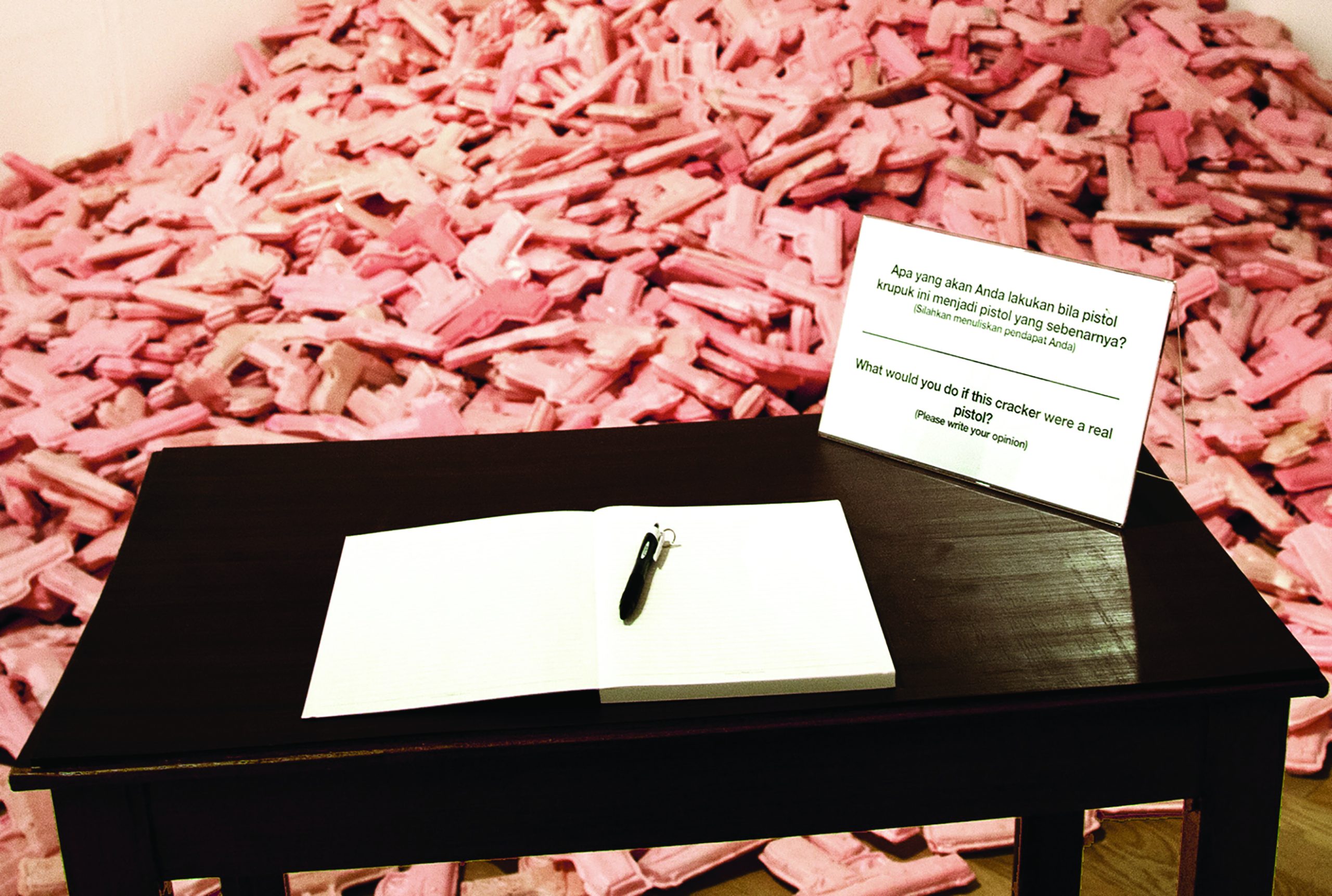
Cracker Pistols, 1975
installation with wood desk, book, pen, text with digital print on paper, dimensions variable.
Photo: FX Harsono, 2015.
Young artists in Yogyakarta and Bandung began to experiment with unconventional ideas and conceptual works. The consequent deluge of “new art” was unstoppable. The conditions that led to the creation of works such as the New Art Movement persisted. Official educational institutions in Yogyakarta and Bandung eventually added a new course called “Experimentation.”
Contemporary Visual Art
Can it be said that Indonesian contemporary art originated from the New Art Movement (GSRB)? This is a challenging question to answer. We do not explicitly state that our movement involves the creation of works based on postmodern ideology, which is the ideology of contemporary art. Postmodern thought had not yet reached Indonesia, or to be more specific, we were unfamiliar with it. When I began to enter the larger art world in Southeast Asia, Australia, and Japan after the 1990s, I realised that our rejection of seniors in the creative process was a rejection of the principles of creation based on modernist ideology.
We rejected the notion that the artist’s hand acts as a seismograph needle for the artist’s feelings and emotions, that is a manifestation of the artist’s soul. We rejected the idea that the artist is a genius who plays a key role in the creation that is sacrosanct, allowing the work to stand on its own while revealing the artist’s aura. We value ideas and concepts based on our understanding of our surroundings. Western modern art theories are not the only source of truth; rather, artists’ aesthetic values are influenced by their historical and cultural background.
Is this sufficient evidence to claim that the New Art Movement (GSRB) signifies the beginning of Indonesian contemporary art? What is certain is that after the GSRB exhibition, groups with similar artistic tendencies emerged. PIPA, or Kepribadian Apa,8 is one of them, formed by young Yogyakarta artists. There is also Cemeti Art Space, now Cemeti Institute for Art and Society, that was founded in Yogyakarta in 1988 as a contemporary art space.
Because of the rise of social media, serious and meandering discourses have been simplified with popular, light, interesting, and easily accessible texts and features, and the principle of creating by experimenting has become a common basis for creation in Indonesia. It takes a playful spirit to dare to defy all the rules that are perceived to be oppressive in order to attain something simple and interesting out of serious discourse. Given their different cultural backgrounds and the ongoing evolution of modern digital culture, young artists from Generation Z and those associated with the New Art Movement will undoubtedly produce different work.
Footnotes
1 S. Sudjojono (1914-1986)—regarded as a foremost Modern Indonesian painter—was quoted saying how the artist’s hand is like a seismograph to manifest his or her “visible soul.” Sidharta, 2006.
2 Wiyanto, 2022
3 Jakarta Biennale
4 It will help the reader who may not be familiar with the art history of Black December to cite the names of the five modernist artists who were awarded as influential teachers and also painters: Aming Prayitno, Abas Alibasyah, Widayat, A.D. Pirous and Irsam. Aming, Abas and Widayat lectured at ASRI, Yogyakarta. A.D. Pirous was from Bandung and Irsam from Jakarta.
5 Sekolah Tinggi Seni Rupa Indonesia ‘Akademi Seni Rupa Indonesia’ (High School of Fine Arts, Academy of FIne Art). In 1984, this merged with two other pre-existing arts higher education academies to become ISI Yogyakarta or Insititut Seni Indonesia Yogyarakta (Institute of FIne Arts).
6 Yuliman 98 (translated by Vanie Sindana).
7 1967-1998, also known as the New Order regime of former President Soeharto (1921-2008).
8 Arsip IVAA http://archive.ivaa-online.org/pelaku-seni/pipa-kepribadian-apa
References
Hasan, Asikin. “Indonesian New Art Movement”. 1992. BA Art and Design dissertation, Bandung Institute of Technology. Print. http://archive.ivaa-online.org/files/uploads/texts/1992-Pasaraya_excerptAsikinHasan_ENG.pdf
Jakarta Biennale: Profile.” Biennial Foundation. https://biennialfoundation.org/biennials/jakarta-biennale-indonesia/
Sidharta, Amir. S. Sudjojono: Visible soul. Jakarta: Museum S. Sudjojono, 2006. Print.
Wiyanto, Hendro. FX Harsono, Sebuah Monografi. Yogyakarta: Gang Kabel, 2022. Print.
Yuliman, Sanento, “Perspektif Baru (A New Perspective).” Gerakan Seni Rupa Baru Indonesia, Jakarta: PT Gramedia, 1979.
Essays
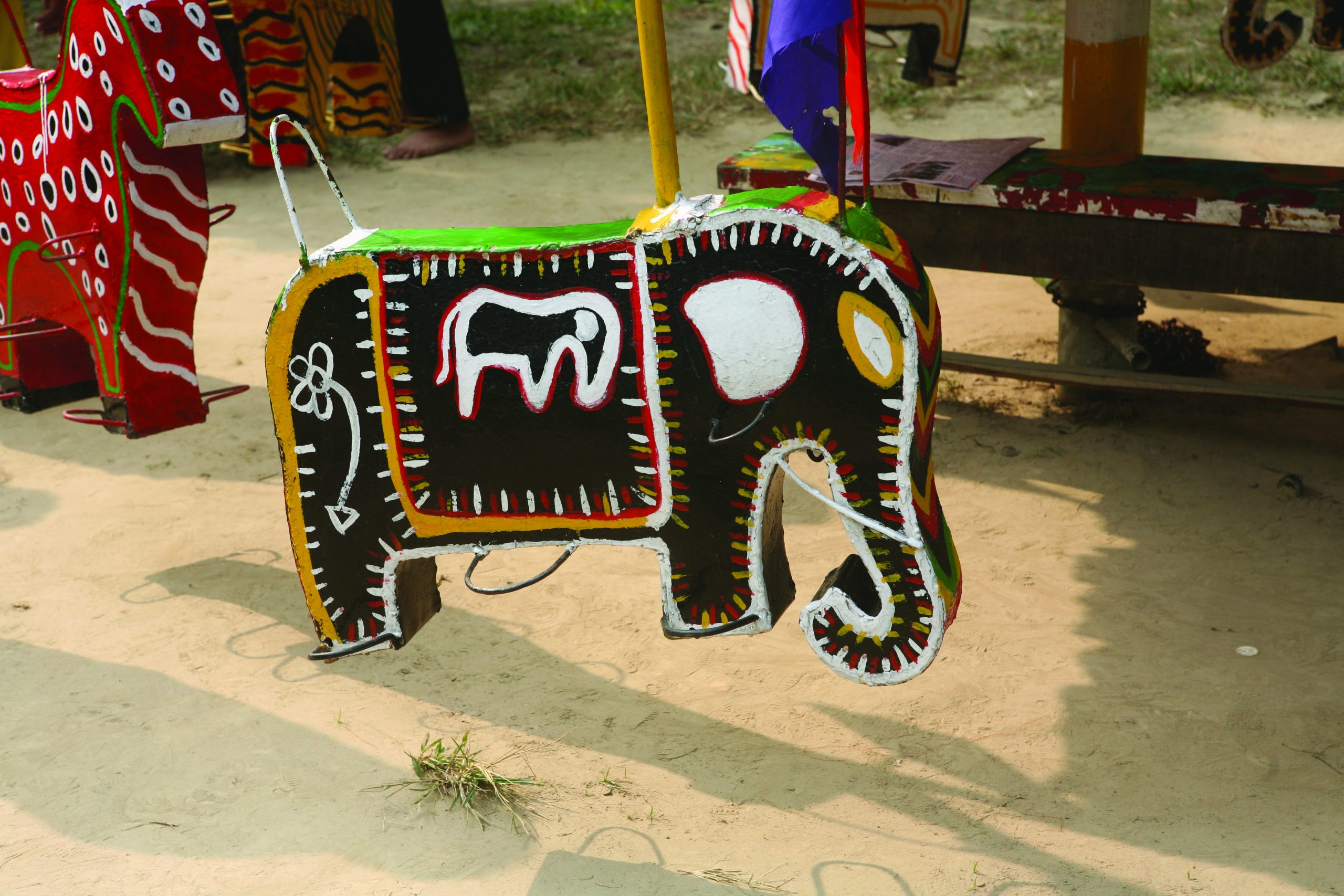
A childhood memory reborn. Photo: Samit Das, 2021
Drawings on a wet playground
When I was young I had an art studio in my family’s Jamshedpur house on the ground between two verandas. That was my playground to play with visual imagination. I had some white chalk, a piece of wet cloth and the afternoon sunlight for company. Spending quiet afternoons drawing during school holidays became part of the early memories of my imaginative world. I do not know why I never had the urge to scribble on the walls, and it was because of this that there were no protests from my family at my drawing in this part of the house. The damp floor, my early playground, was perfect for making more permanent chalk drawings. Unknown to me, this was an early lesson in archiving. My memory of drawing with white chalk on the grey surface of the open veranda is still fresh.
That sensibility still thrives in me, just like the greys, whites, and blacks that dominate my art.
While drawing on the ground I sensed the sun, the rain, the little hills of rock, and the trees around me. This was because our house was in the middle of a small green spot surrounded by rocky hillocks and trees. The memory of that enduring journey remains alive within me.
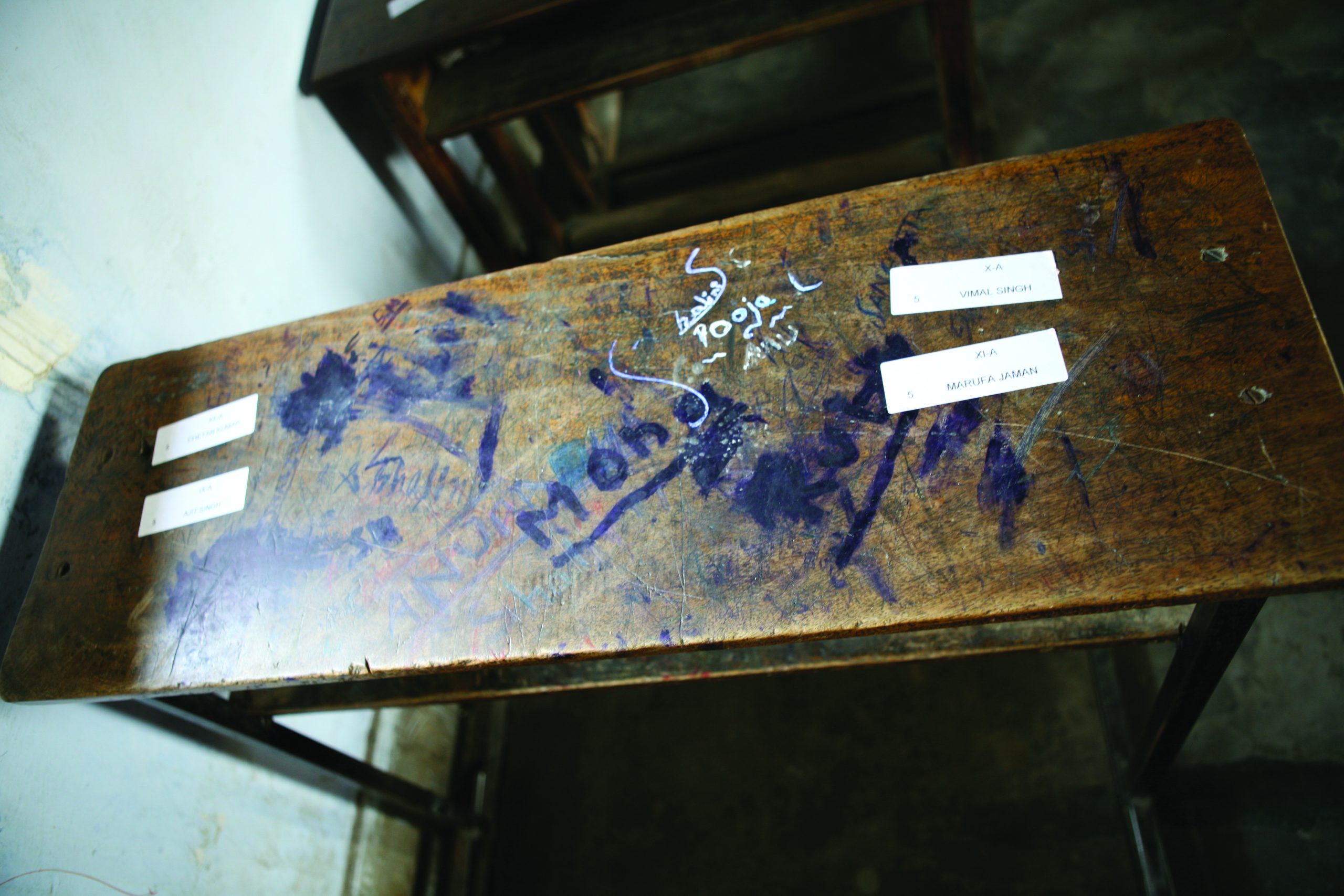

Graffiti on a school bench by High School students, Delhi.
Photo: Samit Das 2012-13.
An imaginary ground and singular performer
In my childhood I liked to collect bits and pieces of paper. My collection included everything from handmade paper packets, calendars and newspapers to the pages of various magazines. Most of them contained pictures that I wished to reproduce in my own way. Even if I were not always able to reproduce them correctly, I would experience an inner connection with them through the process of trying. I still remember a greeting card with etching prints, photo essays by famous photographers in old magazines, Alpona patterns1 and blueprints of machine drawings. A box of materials kept me alive for a long time; these often became subjects for my paintings later on in life.
My attraction towards painting developed as I grew, and my collection of magazines, books and newspapers started to grow. The old book market of Jamshedpur, my birthplace, helped me expand my horizons, and I seemed to fall in love with the smell of old paper. Later in life, this very attraction pulled me to the doors of archives related to art. Gradually I started to build up a collection based on my personal research needs. This collection consisted of old books and newspapers, film negatives, slides, old deeds, and digital books. The journey of this collection was centred around my interest in art and helped me in my practice.
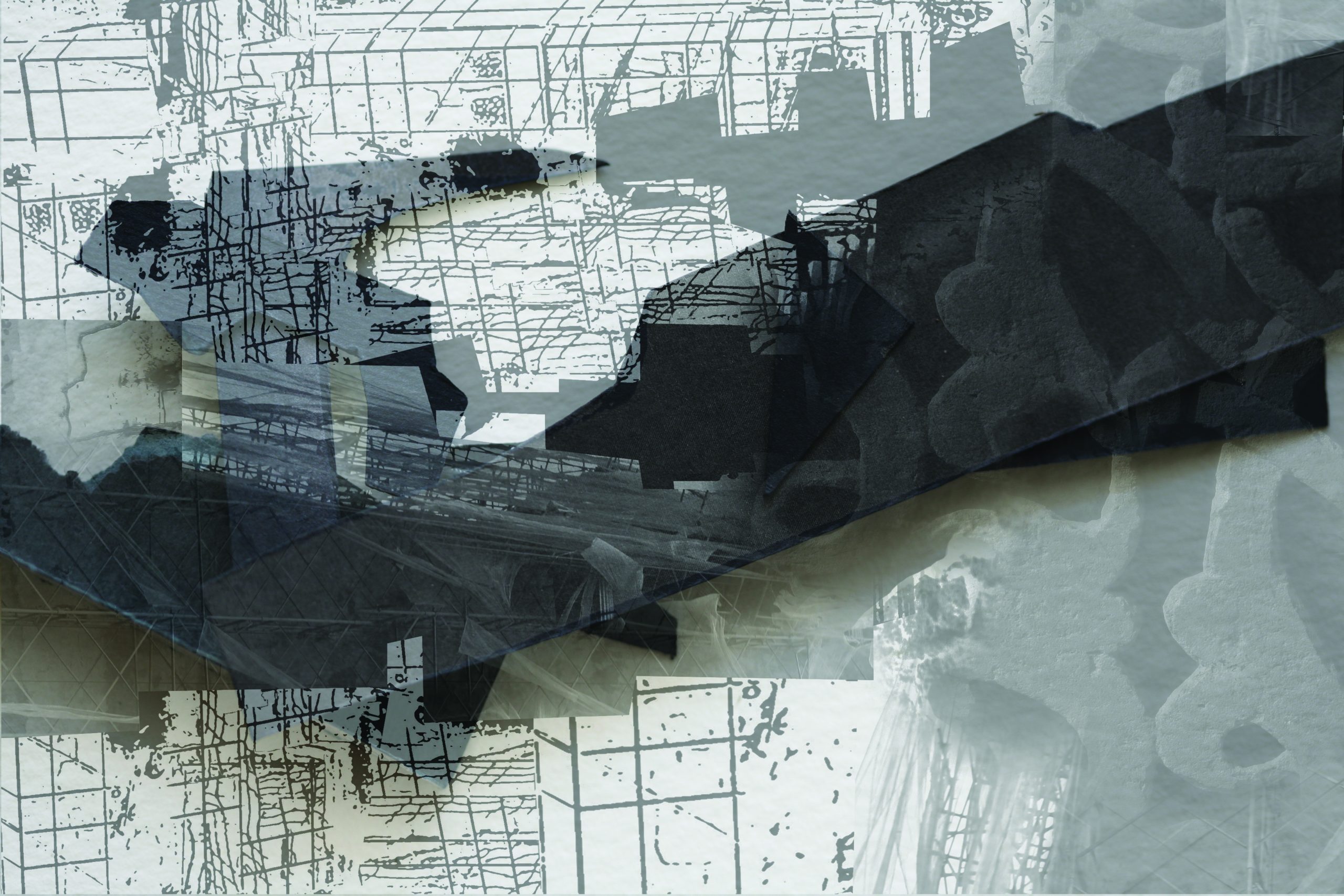
Samit Das, Architecture of Silence, 2018-22.
Mixed-media collage.

Samit Das, Architecture of Silence, 2018-22.
Mixed-media collage, 30 x 20 cm.

Samit Das, Architecture of Silence. Life is also about Silence
with many layers, 2018-22. Mixed-media collage.
The Architecture of Silence
A creative moment that is intuitive and an active space creates a dialogue between ‘self’ and ‘me’—a consciousness of a particular kind associated with dynamism. Art is nothing else but this spontaneous activity of the mind. Through the diversity of the mental flow, there is a diversity of the creative attitude of the mind, which alone is responsible for creating powerful language in the visual arts. Even if someone does not speak objectively, through imaginative representation and creative intuition of the mind, they may yet successfully communicate.
One of the best examples of an architecture of silence is the Rothko Chapel in Houston:
The colours in the Rothko paintings are those of blood and wine. As you stand in the chapel they are close, very close, even warm and comforting. Yet they do not oppress…Rothko created a religious environment with 14 large canvasses, distributed around the walls of an almost octagonal structure. The chapel…was dedicated on February 27, 1971, as an ecumenical house of worship.2
It is a dedicated space to feel deep silence:
Entering through two black doors, visitors to the Rothko Chapel are surrounded by 14 colossal black paintings installed in an octagonal room. A closer look reveals that they are all distinct, and none is in fact pure black, instead containing varying colours and textures in their shadowy surfaces. Some appear like nightshade; others have a deep oxblood tone. A skylight overhead gives the light a constantly changing quality, so as clouds pass or the sun sets, the paintings continue to transform…The non-denominational space is both a respite and a masterpiece of modern art. It was among the last works finished by the artist Mark Rothko.3
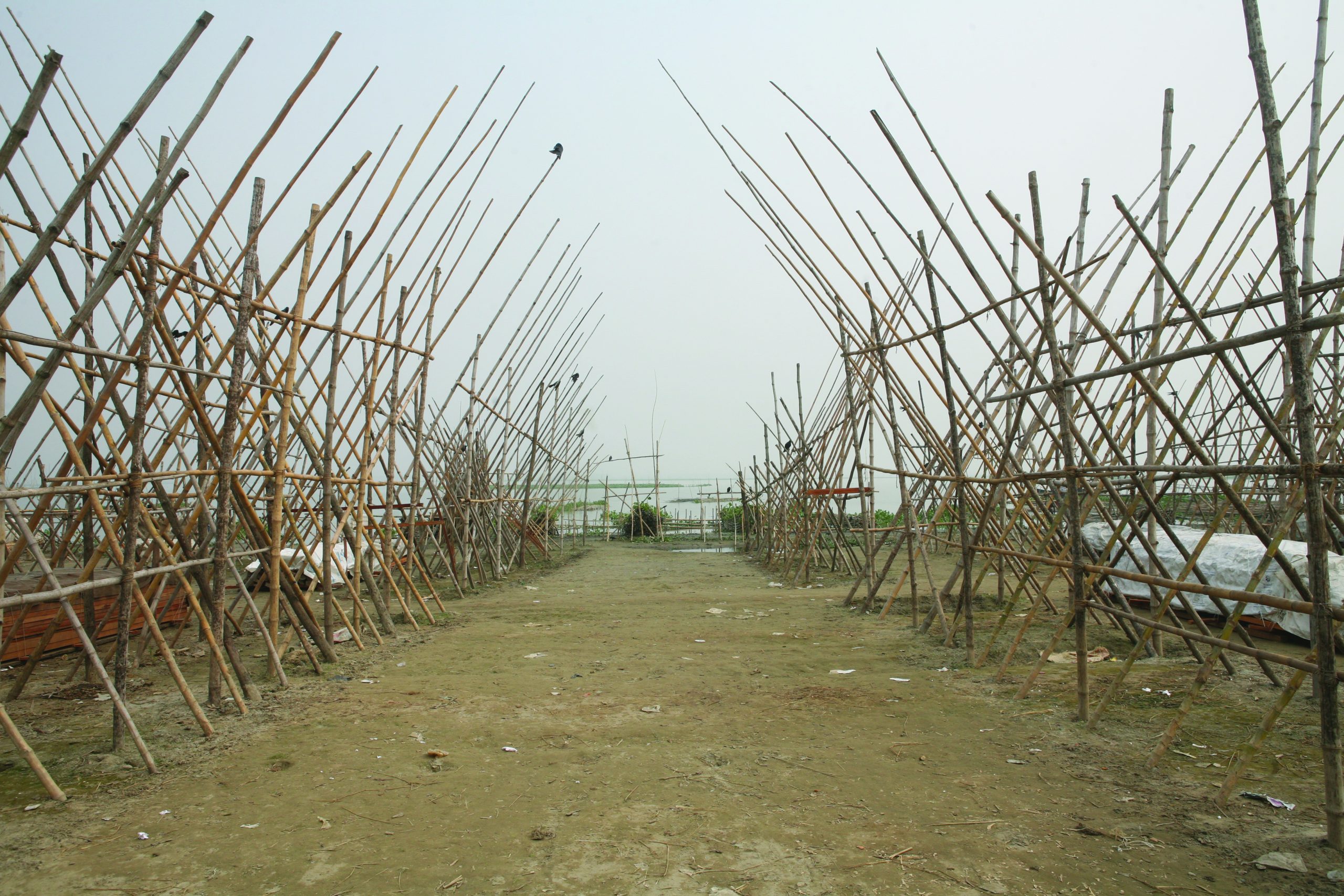
Architecture of Emotions: Never gets dissolved in air.
Photo: Samit Das, 2011.
Apart from that, my engagement with urban spaces goes beyond the level of noisiness, where I can recreate enduring spaces. It is an eternal silence when an airplane flies above cloud level. The architecture of silence is beyond mere concrete structures.
Cities and History of Materiality—Anatomy of Artificial Intelligence
The human organ, the brain, and its activity are no longer independent of daily life. All are alive, living, interveining; AI4 and contemporary dreams in the city have transformed its own logical structure. The definition of success and survival is constantly shifting. It moves and creates new challenges; these complex turbulences are also a contemporary reflection of self-identity.
The pandemic5 is teaching us about new definitions of global and local sustainability. Geographical world-mapping has a new purpose. The virus travels worldwide without a concept of borders.6 Still, humans cannot do the same, and physical reality has shifted in many ways towards augmented reality.7
Uses of materials and values assigned to them have complex explanations. There are major differences between the Asian world, Europe and other parts of the world. Asian products so far do not mention ‘made for Asia’ or ‘made for the Global South.’ However, European products have long-since8 adopted the logo ‘CE’, meaning conforming to European standards.9
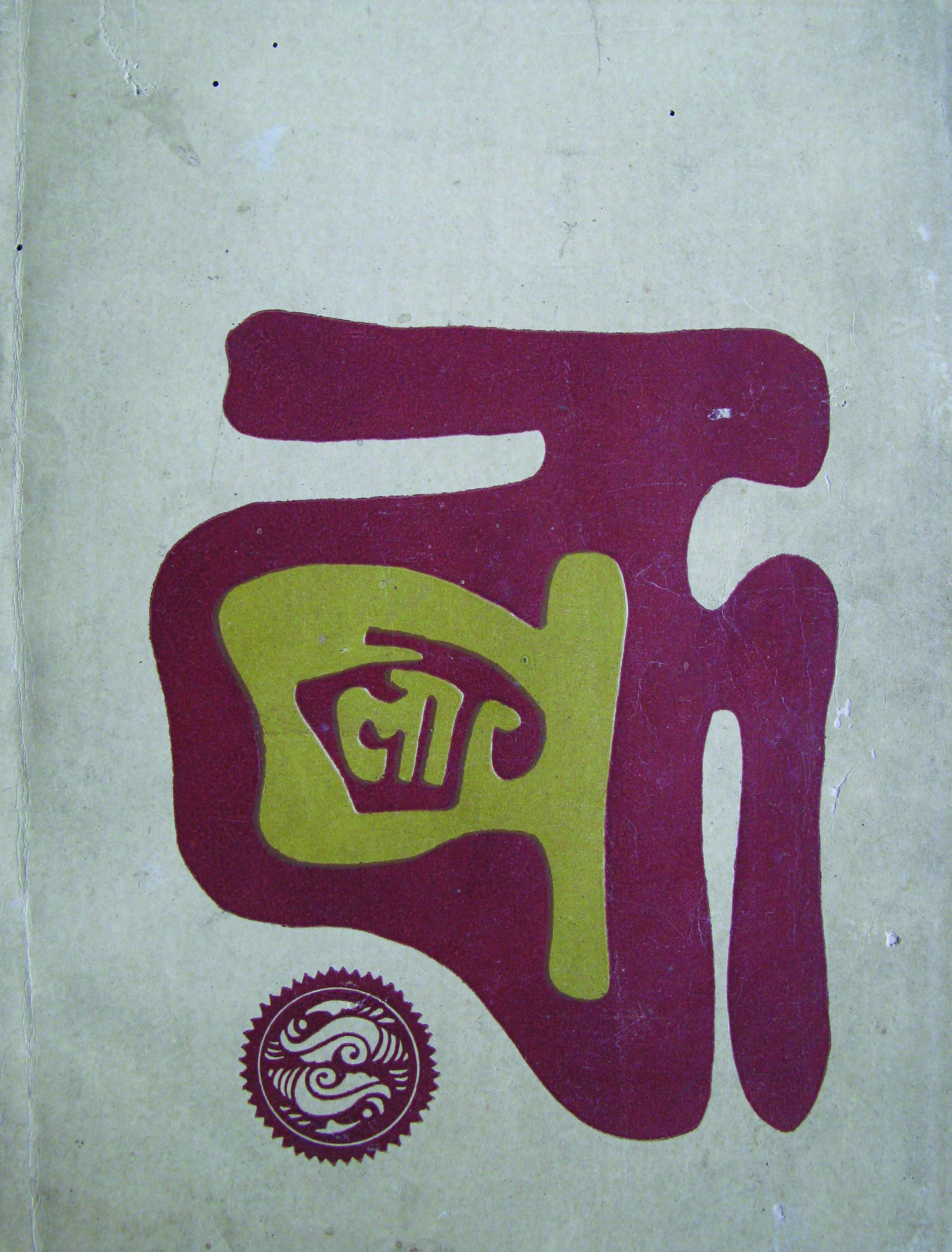
Cover page of Annual Art Journal. Published by Government College of Art and
Crafts. Kolkata during 1960s. Collection of Samit Das
Apart from manufactured products, locally available material has a lot to say about the region and soil. Any material is also a voice of tones which connect society. Using material in art is completely personal and depends on the artist’s concepts and content.
Day-to-day city structures are wrapped in large LED screens or signages to the point where city dwellers almost forget the actual character of the buildings. The original building materials remain hidden and camouflaged. It is a new visual element in many mega-cities of the world. In India, unauthorised colonies and makeshift structures have grown endlessly. Most of the mega-cities in India are in continuous movement, never standing still. Both the LED and makeshift structures create new visuals and an unfamiliar abstraction.

The analogue sound-recording, during film shooting in Kolkata. Image challenges
the digital era. The curiosity is a source of enduring energy of human brain.
Photo: Samit Das, 2009
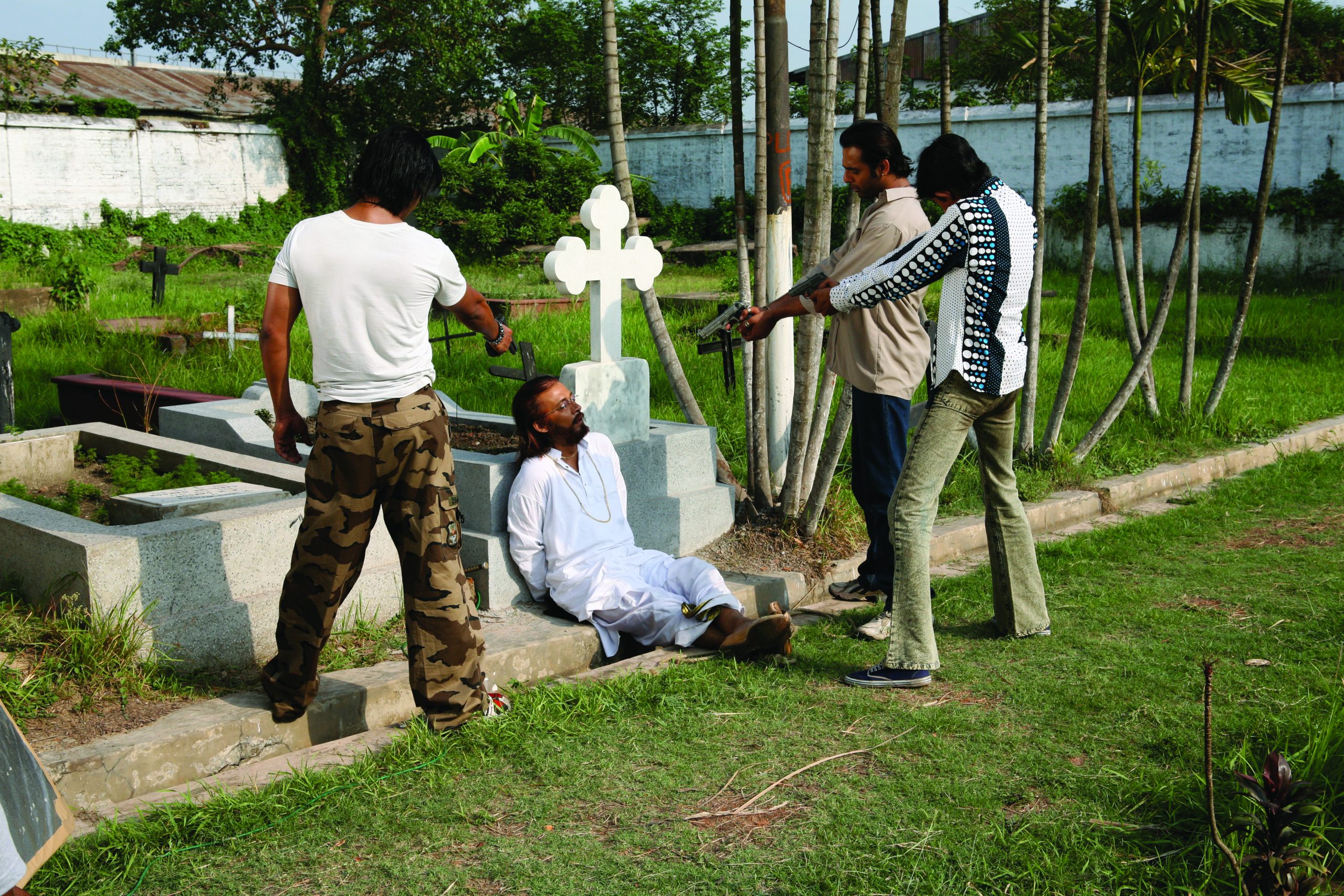
A film shoot at a graveyard in Kolkata, West Bengal, India.
Photo: Samit Das, 2011
Quick losses fading from the mind…
Physical objects and substances are unique in form, but they also exist in their particular locations in space. The entity operates on a resting surface, absorption and emission of light rays with varied dimensions. The changing airflows, sound reflection, conduction of heat and other processes depend on its surroundings. These interactions are essential to the agency and presence of a physical object. This process might reveal a new critical view of cities as live art installations.
The digital image can be made visible in any space. These variations may not create uniqueness. This journey may require an effort to simulate the physicality of objects with actual devices. Others mimic presential effects with artificial intelligence and algorithmic graphics, which are capable of being continually produced without repeating over a human lifetime.

Samit Das, Archaeology reveals the truth and dissolves human ego. It unlocks the
closed door of history, 2002-21. Digital and paper collage.
The augmented space and new abstraction in contemporary art
This series of images investigates the complex relationship between physical objects and facts of cities. The idea of new brain-power mapping forces computer-generated visuals to find a quick resolution in practical life! This photo essay is to intervein a lost aesthetic interest in architectural materials, objects and new meanings of the past. With a unique sense of material history yet without opposing a future corporatist in a touch-less ether, we can rebuild technology that augments the real rather than replacing it. This study can expose sharp tactile outputs parallel to the palpable sensory input that interactive artworks grow from the human body and mind and its further scope. AI-based programs are also creating new abstract languages in contemporary art. These are noticeable changes that have raised a critical dialogue between the virtual spaces of cities and digital forms of reinterpretation.
My inspirational words and influences
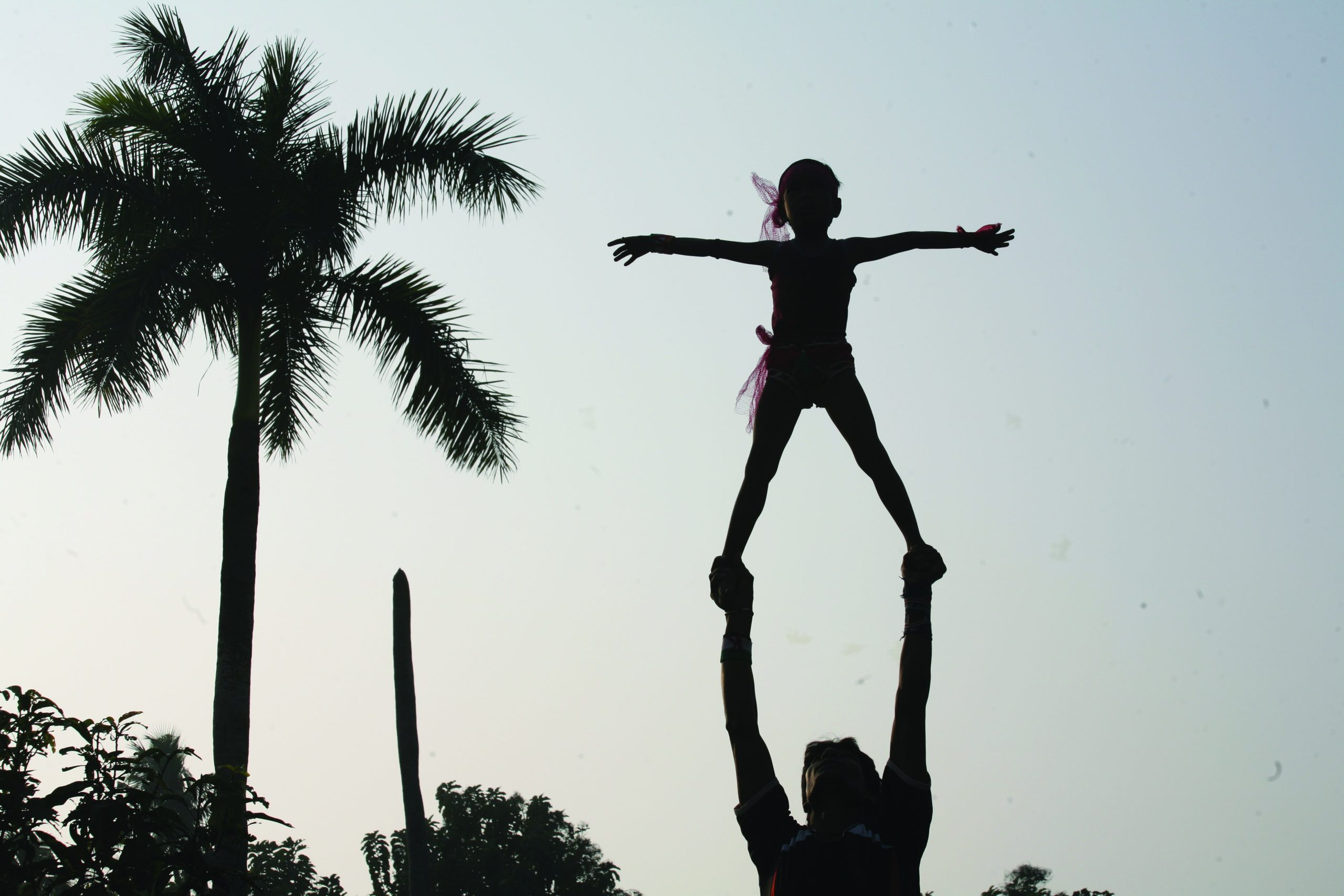
Playground can be formed anywhere: An innocent mind
never draws fixed lines! Photo: Samit Das, 2014.
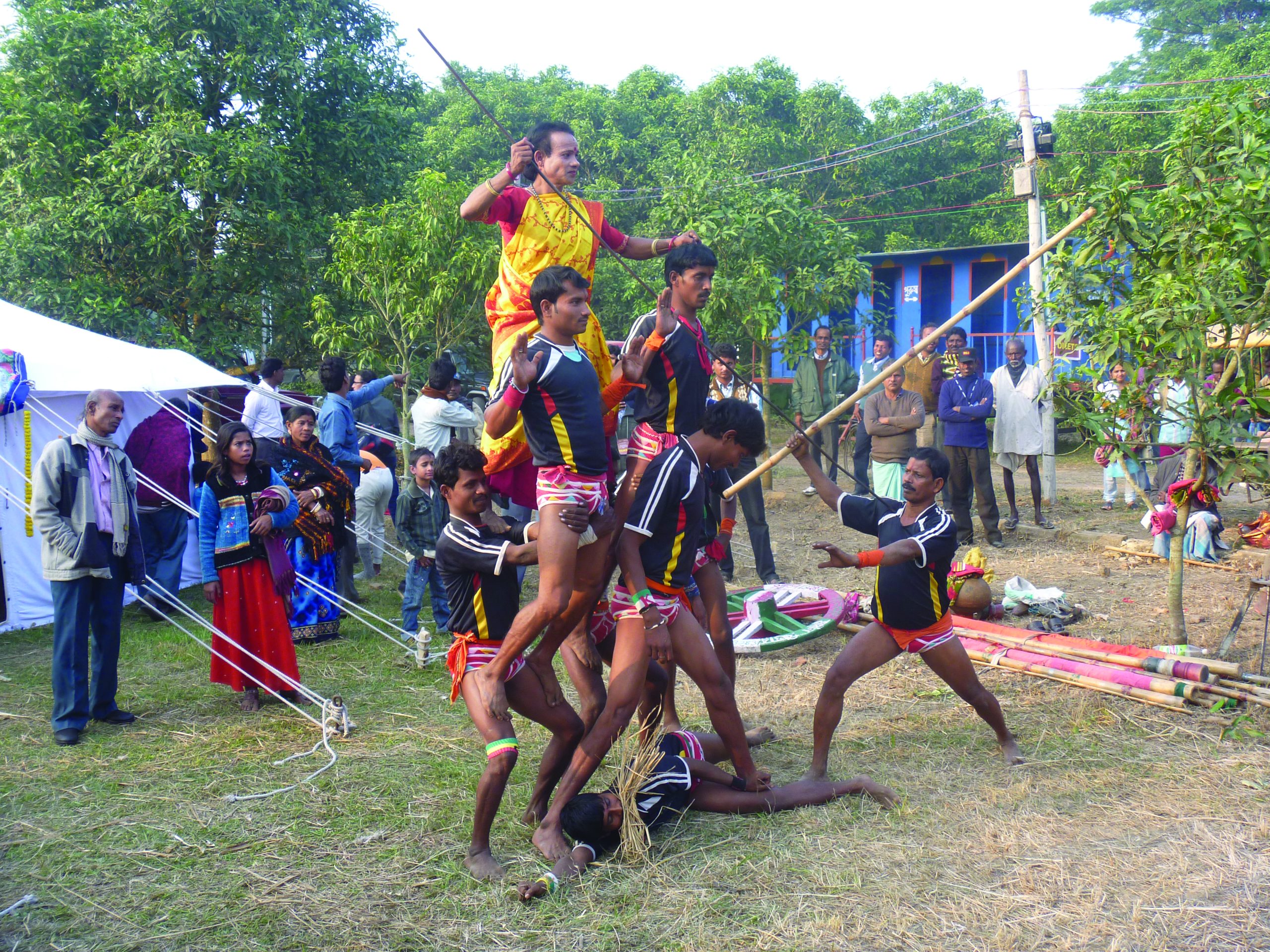
A true support is a source of enduring energy in any form of art.
Rainbenshey Performance in Bengal. Photo: Samit Das, 2014
Every playground of life and art has close connections. There are many moments when self-realisation takes the journey further. The playground always opens a new door for learning. It is essential to continually learn new approaches; the teacher orders and encourages this kind of mindfulness, which is the heart of understanding. Inspirational words appropriate to psychology and culture wake up the society they serve, enriching our minds, standing and aiding us in our explorations.

Street performers walking on stilts. Murshidabad, India.
Photo: Samit Das, 2014.
The learning mode has varied aspects, from inspirational words to practical execution. Inspirational words never form in a day. Instead it takes ages to attain a more profound sense of philosophy. The iceberg strengthens once it creates a meaningful bridge between art and life. The meaning of education realises self-experiences in connection with the past and present.
Understanding inspirational words that may make the artistic journey more refined is essential. This lexis may not have direct reflections on artistic languages. Still, it helps us to expand the horizon of the playground, which may exist only in the mind-scape.
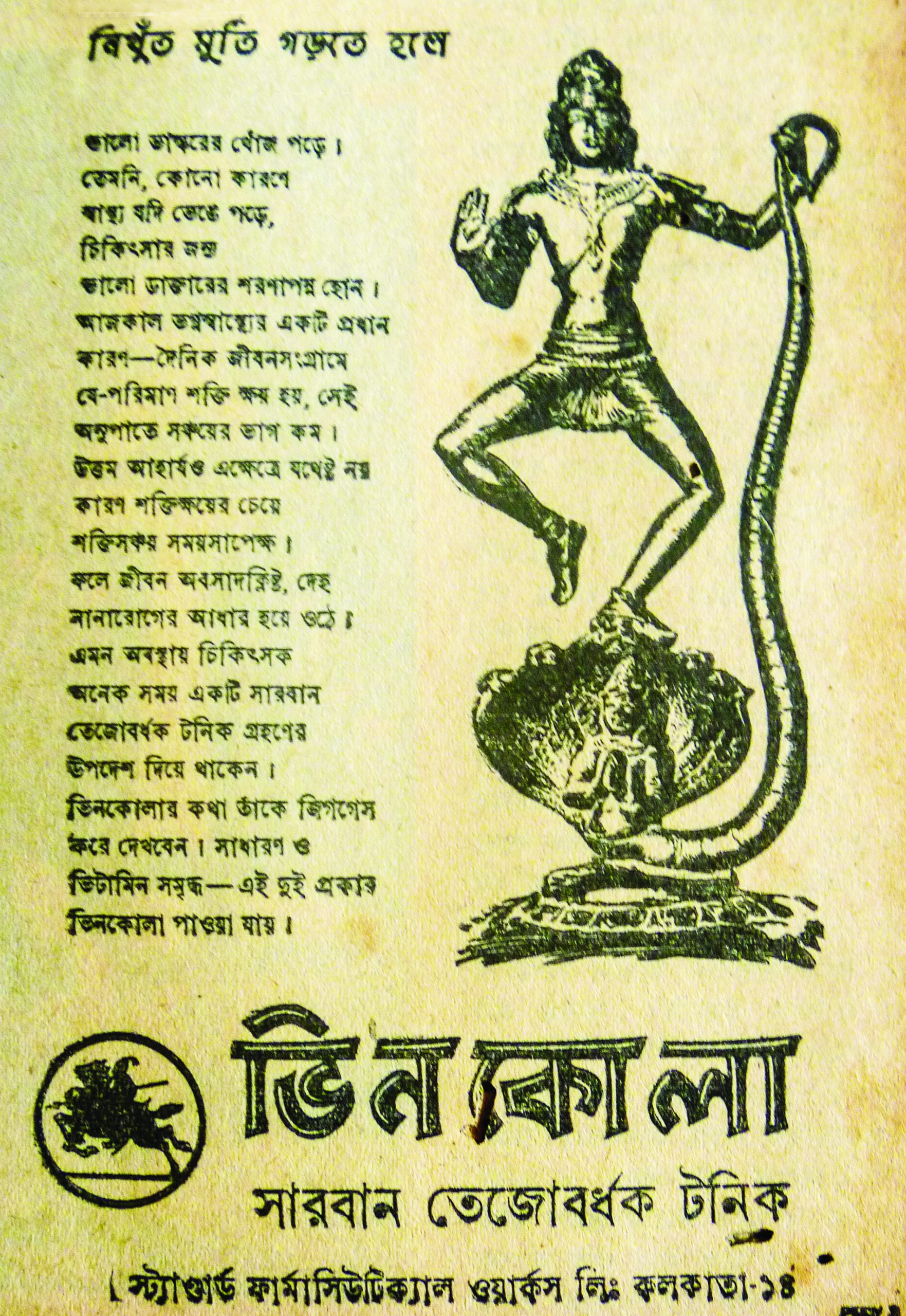
Advertisement for strength Tonic, during 1970s. Description compares
tonic with the perfect and skilled sculptor.
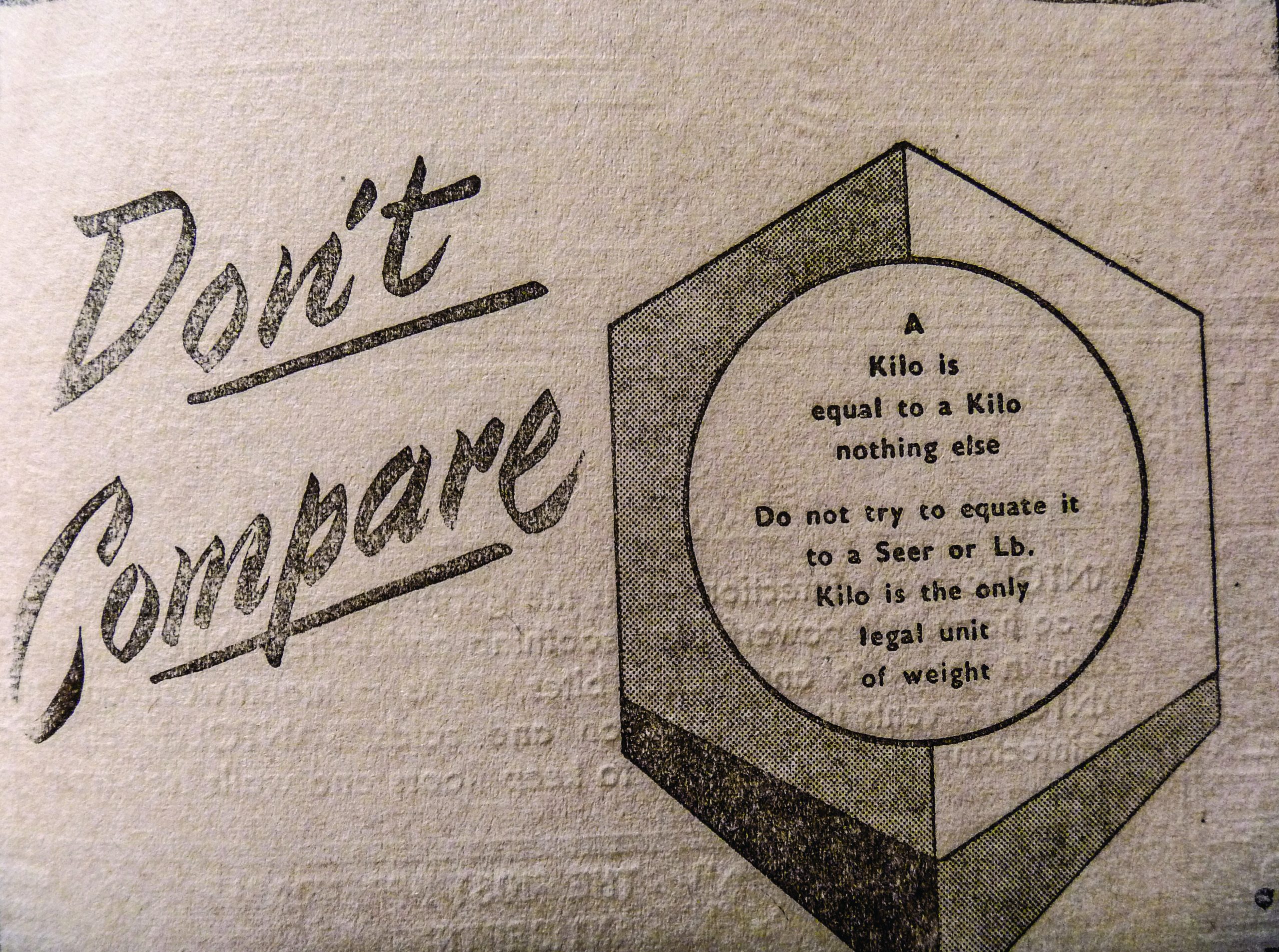
An advertisement of measuring
unit, published in a Bengali journal during 1970s.
Visual language cannot develop in a day or without process. Its evolution requires the construction of a detailed anatomy. This knowledge of anatomy needs inspirational words and influences reflected through the art-making process. My inspirations come from varied personalities, and many of the following fragments of words are deeply connected to my art practices. Here, I mention a few quotes from great individuals that guide me on my enduring journey in artistic practice. These words turn from hammers to paintbrushes and return to my memory again and again.

An extraordinary evidence to understand the value of archives during pre-
independent India. Nandalal Bose is preparing the Tagore collection under the
guidance of A.K. Comaraswamy. Pen-and-ink drawing by Nandalal Bos.
Image courtesy of DAG New Delhi.
Words of Swami Vivekananda
Knowledge is the parent of intuition, which like instinct, is also unerring, but on a higher plane. There are three grades of manifestation in living beings: (1) sub-conscious – mechanical, unerring; (2) conscious – knowing, erring; (3) superconscious – intuitional, unerring.10
Concentration is the essence of all knowledge; nothing happens without it. When the mind is concentrated and turned back on itself, all within us will be our servants, not our masters. Concentrate on the inner world, upon the unseen realms in the Self.11
Excerpts from a letter by Nandalal Bose
Oct 3, 1941/ Aswin 16, 1348/
Morning/ Santiniketan
... If one can have an accurate idea of how in limitless space everything grows, moves endlessly from form to that beyond the state… He can become nature’s poet or artist from concept to that beyond concept. There is a secret technique in painting. While trying to paint that tree one should not get lost in the complexity of its numerous details; one should paint its space. One will see that the tree has come into one’s grasp in full shape and structure; its form has blossomed forth...
The rasa (aesthetic essence) of tranquillity is the beginning and end of all rasas. Happiness or sorrow, love, hate or disgust, whatever the emotion or excitement, becomes the subject of art only when, within and above it, it attains a state of steadiness or poise, or impersonal balance.12
Visva Bharati Quarterly, Nandalal Centenary Number, Volume 49, Numbers 1-4, May 1983 - April 1984, Visva Bharati, Santiniketan, December 1987.
What is Painting? By Mahendranath Dutta
Painting is not merely drawing lines and enamelling the same with colour. Still, it is an acute psychological process that the painter himself very often overlooks.
The painting attempts to represent or reproduce a picture of the mind through colour and lines or by certain suggestions. For this reason, we have the vision; we visualise the ideas in a glaring form. We stop and compose our nerves and try to reach a calmness, a dignified attitude, and a sober state of mind. We select materials—colour and lines and attempt to represent through symbology what is passing inside the mind. One is ideal, and the other is representation. In this stage, the painter remains in a state of conscious trance. He tries his utmost through these suggestive representations to bring down the ideal within the observing faculty of persons or to raise the observer’s mind to the level and high pitch of his purpose. A few patches of colour and scratching of lines are mere means to reveal his mind to others, but scarcely does he succeed.13
Footnotes
1 A very widespread tradition of ritual art known as Alpona or Alpana in Bengal…(and) Kolam in South India. The designs are drawn on the floor without the help of ruler, compass or any similar instrument, using the tips of the fingers; women and even small girls create these designs in neat, bold outlines. Chaitanya, A History of Indian Painting Vol. 5 The modern period.
2 De Ménil, The Rothko Chapel.
3 Meier, How the Rothko Chapel Creates Spiritual Space.
4 Artificial Intelligence (AI), the ability of a digital computer or computer-controlled robot to perform tasks commonly associated with intelligent beings. The term is frequently applied to the project of developing systems endowed with the intellectual processes characteristic of humans, such as the ability to reason, discover meaning, generalise, or learn from past experience. Copeland, artificial intelligence, Encyclopedia Britannica.
5 In reference to the COVID-19 pandemic, a global outbreak of coronavirus, an infectious disease caused by the severe acute respiratory syndrome coronavirus 2 (SARS-CoV-2) virus. The first cases of novel coronavirus (nCoV) were first detected in China in December 2019, with the virus spreading rapidly to other countries across the world. This led WHO to declare a Public Health Emergency of International Concern on 30 January 2020, and to characterise the outbreak as a pandemic on 11 March 2020. World Health Organisation.
6 “The novel human coronavirus disease COVID-19 has become the fifth documented pandemic since the 1918 flu pandemic. COVID-19 was first reported in Wuhan, China, and subsequently spread worldwide.” Liu, COVID-19: The first documented coronavirus pandemic in history.
7 Augmented Reality is a real-time direct or indirect view of a physical real-world environment that has been enhanced/augmented by adding virtual computer-generated information to it. Carmigniani 3-46.
8 The first major directive implementing a single Community mark, then called the ‘EC Mark’, took place in 1987. Ballor 21-142.
9 The letters ‘CE’ appear on many products traded on the extended Single Market in the European Economic Area (EEA). They signify that products sold in the EEA have been assessed to meet high safety, health, and environmental protection requirements. European Commission.
10 The Complete Works of Swami Vivekananda - Volume VIII, 17
11 The Complete Works of Swami Vivekananda - Volume VI, 123-124.
12 Visva Bharati Quarterly, December 1987, 205.
13 Datta, Dissertation on Painting, 1-23.
References
Ballor, Grace. “The Origins of CE Marking: Standards, Business, and the European Market in the 1980s–1990s.” Harvard Business School Working Paper, No. 21-142, June 2021.
Bose, Nandalal. “Letters.” Visva Bharati Quarterly, vol. 49, No. 1-4. Visva Bharati, Santiniketan, 1987.
Chaitanya, Krishna. A History of Indian Painting, Vol.5: The Modern Period. Abhinav Publications, New Delhi, 1994.
Copeland, B. “artificial intelligence.” Encyclopedia Britannica, https://www.britannica.com/technology/artificial-intelligence. Accessed April 16, 2023
Carmigniani, Julie & Borko Furht (ed). “Augmented Reality: An Overview.” Handbook of Augmented Reality, 2011, pp. 3-46. doi: 10.1007/978-1-4614-0064-6_1
Datta, Narendranath. The Complete Works of Swami Vivekananda, Volume VIII.
Advaita Ashram, Calcutta, 16th reprint 2010.
Datta, Narendranath. The Complete Works of Swami Vivekananda, Volume VI.
Advaita Ashram, Calcutta, 18th reprint 2011.
Datta, Narendranath. “Dissertation on Painting.” Mahendra Nath Dutta. The Mahendra Publishing Committee, Calcutta, third edition 2004.
De Ménil, Dominique. “The Rothko Chapel.” Art Journal, vol. 30, no. 3, 1971, https://www.jstor.org/stable/775487
European Commission. “CE Marking.” Single market and standards, 2023, https://single-market-economy.ec.europa.eu/single-market/ce-marking_en
Liu, Yen-Chin et al. “COVID-19: The first documented coronavirus pandemic in history.” Biomedical Journal, vol. 43, no. 4, 2020, pp. 328-333. doi:10.1016/j.bj.2020.04.007
Meier, Allison C. “How the Rothko Chapel Creates Spiritual Space.” JSTOR Daily, 2020, https://daily.jstor.org/how-the-rothko-chapel-creates-spiritual-space/
World Health Organisation. “Overview.” Coronavirus disease (COVID-19) pandemic, World Health Organisation, 2023, https://www.who.int/europe/emergencies/situations/covid-19. Accessed 21 Apr 2023.
Vivekananda (Swami). The Complete Works of Swami Vivekananda - Volume VIII. Advaita Ashram, Kolkata, 16th Reprint, February 2010, p. 17.
Vivekananda (Swami). The Complete Works of Swami Vivekananda - Volume VI, Advaita Ashram, Kolkata, 18th Reprint, April 2011, pp. 123-124.
Conversation: Phnom Penh
Phnom Penh: Art, National Comfort in a Decolonising Southeast Asia
This conversation took place in Phnom Penh, Cambodia on 27 and 28 April 2022. The discussion aims to be as close to the participants’ comments within the vernacular expressions and has only been edited for clarity where needed. The original transcription was considerably longer; the present form is a focused rendition.
Contextual Space for Art and the National
Venka Purushothaman
Change is ever-present, and artist communities, educational institutions, governments, and economies are all responding in particular ways. But we are not finding enough voices of artists in these changing moments speaking to issues. Perhaps people think that artists’ expressions of their voice are only through their artwork. But we know that is only one dimension of expression. ISSUE is a space for artists to ‘speak’. We feel that it’s important to engage them in conversation, to understand their own take on different issues that concern us. This conversation is ultimately to formulate critical questions for our times. The focus for us is the concept of a ‘playground’ both as a practical space of play and a sophisticated embodiment of existential conditions. Play, ground, ground play and playground open us to opportunities to reflect critically on our current condition.
Milenko Prvački
Last few years have been a bit dark because of the global situation and you know, we question some very big issues and even now, each year seems to be worse than the last. So, we decided to take a slightly lighter issue like a playground, but not only a playground like the one for kids or for leisure, but a more sophisticated one. Because even I find that what happens in Ukraine is a playground for war.
Venka Purushothaman
So, for us, I think the ‘playground’ itself was something that is more than a physical space in terms of the play but there is also a metaphysical dimension that’s emerging. A playground is also about artistic and creative exploration. You know, how do you, through playmaking, how do you discover, how do you explore? So, we were reflecting on the fact—and we’ve also gotten different writers to think about it— that through play humanity has also evolved in many ways. And sometimes play is called experimentation, you know, in many ways.
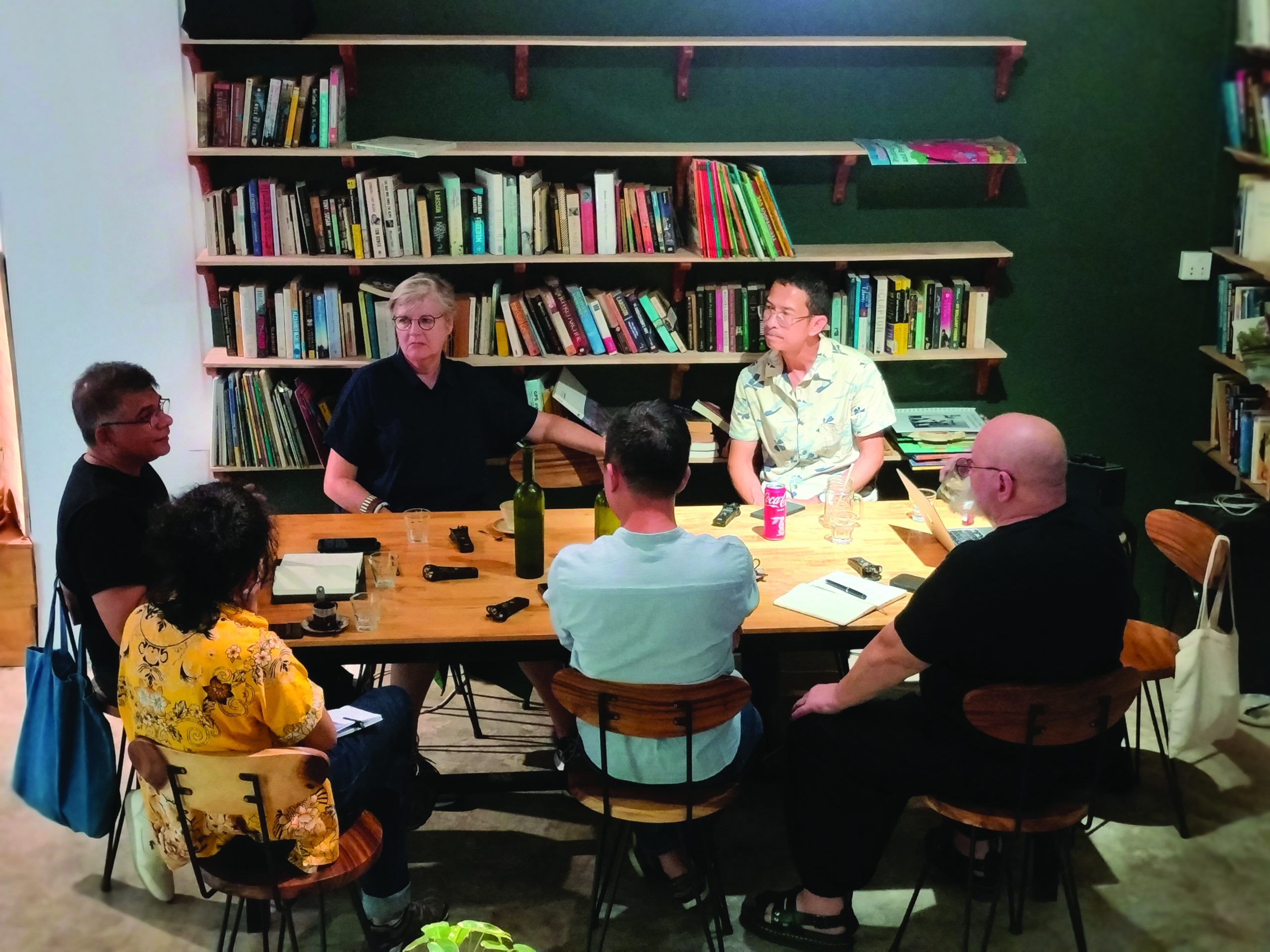
From left to right: Venka Purushothaman, Reaksmay Yean, Mella Jaarsma a,
Khvay Samnang, Sopheap Pich, Milenko Prvački.
YK Art House/Silapak Trotchaek Pneik Gallery, Phnom Penh
There is a lot of space for joy, discovery, and fun; and as Milenko says, there are also lots of opportunities to critically look at it, and the fact that you know war itself has become a playground of sorts. Then there’s also another dimension, there’s the technological dimension which has entered the art world. Today, technology and you know when you talk about the metaverse, it is as a playground of disembodying the human out of the lived condition to a virtual one. And the fact that the world is investing so much in a virtual human more so than in the embodied human also makes for quite an interesting playground that we are considering because so far the only approach we have seen taken is that it is only a financial dimension to this playground of the metaverse and not necessarily a social, creative dimension. We are in many different layers of ‘playgrounds’ right now. So, we think that play itself is also looking at a spatial dimension, [such as] the gallery as a playground of ideas.
But playgrounds are always managed by adults for children, you know; they call it safe and sound and protected and developmental work happens. However, playgrounds today are also unsafe spaces. So, when it’s not safe to be in a playground, what does that playground really mean? So I think that’s the whole idea of, you know, ‘playground’ also becoming a place of surveillance, right? So, we find that irony, the fact that what a playground means originally, if you look from a child’s perspective, is all about freedom.
What does freedom mean? In contextualising ideas, Milenko and I landed on the ‘playground’ to enable us to raise these questions alongside artists. What ground play is in action? Such interesting concepts when what was supposed to be fun and free and about self-discovery, playgrounds, no longer is about self-discovery. For example, I come down a slide. I fall. I injure myself. Therein lies my discovery.
Sopheap Pich
That’s when there’s no playground!
Venka Purushothaman
And there’s no more playground!
Sopheap Pich
Which is the best playground I think.
Venka Purushothaman
Absolutely. Today, we spend more time injury-proofing playgrounds and it is no longer about discovery or self-discovery. Are we setting new ground rules for what the playground is? What are the new rules, are there going to be new rules for this or should we not have them? All right, should there be a shape and structure to the playgrounds? And is it about the construction of that space? The most important ingredient of the ‘playground’ is the human at the centre of human association and interaction with others. And our children—we apply the concept—children go to the playground, they don’t know the other children but they all work together, they come together, they collaborate.
I have said a lot but I would like you to consider these questions and concerns and share with us your own take on those kinds of processes.
Milenko Prvački
To add to Venka’s point, I was thinking about different artists with strong practices who are all happy with doing the same things and nothing else. The reason why the three of you are here is because of [each] your own different practices, functioning and creating in your own studio, your own playground.
Khvay Samnang
Just a short introduction about my art practice. I studied painting at the Royal University of Fine Arts (RUFA), Cambodia. But, of course, I did very little painting because I was into photography, and digital technology. I paint with light. I am more performance-focused, performance with my body. I work mostly on issues of land rights, human rights. Where there is a problem, I go there and from that place, learn what happened and then experiment with that place.
Sopheap Pich
I’m Sopheap. I continue to find out what the hell I’m doing. Questioning it all the time but I keep doing the same thing, I still can’t get to what that is. I think that I, if I have to summarise my way of thinking or working, it would be that I try to absorb things from my memory and from my experiences and try to consolidate them all at the same time into an artwork, every single artwork. And that entails politics, that entails childhood memory, art history, things my teachers taught me, what not to do; and it entails play, most of it is play, but a serious kind of play I guess because I’m an adult and I have to accept that I’m somehow responsible for something, not sure what it is exactly, I just know I have to be responsible. So, that entails sometimes taking myself too seriously, and sometimes being a bit hard-headed which can be read as selfish and egotistical.
I’ve been back here in Cambodia for 20 years and it’s where I have found my path, I think I might have found my voice but I think my path is more important than my voice. And I try to do the most work I can, every year, to be honest. I try to be productive. So maybe that has something to do with my belief that in order to survive we have to be responsible.
Venka Purushothaman
Where were you before you came back?
Sopheap Pich
I was born in 1971 and my family left after the Khmer Rouge in 1979, living in refugee camps for five years and then ended up in Massachusetts, USA when I was [between] 13 and 14 years old. I did all my schooling in the US and I was fortunate enough to be hard-headed to not listen to the better advices and went on my own to pursue an art degree. I came back here in 2002. My father passed away last year, my mother’s still in the US, my three brothers are still in the US. I have one brother here, we both came back.
Milenko Prvački
So interesting to see the new generation of Cambodians coming back, but not the parents. That’s interesting.
Venka Purushothaman
We can come back to some of the points you mentioned, but let’s hear from Mella.
Mella Jaarsma
My name is Mella, I was born in the Netherlands and I came to study in Indonesia in 1984 and since then I lived there. Because somehow I feel it’s my place, in 1988 I started together with my Indonesian husband, an art playground, called Cemeti. Since 2016, Nindityo, my husband and I stepped down after 28 years so that a new generation can continue with the art space. We need new voices, new generations. Of course, it has changed a lot but that’s part of it and I am also happy with it. So yeah, I feel it very much relates to this idea of ‘playground’ with the idea that I always question the function of the arts, so how can we contribute something through the arts to open up questions but also to sort of make statements to think for the better. So this playground, or Cemeti, that I run for so many years was always a place to provoke, to connect, to open up, to show all the voices than the regular constitutions of education and religion—this is so strong in Indonesia. And also this idea of ‘playground’, what does it mean nowadays to have an art space in the global area with the internet? So sometimes I feel like we had more freedom during the beginning of this century because it was just before the internet and Whatsapp and Instagram, related to censorship. We had more freedom to do things in an art space, in this playground we could express what we wanted; but now because everything is captured and then put online—some artists were already caught by the police because art events were put online and got censored because of that.
Also with creating my own work, I feel like it’s also very important to show the things that concern me and I work a lot with costumes, especially since the end of the 1990s. For me, costumes create a close bridge with the audience so the messages I want to address through my work or through the costumes directly connect with the public. I always look for ways, how to make the connection with the people standing in front of the artworks so I’m really thinking from the position of the audience. So this also somehow relates to the playground and also the idea of what do you want, as an artist to communicate and for what to place artworks in this world. Where and what kind of community is looking at it and what do you want to address.
Milenko Prvački
I was born in a country that doesn’t exist anymore. I was born in the former Yugoslavia and when I came to Singapore, it was Yugoslavia. Then slowly because of the civil war, it disappeared. But I was originally from Belgrade, Serbia. I studied in Romania, and I end up in Singapore. I’m an educator and I trained as a painter. I have lived in different systems—a socialist country, a communist country, and Singapore. I have spent time in the US. So, I experience these different playgrounds and frames for playgrounds.
Just thinking about Romania which was very restrictive during Ceaușescu’s time and as a student we couldn’t see any shows, only very ordinary social-communist narratives, but if you visit the studio, it was always amazing, it’s a totally different playground. Because they can play, explore and do whatever they want in the studio except not show up. And then in other countries, that time was so free, and so it was a good experience for me, and that’s what I’m talking about—a sophisticated playground, that even if it’s hard, even if it’s complicated, all of us as artists we are in permanent confusion you know and that’s what differs us from other people. And when my students tell me “I’m lost!” I always reply that I have been lost over 50 years. It’s fine, it’s our stage you know. I’m trained as a painter but I do installations, a lot of drawings, sculptures. I love movies, video, but I start doing abstract art because of too strong narratives around and I found that painting is out of that speed; every photograph, video maker, filmmaker they can tell this story much easier, faster and so I move only in abstraction exploring different kinds of areas. At the same time I have been an educator for almost 30 years, so I’m watching my lost students playing around and teaching them that this is the way to do it.
Mella Jaarsma
Super!
Venka Purushothaman
All your backgrounds have some interlinks around displacement, discovery and play. But I would like to return to a point Sopheap made earlier that the path is more important than the voice in any given space.
Sopheap Pich
The most important thing for me is to be an artist. So, when you’re an artist in a country where 90% of the artists have either died or been killed during the Khmer Rouge rule, you’re trying to find your identity as an artist and also within the history of that void. As a result of the civil war, you are basically disconnected between the past and future for almost 25 to 30 years. Well, what do you do? What do you do as an artist?
And I lived outside of Cambodia; so for me that question is big because you see so much art, I saw so much art when I was away, when I was in school and all the art that I looked at was somebody else’s art, so this question of what am I supposed to do as a Cambodian refugee, son of refugees, living through the civil war, living through the famine, the dark, maybe the darkest history in Cambodia, what is my responsibility, what do I say? What do I fight for?
Our young artists are talking about land and nature and rights, people’s rights, nature’s rights, spirituality’s rights and I’m coming back to a place that has more temples than libraries, more mess than beauty. Though you can say the mess is beauty, I’m not so clear about that. I can see why some people would see that but if you live inside the mess, sometimes you are not thinking it’s beauty anymore because you have to deal with it every single day. So then, the path is to be an artist and not to swayed, not to be steered to convenience into so called usefulness because if it’s up to my parents they would say, be someone useful, right? Be someone useful because if you are someone useful then the society needs you but if you are simply a critic or decorator or entertainer you are only useful to a handful of people who can afford to use you as an entertainer, to use you as a decorator. This idea that somehow art is the spirituality of a nation or something like this is a kind of propaganda in Cambodia—I don’t believe it, I mean when I’m in my grave possibly I will believe it, they’ll put it on my tombstone or something. But in daily life at the present? I don’t see art here in Cambodia as important at all, nobody’s thinking it’s important. They just say it’s important but they don’t do something that is important for art. So the question is, what do we do? My stance, after being away and coming back, is that I am an artist in spite of all that. I’m useless but I want to be an artist.
Venka Purushothaman
If we take then take the Cambodian experience as what you’ve described, is there a need to frame the work that you do as necessarily art, to the new society?
Sopheap Pich
I do, I do, I think it’s essential. I really think it’s essential because whether we Cambodian people know it or not, what we find is our identity in the art that is left, that hasn’t been stolen or completely broken to pieces. Even of the small broken pieces, people are still saying is this real? Is this from the 9th century? Is this from the 10th century? So this for Cambodia for what we know, this is our art. We have not come to a point where we just say well, that is art for a different purpose now this is art for your house, that’s a different kind of art, it’s about Buddha, it’s about worshipping, no, we don’t separate the two. We only have one national museum and it’s just that, it’s historical. So we know, we feel that art is essential, but we have not made, we have not had the chance, to actually progress to a point where we understand there’s a way that art has progressed. So [the way is] art history right? And art education.
When I came back I was so confused as to what I’m doing because I am a painter. I studied painting, I never know anything about sculpture except looking at sculptures and saying that’s amazing! A Brancusi or a Giacometti…
Milenko Prvački
Ah! That’s why you’re so good! You are a painter.
Sopheap Pich
I found that painting was not telling me anything; it was no longer a thing that I enjoyed because I couldn’t make it mine. When I started making sculptures, it was something very irrational, because I happen to make sculpture that was quite, not really understandable and I couldn’t really—I knew I was doing something right but I just didn’t know what it was I was doing. Something in my bones…it was just connected through my veins and it gives me goosebumps. I have this sort of emotional experience very much as if I were a musician. So when I did sculpture first, I had to convince everybody that this is something interesting and unique, important, and should be interesting to more people than just me, you know? So that’s what I’m talking about, my path.
And then it’s a matter of, I say it’s only a matter of time because if I feel like this is right and I feel that I’m old enough to say that about what I’m doing, and I say I’ve gained enough experience, I know this is the final point or the beginning, so it’s just that, a matter of time. There are people I need to convince like my mother, like my father, you know. When they tell me that I’m living in this impoverished condition, they say វេទនា in Khmer. They say you are living in a វេទនា, you are វេទនា, it means you are like—what’s the word?— suffering. You are living in this kind of condition of suffering, why do you choose to continue? You’re making these silly baskets, you can’t even give it away, you can’t give it away you got to store it on the rooftop because there’s no space, you got to work in the open because there’s no studio, why are you doing it? What for? I say well that’s what I’m supposed to do, I mean it’s just what I’m supposed to do. And I know that art requires suffering sometimes, it’s just how it is. Artist is not someone, no one nominates you to be an artist, no one pays you to be an artist, so you are an artist by choice and it’s because I made my choice, you don’t owe me anything, you know?
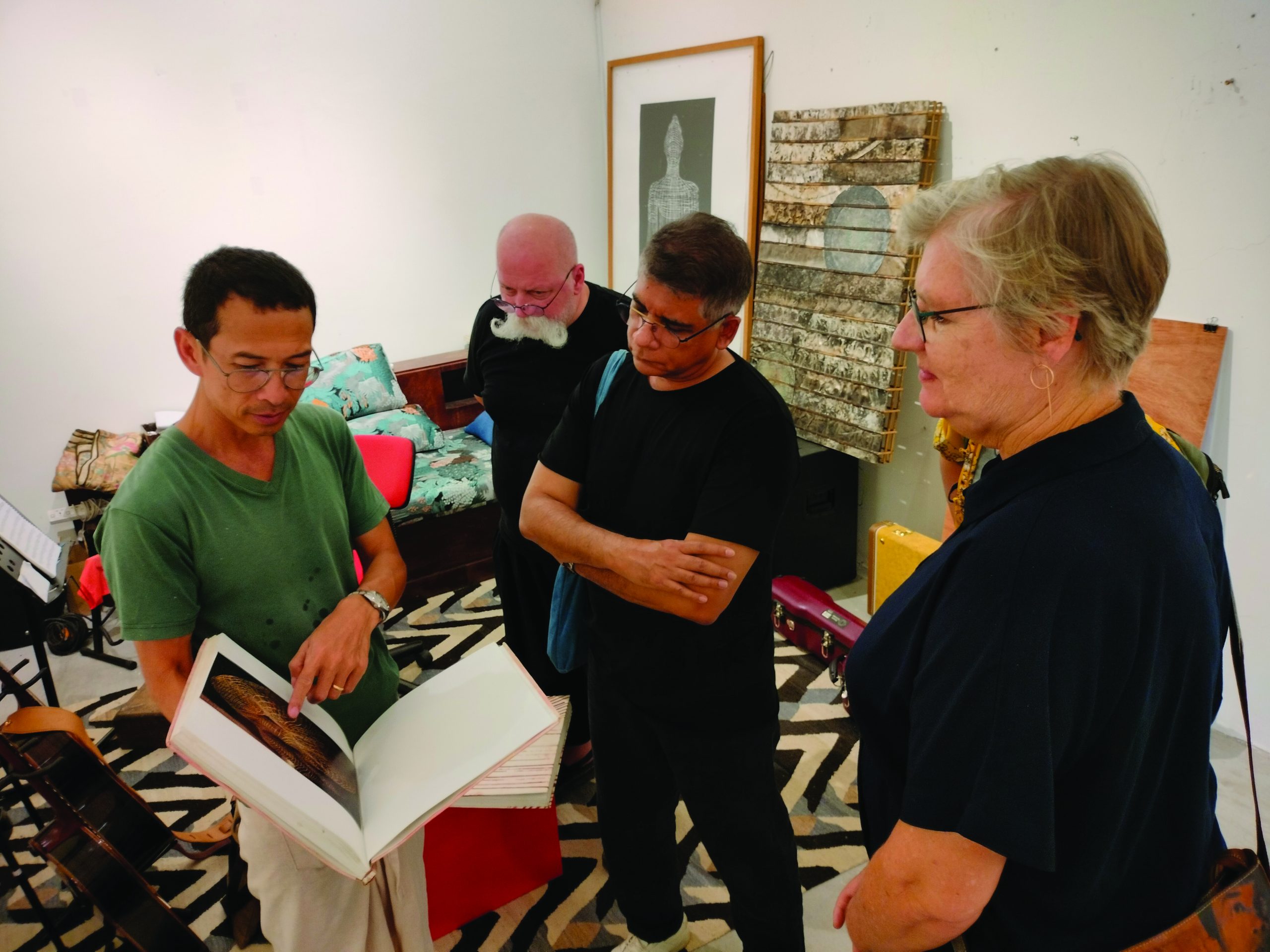
From left to right: Sopheap Pich, Milenko Prvački,
Venka Purushothaman, Mella Jaarsma.
Sopheap Pich studio in Phnom Penh
Venka Purushothaman
But it is perception that you’re suffering because you’ve said that the sculpture is an extension of who you are.
Sopheap Pich
But I’m not suffering, only other people tell me I’m suffering. People say well you have a Master’s degree in painting, you were teaching for thousands of dollars a year, why don’t you stay and teach? And I say well, you know…But I think the battle with that negativity also allows me to continue too.
Mella Jaarsma
Yeah, that happens… It’s like, also people thought I was crazy to move to Indonesia. Is there art in Indonesia? That was always the question especially in the 1980s. When I came to live there I ran the Cemeti for 10 years during the Soeharto regime. People said I was restricted. But that is also the interesting thing in the sense that art can somehow find its way to comment on the dictatorial regime. Working in Cemeti gave space to artists who found clever ways to create works that tell the story of what was going on politically, without being caught for censorship. We had spies coming to exhibitions but they could not put a finger on it.
Sopheap Pich
Sorry to interrupt. Your story reminded me of Samnang’s Rubber Man where he was naked in the indigenous plantation and had to deal with the police. He has an amazing story I wish he would tell.
Khvay Samnang
Yeah, I don’t know, under Cambodia law if you are naked in public—15 years in the jail!
Mella Jaarsma
Oh my god!
Khvay Samnang
And for me you know, researching that time, land rights, human rights, and concession land had many problems in Cambodia around 2008 onwards? And in 2012, the government starts to help the builders, giving the licenses, and getting students to work for them. For example, second-year university or graduate students were engaged as volunteers in land redevelopment—they were given the costumes, military costumes— to measure land under a land-titling program; at the time, there grew protests from villagers and rights groups to protect the environment or their land rights.
So that time I came to research this and asked for volunteers from the area to help record and document. One of the students was my friend and we lived with them in the plantations. Of course, they all respect one spirit house nearby, what I mean is a forest spirit (Neak Ta) you know? There should be many trees there but there are only a few trees left near the spirit house. This shocked me! When I returned home to Phnom Penh, I had a dream: one white guy comes into my dream and showed me around different landscape with systematically grown trees [like in plantations]. Maybe he’s one of the spirits who had lost the house when human.
That’s why I started to follow my dream [that led] towards a rubber plantation in the north of Cambodia—and to walk around this landscape. The rubber plantations were planted during France colonisation, the French had obtained the rubber tree (‘cry tree’) from Brazil. During 1960s King Sihanouk [increased the plantations] after we got Independence from the French and the people were made to go and live on them to protect the Khmer border. But not many people went because they didn’t have support, like if people got sick with malaria.
During my research for the Rubber Man project, I visited many different plantations and there were different ages of rubber trees from four-year-old trees and a bit further, it had two-year-old to one-year-old trees from Mondulkiri province to Rattanakiri province to the border of Vietnam. I have a question, you can imagine—where is the forest?
And then I started to collect the rubber [latex]. I never knew before that rubber could ‘kill’ (affect) my eyesight [which happened] or how sticky they are when they are on my body and yeah… but finally my eye can still see. I [continued to] follow my dream: I was dreaming about one indigenous village which has all rubber plantations around this village, I have to question how the indigenous lived because they live by nature around them: they picked things from nature and hunted for a living etc.
After that I saw one village in my dream that had land concessions around it. During this research, [I found] this village; it was so quiet. Good for my performance and shooting. But on the day I arrived to shoot, many people and kids came. I said to myself: oh my god, I need to do, I need to do, I need to finish. And I said to everyone, please go home! They said no, they want to see the performance. I said, I’m naked, is that okay? They said, yes! So, I took off my pants and poured a bucket of fresh rubber on my body and then I went deeper into the plantation and then I saw two women in their traditional clothes. At that time one person called the village chief to report my performance. The villager came and used his mobile phone to take a video of my performance. And I ran around and my face is so ugly like a ghost.
Sopheap Pich
Full of rubber, you poured it all over yourself, right?
Khvay Samnang
Yes. The cameraman is my friend and not a professional. His camera shook a lot when walking and I had to direct the shoot myself: I asked him, please take portrait, take landscape, everything of mine. The village head was angry with me: “Why did you do this? It is not nice to do something like this in our village.” I think: “Oh my god! I don’t know what is going to happen to me.” And then I went to the car, and my Cambodian friend who has a rubber plantation business and know these village people, said to the village chief, “who are you and why you don’t know me?” Luckily my friend knows some kind of black magic or you can say ‘Charm’. My friend called [out to] (Charm) “hey! Come, come, come, this is my friend, we just come for test shooting. The Charm says it is okay to the village chief. Today, just rehearsal, not yet shooting, tomorrow we can come back to do the shooting?” The village chief [then] said yes.
My other work was at Areng village, Koh Kong province; it had one Chinese company wanting to build a dam there. Community people protested and government blamed the opposition party or human rights NGO and activists for helping them for land rights. But the community doesn’t care about politics, they care only for their land and nature. This village has complex politics. My students connected me to activists there. And then, the community, what do they think of me? They don’t want to give me rice; they say I’m a spy of China, because my face looks Chinese. And what would the police think of me? What am I doing? Police think I am an activist or NGO, or something like that. So, I need to find my own way to research between community and police. Finally I finished my work.
After I finished my work, I go to join a party or wedding ceremony there, one guy comes to me, “Oh! This is Samnang? I know your name, do you know me? I spy on you!” And this policeman comes to me, and he drinks with me, and he say, “Oh Samnang you finished your work?” [To these] mostly I say fine. During the shooting, I needed to hide some masks in my friend’s house. Sometimes when I get there in the evening, I go directly to the jungle for the shooting. Let’s learn, let’s play, let’s adapt, experiment with this: this is normal for me.
But this is the artist’s response or like what I can say to what is art in Cambodia? For me, art is education, you know?
The path of the question, maybe [lies in] imagination like the Angkor empire; Cambodians know about art through dance and Apsara sculptures around the temples. Modern painting and new kinds of technology or photography is less known since the war. During French colonisation in Indochina (Laos, Vietnam and Cambodia) the Cambodian arts came under supervision of Mr. George Groslier. In Saigon, the most capital of cities of the French, the French think they should be teaching modern painting. But in Cambodia, most French here really loved our culture. They want to keep it as is. But why? And who teaches modern painting?
Two paintings of Mr. George Groslier, who was art director [Museum of Cambodia], is showing at the National Gallery Singapore that was curated by Roger Nelson. Roger saw Mr. George Groslier’s work on auction in Paris and [they are] now displayed in Singapore. I haven’t been there specifically, but [Groslier] knew modern painting. He painted the king, keeps our Cambodia traditional. During the second World War, Japan took over Cambodia for a few years and the King asked one soldier, named Suzuki Shigenari to teach modern painting in Cambodia. After the war, he taught at fine art school, [from which] one group [emerged] that became famous with a new style of painting. [But] 90% of the artists were killed by Khmer Rouge and only 10% survived.
The most important thing that Cambodians think and feel first, is dance. Foremost is dance, why not painting, not sculpture, not anything? This question is raised by Dr. Toni Shapiro Phim, asked during her research with refugee people that survived after Khmer Rouge. Dance is the soul of Cambodia; this is the spirit of Cambodia because [if] you can imagine, in dance no one can watch the dance easily—only a few. It is for the king and other ceremonies. This is the dance with a kind of language connecting human to the god and the god to the land.
Venka Purushothaman
Samnang, you started with land rights and brought it back to the idea of what you talked about spirituality. That all land has spirituality, all art has some sort of spirituality, not in the conventional description of spirituality, there’s something that makes that connection somewhere. Maybe that’s what makes it particular to that moment in history.
Mella Jaarsma
Yeah, but it’s also like if I compare with Indonesia in the 1980s, the art was sort of pushed by the regime to show the spiritual, abstract aesthetics, because in that sense you did not need to talk about the politics and what was really happening. So, to connect the spiritual as the international identity you know, you sort of cover up what was really happening on the ground.
Venka Purushothaman
So Mella could you elaborate on the idea of spirituality in Indonesia because the government also came up with the Pancasila?
Mella Jaarsma
The Pancasila, or state philosophy, was created at the beginning of the Independence, during Soekarno’s era. But during Soeharto’s time, the art had to be more inspired by traditional art forms, in that sense for the shaping of a national identity. This idea of the connection with the spiritual and formal way of painting, was taking away the attention to show what was happening on the social and political level, you know, and critical art that had already started as a movement against the Dutch during the Independence movement in the 1940s. So, there were like these two streams—the critical artists and then the artists who were more like, following the mainstream and being more say, spiritual or religious. Like Islamic influences are important, so there are some abstract painters explaining their work as being spiritual, and this was also reflected during that time in the education systems, through the art schools, especially in Bandung.
Milenko Prvački
I think it’s very interesting what you say. I find not only that we are all born or displaced but we have survived the same, similar ideas of countries trying to impose identity you know because that saves space for them. And the one who they—all countries— always want to control is the artist because we are very good at finding holes and leaks, so that idea of control is through imposing an identity or imposing spirituality. I call it imposed identity or imposed spirituality, [and] especially when you put national identity foremost, this may lead to more readiness for conflict and war you know? Because what is ‘national’? We are so different, and the idea of art is to be different, not be the same. And I always used to tell my students they have to find their own language, and voice, and I always tell them about my case because I didn’t speak English when I came to Singapore so my accent is very Serbian and my English is not perfect and I was telling him that we are all different, we look different and speak differently, but can you imagine if I suddenly start to speak perfect English you know? There’s something wrong, it’s not my identity. So, we carry these things and it’s just that in time the identity will be formed but that obsession with heritage is always a mistake because we are creating each time, we are creating heritage, it’s going to be heritage.
Sopheap Pich
But what’s disappointing to me, is when the so-called experts in the culture industry who run cultural spaces, they run the customs they are familiar with. I do not necessarily mean the ministers, we won’t be so aggressive as to attack the ministers but the people who are you know, the so-called experts. I was often times attacked, all the time actually, in the early days. They don’t really do it anymore because now my work is in the museums so they figured if they attack people whose works are in the museums, they kind of look silly, right? But my work was not always in the museums, you understand what I’m talking about? There are people who give lectures on Cambodian art and they will use my work as an example as someone who is like a thief. I am made to feel in my sculptures that I am taking baskets for free, away from farmers’ sweat and tears you know.
Mella Jaarsma
Oh, so that’s how they interpret it?
Sopheap Pich
Yeah, that’s how they interpret it! They put it on a slide and they say, “What is this? This you can see on the road! This you can see on the farm, how come they don’t put that thing on the farm, get the farmer to exhibit at the galleries, how come they take this guy who just takes the technique from the farmer, and then make art, so-called art? This is not art, this is not Cambodian art!”
Khvay Samnang
I would like to comment on that because I work mostly with dancers and in performance—basically from mask dances. It’s a traditional Khmer dance. I worked with two dancers; they had trained since they were eight years old, they become professional dancers. We enjoyed working together. The most I will say is, I’m not a dancer. When I talk about my projects, I question them, my work is very critically [engaging]. So, I asked, do you know how to swim? As my project sometimes is not very nice, sometimes we need to perform in the river, in muddy waters and it is not like performance on stage in the theatre. No beautiful costumes. And then they said: “Yeah!” They love new freedoms and experimental work. I don’t know if the government likes it or not. But after my project finished, the work has toured around; especially last year I joined a conference and workshop with master-dance teachers and other dancers, [where] I presented my work, and they loved it and they were appreciative of what I did.
Sopheap Pich
I think [the same] in this culture, I’m very close to the dance and the performing arts as well because I was involved with a few art organisations when I first moved to Cambodia. What I experienced is that in a culture where we feel things are being lost and we’re all trying to gain it back we all feel this sort of ownership. But we also have this tradition of reverence toward our teachers and the teacher’s feeling is hurt when a student changes, right?
[You hear:]“You’re breaking my heart if you change what I taught you. If you modify, it means you disregard what I taught you!”
Milenko Prvački
It’s a very good example of what I talk about [regarding] nationalist approaches, looking for nationalist language or style or methods for artists. I always question how come they didn’t introduce national mathematics. And that’s the idea of…but again to come back, it’s always addressing this problem of restricting artists because our ideas are ‘leaking,’ and they can’t stop it. I like to say ‘leak’ because it’s out of their control. It’s always some hole that opens up, and I remember in Romania we didn’t exhibit some artworks for 35 years but then they were exhibited after that period, and are very popular, you know like [what happened with] Chinese art after the Cultural Revolution. You know, you can’t stop it!
Mella Jaarsma
In Indonesia as well, you can’t stop it. It is about criticising. Especially after Soeharto resigned, we entered the reformation era and then it became sort of popular to look back at the past and create art full of comments on the political and social circumstances. I mean finally it was possible to dig up histories, reflect on the regimes but also colonial history, up till today.
Sopheap Pich
It’s the artists who make art not anybody else. It is the non-artists’ job to actually try to understand what is being made and conveyed. Maybe bring themselves down a little bit to our level and say hey, what are you doing? Instead of saying “no that’s not what you’re supposed to do.” How do you know? You’re not an artist, how do you know?
Mella Jaarsma
Yeah, but then so, what is interesting is also like, it creates different levels once the work is up there, it can do different things. So, for example [the collaboration] with Agus Ongge, was made in 2021 for the Jogja Biennale and we were invited again last year to show that work in relation to the G20 summit. The G20 was in Bali and then the Ministers of Culture were invited to come together at the Borobudur.
Khvay Samnang
I was there.
Mella Jaarsma
Yes! Because I was showing a video of my collaborator Agus Ongge [who is] from Papua (Indonesia); I interviewed him and made a video documentation. He could not come because of Covid and then, during the Ministers’ visit, this video was censored. [In the interview] I asked him all of those questions about the past and he was really honest telling everything about the history of Indonesia and what happened in Papua and this video was not allowed to be shown to the Cultural Ministers from all over the world you know?
So there is a freedom now, but then [it’s] also related to, of course the tradition which is always viewed as something very positive. [Nevertheless] there are things they want to censor, so we had to change the wall text and everything. But in that sense, it always has an impact, right? Although you think it’s just an artwork.
Sopheap Pich
Well, if you didn’t do it then you wouldn’t pass that threshold. It’s totally choreographed, right?
Mella Jaarsma
Like we have now the Minister of Culture, he’s like a historian, not an art historian. He’s critical and educated so he’s doing all those interesting projects. Finally, we have support for artists and art infrastructures. But yeah, we don’t know [what will happen] next year, there’s a new election, we don’t know. And that’s the problem, it always changes and you don’t know. So you build up something and then by the next new political situation, you can start from zero again.
Venka Purushothaman
When an artist becomes a politician, decision maker or policy maker, their discipline may shape their decision-making. For example, if they are a traditionally or classically trained artists, their process may be more instructional to you and tell you you’re not following the rules. But isn’t it the beauty of coexisting systems, because tradition is learning to build a rule book, and institutionalising the form in different ways, while in contemporary art practice, it’s about unleashing the individual, in their full manifestation before it becomes contextualised.
Sopheap Pich
Being a contemporary artist, we still learn from the past, we wouldn’t be doing what we do if we don’t know the past.
Venka Purushothaman
True. But you don’t hold the tradition for yourself. In a sense, because you work with tradition.
Sopheap Pich
We don’t need walls around ourselves.
Venka Purushothaman
And hence you become more difficult to manage.
Sopheap Pich
Exactly!
Comfort in Cultural Practice
Venka Purushothaman
Absolutely! And we have knocked on the fact, that in the future, there are ways to manufacture concepts of nationalism through comfort. Comfort as the national, the national objective. The comfort of funding, the comfort in finding allies in museums and critics, the comfort of acknowledgement.
Mella Jaarsma
We have that as a sort of similar problem in Indonesia. Curators since the beginning of 2000 became powerful. So they set the theme of the exhibitions and then artists, young artists especially, started to work along the taste of the curator or the gallery and according to the theme and they have no time to think and consider what do they really want to address actually, so it was really just following the demands.
Venka Purushothaman
Because this is something that… there is this kind of level where the ministry comes in, education comes in, the curators are coming in, the historians are coming in, everyone is putting a particular kind of demand. So going on your journey of self-discovery you know, art is about that self-discovery, that journey that you go through is also going under a lot of pressure to quickly professionalise so that you can speak to this. And so that’s what happening to students, young art students are being asked to be professional, but your practice itself needs to evolve.
Mella Jaarsma
It has a certain, what do you call it, rhythm, time. Sometimes you cannot force this it just has to naturally develop.
Venka Purushothaman
That’s right. I’m interested in your experience as to what this rhythm means because it is an important question to the history of art because it’s one of the key things in the notion of any form of play. Artistic practices are very much tied to individuals and a good ally to that is the philosophy that someone works through, not so much the social, the economic or the national. [Sopheap: Exactly!] In a time, under the guise of professionalisation of some form or way like you already pointed out, curators shop and transact artists, rather than help build a very strong point of inquiry.
Also, Indonesia has some serious art collecting going on. On my recent visit to Jakarta and Bandung in February-March 2023, I was taken by the new wealth and also the one-to-one number of collectors to artists. There are so many collectors’ shows, collector-run or sponsored spaces all of which are good as they build cultural capital because governments or artists cannot do it on their own. I still think it’s generally good for art, but I put forth the question in this active ecosystem, is the artists’ space shrinking?
Sopheap Pich
Well, taste becomes a ruling party. It isn’t knowledge, deeper knowledge.
Khvay Samnang
Can I mention a bit about our collective, Sa Sa project— you know about that? Sa Sa Art Projects is run by a collective since 2010, but we first met in 2007 because we studied photography together. After that, we were thinking [about] how to stay together, sharing information, sharing the work and helping each the group is small but grows. We make work together, we make a gallery to showcase our work and [reserve] one-half [places] for emerging artists. In Cambodia, we have mostly cafe galleries but art students, they don’t go there. And our project is to think about the ecology of art, and we are teaching three classes. One contemporary art class is taught by me, one photography—documentary and contemporary— by another co-founder, and [one class] English for artists by another co-founder because no artist know English like Bong Sopheap. I learnt English very late and started talking in English in 2010. We also do experimental residencies with different invited artists from the region. And documenta fifteen, curated by Ruangrupa, gave us an opportunity to develop and showcase our communal space, like a kind of working space, like Rong Cheang [a Community Art Studio].
Venka Purushothaman
Mella, did you have the same experience in Cemeti?
Mella Jaarsma
The first days in 1988 or the first years there was nothing, so when we started it was a bit like Sa Sa Art projects, [that] just started from an urgent [need] also you know? First, we focused just on exhibitions because there was no space to exhibit and the largest art school is in Yogyakarta. There were very few exhibition spaces, so we just rented a small house, and the front room became a gallery and then we started to show works from our friends first and then it just developed like that. And now we’re doing residencies as well and things like that.
But I think that’s also the importance of communities and that’s also why in Indonesia there are so many communities. The artists become critical towards their educational systems and they start with creating their specific communities, to learn from each other. They are eager for discussions, and communities are founded based on different principles; for example, based on a discipline like photography or new media, or sometimes it’s because they were in one class in art school. So there are different communities related to different ideas. It becomes like a safe playground to be in a community and develop in the community and then yeah, most artists in that community have their own career, successful careers, and then they give back to that community for the regeneration as well. That happens a lot in Indonesia, but [laughs]… yeah maybe it’s good to have a bad education system, because then the artists gain a critical attitude, and then they develop something differently.
At Cemeti, we started with a residency programme in 2006 with the idea to create an opportunity for artists to think about what they are interested in actually. We paired them up with researchers and gave them assistance to experiment on all kinds of things. So, to do a residence of three months is very intensive; [it] is a starting point for further development, so this process is very important.
Also, in Indonesia, we always depended on invitations. Since the Reformation, we realised that as artists, if we want the government to reform, we have to be part of the process. So we also have to include our government and to educate them. So we have to inform them what the needs of the artists are, so we had all sorts of focus group discussions with people from the Ministry of Education and Culture, and Creative Industries. It really became a dialogue. So this year for the first time they give grants to the artists and artists’ run spaces, it’s the first time after so many years—25 years of reformation already, so it’s a long process.
Venka Purushothaman
I want to return to this point about being a professional. It comes to an important point that all of you touched on, about and also getting the ‘professional’ to be able to curate it to help make sense of it both for the artist and the community.
Sopheap Pich
And then, there’s something else. There’s curation, so-called curators. Just because you hang some paintings on the wall, paint some wall, or put up the lights, you’re not a curator, that’s not curating. That means an organiser at best, right? So then this becomes also… I mean I’m not a curator, I’ve never done it in my life but I respect it because I like to work with good curators. And I respect what they do, they read, they write, they study, they really do their homework and then you have kids who come and say I’m a curator! Really, what have they done? That said, I do participate in many local shows when I’m asked because I support and want to encourage the culture.
Mella Jaarsma
Yeah, in that sense I like to support young or emerging artists and curators’ projects, because then I’m also part of the discussion. So that’s mostly also maybe why I participate, you know?
Sopheap Pich
If you have shows all the time as a young artist, you’re making work for the show. It’s unhealthy to think that every work I do is for a show. You need time to play; you need time to see something that is dangerous, that is bad, that is ugly, that is not right.
Also, I’ve seen a lot of artworks, and I think that this work does not belong on the wall in a public space. It doesn’t. It needs to go, and the artist needs to go back to her or his space and look deeper before you show.
Current Trajectories, Material Study
Venka Purushothaman
I want to come back to your own material studies, in terms of your choice of material, and how are you negotiating that space for yourself in your practice?
Mella Jaarsma
For me, material is very important because the choice of material represents the concept or brings the concept forward. For example, when I started to work with frog skins, I started to work with frogs at the end of 1998 when there were riots in Indonesia to get rid of the regime. The black sheep in the society were the Chinese people, who has lived there already many generations. When politics are tense, they are the scapegoats. This relates to the colonial past where they were sort of the people in-between the locals and the colonisers. They had better access to education, and they were the traders. So after the Independence, when the Indonesians came into power, they pushed the ethnic Chinese people down, they are discriminated against and could not work for the government and things like that. So when there were some tense situations in Indonesia like in 1998, their shops got set on fire, the women got raped and whatever, really disgusting. So yeah, I started to do a performance on the streets frying frog legs, because it is a Chinese food and yeah, my being Dutch, also being a minority and then part of the colonial background as it was the Dutch who settled those systems, so I asked all the white people, all my white friends living in Yogyakarta to come with me to fry the frog legs and discuss the situation of the Chinese and what happened the few weeks before with all those tensions before Soeharto resigned. So I used the frog legs as an idiom, you can say that, to open up that question with the public. So I was sitting in the main street and frying these frog legs. It’s unclean or haram for Muslims, it’s like pork, you know? But interestingly, in the end, all the frog legs were eaten. I used my position as a white person in that sense, because people passing by in the street got curious… why are these foreigners sitting in the street frying frog legs? They came close and started to ask why and automatically discussions took place about what happened with the riots a few weeks before. So choice of material is so important.
After that I started to make costumes, the first one I made were of frog skins in the shape like a Muslim veil, but the material was frog skin, to create this contradiction. The first time I exhibited this work in Bandung and after that in Yogyakarta, I had to write a statement, so as not to upset the dominated Muslim public. I wrote down what it meant and why, because it was quite provocative. So that’s the first costume that I created. Since then, yeah for me, the material choice is very important because it brings the meaning of the work out. And until now, not all the works start from that sense, but yeah, material-wise, it is important. And also how then finally, the piece comes together, because I believe that every material has a certain logic—how to, for example, sew frog skins together in a pattern, I mean yeah, I never thought about it before. When the material is in front of me, then automatically there’s is a logic of how to put things together and create it into a shape.
Venka Purushothaman
And what are the current materials you’re working through?
Mella Jaarsma
Barkcloth, because before [loomed] textiles entered Indonesia, everybody was wearing barkcloth like loin cloths or sort of dresses. The barkcloth is mostly [found] in the inlands. Through a residency in Vienna in the World Museum I found these piles of barkcloth costumes, something you can hardly see in Indonesia because it’s always about batik and ikat, so I did research on that and found a book of two missionaries written in the beginning of the 20th century, 1905, to be precise, in a certain village in Sulawesi. So I went there and then I found the community of women still making it you know, so they’re still producing it. I made a documentary about them, and then I started also to learn myself how to make it, and I made some costumes out of bark cloth, communicating the colonial history.
Lately I collaborated with the Papuan artist, Agus Ongge, who also works with barkcloth, but he makes paintings on it. In Papua, at Lake Sentani, barkcloth was used as a sarong, loin cloth or a blanket, with painted motifs on it. But the Dutch missionaries came—and also later in the Soeharto era—and they had to destroy or forbade the use their traditional objects, in order to be converted and modernised. So, I had [carried out] this research with him, and then during our collaboration project, I brought back the barkcloth paintings made by him into wearables. So that was one of my latest projects, related to many things, to the material itself that actually also relates to the past as well as the present.
In some of his paintings, Agus Ongge uses the motif of the sawfish. I learnt from him that it is an important principle, that he paints the same image of the sawfish over and over again. It was last seen in 1972 at Lake Sentani, the lake in the east of Papua. He repeats just to keep the next generation remembering this extinct fish. I love this idea as a contrast, because we contemporary artists always have to look for the new, but [here] he works as a contemporary artist [concerned with] repeating. I recorded this conversation and made this video reflecting the visual art history and developments from this marginalised eastern Indonesian province.
Sopheap Pich
As a painter prior to being an accidental sculptor, I was trying to find how to make a sculpture, I mean, I didn’t have any strong political or social agenda or want to make any kind of commentary and, in fact, I was trying not to do anything that would make any commentary.
In 2002, two years after grad school, I came back here with basically two suitcases: one was my art materials from graduate school, whatever I had for painting, brushes, and stuff that I was still able to keep; and then the other suitcase [held] just my clothes, so I didn’t have anything to work with and I didn’t have any money. I had US$3000 dollars from selling some works when I was in Boston, that I had left after buying the ticket, so that’s all I had. So I struggled with painting for the next two to five years? In 2004, when I felt like I didn’t know what to paint because my head was full of subject-matters, too much that I could even slow down enough to even focus on anything. And I was very much just listening to the radio all the time about Cambodian politics and I’m learning, and I’m thinking about my relatives: they live in huts, they live in the countryside, they still go to the bathroom by just poking a hole in the ground. So it was very strange to me and my heart was stuffed with anxiety and you hear on the radio all the time, and all the politicians from all the political parties were loud, everybody was loud. There was a lot of chaos.
It was a time when everything but the Buddha was on the cigarette box. And so, I was like, what do you do here, what am I doing to quiet all that down, which meant putting the brush away and making something about things that affected me, which was smoking and drinking! In reality, everything was just around me; the thing that I was suffering from is smoking and drinking. And then I thought, maybe I should make some work about my internal organs because that’s what I think about most, or that’s what I feel about most, not think about, I feel about. So I said maybe I make something that I feel, not think, so that’s kind of the entryway into art, really, my own art.
When I made my first sculpture, I made it out of rattan because, well, I don’t have any skill, and I don’t have any material; there were rattan makers across the street who made furniture. Now you have wood and stuff from all over, but before that, it was all rattan shelving, chairs, everything I owned was rattan—and it was ugly. I hate rattan furniture. But for artwork it seems like, wow—if they can make volume,

From left to right: Mella Jaarsma a, Sopheap Pich, Milenko Prvački,
Khvay Samnang, Dr Venka Purushothaman, Reaksmay Yean.
YK Art House/Silapak Trotchaek Pneik Gallery, Phnom Penh
and if they can make it strong that you can sit on and put stuff on it, and you can make beds, you can make whatever, then I can make a sculpture out of it. So that’s kind of how it happened. But more importantly, when I started making my first sculpture, I felt so happy; for the first time, I was like oh! This is like making a slingshot, this is like making a toy boat, this is like making things that I used to make to occupy my time during the Khmer Rouge.
Venka Purushothaman
Sopheap, how did [the idea of] the material form with your work?
Sopheap Pich
I was sharing a house with two artists, and Guy Issanjou, the French Cultural Centre Director at the time, came to see us and he saw my sculpture on the floor, lying on the floor against the wall and he told me that’s the first modern sculpture he’s ever seen in Cambodia. And it just took me for a spin. And he said to me: “Listen I’ll buy some photographs that you made, I’ll buy it from you for US$2000 dollars, and you take that money, and invest it in the rattan, and maybe you can get another person to help you cut the rattan, and then you just spend the next three months to make sculptures, if you want to make sculptures.” So for next three months, I was by myself, and I made sculptures, and I got an assistant to shave the rattan, and then I built my first group of four sculptures.
Venka Purushothaman
[Samnang], how did your materials emerge?
Khvay Samnang
As students we were stubborn. New media was starting. I’m a graduate of modern painting you know, and I also learnt photography for one year, just very basic: how to take photographs, and also some art history of photography too. I enjoyed photo landscapes because I’m painting with the landscape, we do a lot. And I think this is why I love photography because I think that I still paint though I use light as material including digital lights, and I am still painting the landscape. You know all my work is about the landscape [around me]. I find the material (light) works in different places. For example, at a people’s protest against moving sand, people were attacked with sandblasting, and as they were escaping from the mud, it looked like a killing scene of humans by sand. The sand is [either] moved to Boeung Kok lake in Phnom Penh or sold to Singapore. A lot of things [occur] in construction which are covered in the news, and some news reported that some families were crushed in their house at night, [they] died. So, I wanted to find out for myself and took a boat [there], and then I wanted to take a photo of people from the village in front of the crushed house.
This is a kind of material I use and some people ask me, how is this art? I open my thing depending on the story, the situation, and even my body. I think everything around me is my material in my performance and my participation.
I talked to a mother in the space and [asked] if I could shoot her and she agreed to wear the mask I have. Her daughter came back from school and she was angry. She said I looked down on her family and had given her mother a dirty mask to wear. She threw my bag out of her house and brought a knife and tried to cut my brother, who had accompanied me to help me on the trip. I told him to run. My brother ran off! I told her: “Please, please I talked with your mum already please, put [the knife] down and I can talk to you.” We sat down, I explained to her and then she drank water and then calmed down, and I said: “I will not show your mother’s photo or anything. I apologise.” I explained I think this is art. And then I came back home, and I am very sad. I think, what is art? If people understand they will appreciate it, but if they don’t understand, they will be angry. Then I feel like I’m hurting people.
But then I thought, okay, I still want to say something about the river, the grandmother and granddaughter who had died in the house that was crushed at night. The village chief said it [had happened] at night and they didn’t have emergency equipment to help them. And I [thought], how little can they breathe in the mud, and how can they escape from the mud, how much they hurt, you know? I questioned myself, should I stop working on this project? Or should I need to find other way to do it?
So, in telling [you] about bodies in motion, I found a dancer Nget Rady who is so experimental. I ask him if he can swim, and he said he is a good swimmer. I said: “Ok! Lucky!”
Looking at the location of the crushed houses, I [returned] to the house where the daughter had tried to cut me. I shot my dancer in front of her house. And then at another place in front of the Mekong River, where the machine had moved the sand to Boeung Kok Lake. And then I explained to the dancer that, your body or your soul is floating on that. I drew a storyboard for him, [to show him] this project was dangerous, and then I said to the dancer that I will swim together with you, shooting you, if you die, I die with you.
Venka Purushothaman
So you don’t rehearse, you don’t plan, you go on-site and improvise?
Khvay Samnang
Yes, but I did research and plan [just] before the experiment.
Turning to another work, the jungle one, with a mask. This is after the censorship of me, the village and the community began to understand me. I go [there] to research talking about the spirit, talking about believing, talking about what is important to them and starting to drink alcohol a lot. I started to make animal masks paying respect to different animals. Because the animals have been around all generations, they tell us about this and still respect them, until now. And for me, I’m a city man, I come and can see, but I feel like, this [is] what humans know [too, but] they do not respect animals and nature? You know, those who are living in the jungle, they respect the animals, they respect the spirit forest and think about how to save the environment in the world. I feel like in the city, where developers always want to do more [to ‘develop’ land], we have lost respect.
So for my other work, I decide to work with traditional performers. This is kind of interesting for me, the philosophy of dance, like a circle of life, like a seed that drops on land and grows into a tree and then turns into a leaf and then becomes a flower and then becomes a fruit and then falls and regrows again, it’s kind of like that. For me, this is relatively the history of the colonised and with the circle of life of us that we can see from the past until now, we are like a circle of politics, always. With something political, you know how to colonise but [today to do so] differently—like the economic colonisation, something like that. I created the work Popil to [show] the ritual of Cambodia, from birth to death and the continuing cycle.
Venka Purushothaman
In your performance works one thing that gets visualised for me from our conversation is that you get chased around a lot. Someone is chasing you with a knife, chasing you in the jungle, you get chased a lot. You know you’re running.
Khvay Samnang
Yeah, yeah, the most important thing is that we are scouting and shooting. I am working in restricted places. I ask: How/why am I shooting this? But I believe in art and it is a part of education. And what I want to do, I will do it even if it can be dangerous for me.
Venka Purushothaman
The performance work that’s emerging is in-situ, you know in that kind of location and it’s also what’s quite interesting, you know, when we talked about frog or crocodile skins with Mella, it dates particular moments in history. Here, you’re talking about a live event (rapid redevelopment against the environmental and human conditions) that’s unfolding in front of you. It is a live commentary.
This dialogue has been far more enriching than what we set out to do. I thank you very much and hope to continue the discussion. Still, the areas that we focused on actually crystallise the conversation on how we are looking at the notions of play: ‘play’ in live spaces, historical spaces, and material spaces. I thought the two dimensions of material and environment came out very strongly presenting how artists working in Southeast Asia create new ecologies of practice and learning. This conversation gets into the pulse of what Southeast Asians are also going through as shifts around us are rapid. Importantly, the issue of decoloniality and how are we thinking through the new spaces is a concern that we all have. What is available to artists, what are they searching for as they explore, and how they deal with the comfort of nationalising their practice are important and emerging dimensions in a truly porous world.
All photos courtesy LASALLE College of the Arts.
Contributors’ Bios
Contributors’ Bios
Samit Das (b. 1970, Jamshedpur, India) specialises in painting, photography, interactive artwork and artist’s books. His art expresses multi-sensorial geometry through art and architectural installations. Das studied Fine Art (MA and BA, 1989-1996) at the Kala Bhavan, Visva Bharati University, Santiniketan and Book Arts (2001-2002) at the Camberwell College of Arts, London, through the Charles Wallace India Trust. Das has a broad interest in archiving and documenting material culture and new challenges in visual arts. He is deeply interested in the history of material culture and its impact on visual arts and art history. Das adopts weaving history and archives in his art practice, with environmental consciousness and the use of sustainable technology. His visual vocabulary evolved from a dialogue between Self and Me—creating an unfamiliar space with a new transformation of materiality—in a research residency at the Material Archive, Zurich University of the Arts in 2016 (supported by the Swiss Arts Council Pro-Helvetia).
His significant research on Santiniketan architecture is published in Architecture of Santiniketan: Tagore’s Concept of space (2013). Das was awarded the 2017 Pernod Ricard Fellowship to research the resonance of Paris as an influence on Modernism in Indian art through Indian artists who studied and worked in Paris during the 1950s to 1970s; the residency at the Villa Vassilief, Paris, was followed by a solo exhibition, Punashcha Parry. He has exhibited in India and abroad and his work is visible in public spaces in India.
FX Harsono (b. 1949, East Java, Indonesia) is a seminal figure in the Indonesian contemporary art scene. He is always updating his artistic language with current social and cultural contexts. Harsono’s art works point at the disconcerting situation of minorities, the socially underprivileged, against the backdrop of Indonesia’s own history and political development. FX Harsono studied painting at STSRI “ASRI”, Yogyakarta, Indonesia, from 1969-74 and at IKJ (Jakarta Institute of Arts) from 1987-91. Since 2005 he is a lecturer at the Faculty of Art and Design, Pelita Harapan University, Tangerang, West Java, Indonesia. Harsono is also an active art critic, regularly writing about social questions and the development of contemporary art.
He was awarded the 2014 Prince Claus Award from the Prince Claus Fund for Culture and Development, Netherlands; the 2014 Anugerah Adhikarya Rupa Award from the Minister of Tourism and Creative Economy, Indonesia; and the 2015 Joseph Balestier Award for the Freedom of Art, from the United States Embassy in Singapore and Art Stage Singapore.
Peter Hill (b. 1953, Glasgow, lives and is based in Australia) has won awards as an artist and writer. For four years he was attached to Goldsmiths College, London, as external examiner (Fine Art) at LASALLE College of the Arts, Singapore. Since 1971, he has choreographed several world-building projects (all ongoing) under the umbrella-term ‘Superfictions’. These include: The Avant-Gardians (1976); The Museum of Contemporary Ideas (1989); The After-Sex Cigarette (1989), The Encyclopaedia of Superfictions (1993), The Art Fair Murders (1994); Paintforum International (2014); and The Museum of Doubt (2015). Hill runs Superfiction workshops in art schools and museums around the world, breaking down hierarchies within institutions. He has exhibited in the Biennale of Sydney (Museum of Contemporary Art); The Museum of Modern Art (Oxford), and Auckland City Gallery. As an art writer, Hill has contributed to over 80 publications from Times Higher Education (Washington D.C.) to artpress (Paris); and The Financial Times (London). He is an Honorary Enterprise Professor at the Victorian College of the Arts, University of Melbourne.
Mella Jaarsma a (b. 1960, Netherlands) has become known for her complex costume installations and her focus on forms of cultural and racial diversity embedded within clothing, the body and food. She studied visual art at the Minerva Academy in Groningen (1978-1984), after which she left the Netherlands to study at the Jakarta Institute of Arts (1984) and at the Indonesia Institute of the Arts in Yogyakarta (1985-1986). She has lived and worked in Indonesia ever since. In 1988, she co-founded Cemeti Art House (now known as the Cemeti Institute for Art and Society) with Nindityo Adipurnomo, the first space for contemporary art in Indonesia, which to this day remains an important platform for young artists and art workers in the country and region.
Jaarsma a’s works have been presented widely in exhibitions and art events in Indonesia and abroad. Recent solo exhibitions include Performing Artifacts: Objects in Question, ROH projects, Jakarta, Indonesia (2022); The Size Of Rice, A+ Works of Art, Kuala Lumpur, Malaysia (2021) and In Ravel Out, Res Artis Project Space, Melbourne, Australia (2019). Recent and notable group exhibitions are Encounters, Art Basel with ROH Projects, Hongkong (2023); Crossing Ecotones- Mountains Seen ; No Mountain Being, Our Museum in National Taiwan University of Arts, Taipei, Taiwan (2022); Biennale Jogja XVI Equator #6 2021, Encounter with Oceania: Roots <> Routes, Jogja National Museum, Yogyakarta, Indonesia (2021); Transient Museum of a Thousand Conversations: LIR, ISCP, New York, USA (2019); The Sun Teaches Us that History Is Not Everything, Osage Art Foundation, Hong Kong (2018); the 20th Sydney Biennale (2016); Siasat, Jakarta Biennale, Museum of Fine Arts and Ceramics, Jakarta (2013) and many others.
Magdalena Magiera (b. Germany, based in Singapore) is currently Curator and Research Associate at NTU CCA (Nanyang Technological University Centre for Contemporary Art) Singapore . Her practice and expertise encompasses a wide range of disciplines, including exhibition-making and venue building; developing process-based research; organising lectures and conferences; and staging events and performances. She has worked with institutions throughout Europe, North America and Asia, including biennales, museums, and artist-run spaces. She developed projects with Rockbund Art Museum, Shanghai; dOCUMENTA(13); KW Institute for Contemporary Art, Berlin; e-flux in Berlin, Mexico City, and New York City; and frieze d/e. She is currently Editor of mono.kultur, a Berlin-based interview magazine, which profiles leading figures in contemporary art and culture.
Charles Merewether (b. Edinburgh, UK) received his BA (literature) and PhD in art history at the University of Sydney. He taught European modernism at the University of Sydney (1981-84), Universidad Iberoamericana, Mexico City (1986-88), and Universidad Autonoma in Barcelona. He received a research fellowship from Yale University (1991), was Inaugural Curator for the Museo de Arte Contemporaneo de Monterrey, Mexico, (1991-1994), Curator at the Research Institute, Getty Center, Los Angeles (1994-2003) and taught at the University of Southern California. He was Artistic Director of the Sydney Biennale (2004-2006); Deputy Director of the Cultural District, Saadiyat Island, Abu Dhabi (2007); Director of the Institute of Contemporary Arts, Singapore, (2010-2013); Visiting Professor at Nanyang Technological University, Singapore (2014) and Baptist University, Hong Kong (2015). He was Curator of Contemporary Art, National Art Museum, Tbilisi, Georgia (2016-2019). His books include: In the Sphere of the Soviets (2021); State of Play (2017); After Memory: The Art of Milenko Prvački (2013); and Under Construction: Ai Weiwei (2008). He was co-editor of After the Event (2010); editor of both Art, Anti-Art, Non-Art: Experimentations in the Public Sphere in Postwar Japan 1950-1970 (2007) and The Archive (2006).
Nasim Nasr (b. 1984, Iran) moved to Australia in 2009 and currently lives and works in Sydney. Since graduating with a Master of Visual Arts (Research), University of South Australia, 2011, Nasim Nasr’s art practice has engaged themes of intercultural dialogue and perspective between the historical and contemporary. Using video, photography, performance and 3D objects, these works highlight notions of cultural difference as experienced in her past and present homelands between West and East. Her artworks have been exhibited nationally and internationally since 2009; most recently at Sydney Contemporary 2022 and the inaugural Triennial of Asia: We Do Not Dream Alone, at the Asia Society Museum in New York, October 2020–June 2021. In 2018 her video Women in Shadow II was awarded a prize at the 10th Anniversary Edition of A Shaded View on Fashion Film, Maison Jean Paul Gaultier and Club De L’Etoile, Paris, being the video version of the multidisciplinary performance Women in Shadow II at the Powerhouse Museum/Museum of Applied Arts & Sciences, Sydney 2018. Nasim Nasr’s work has been reviewed in major publications, including Doing Feminism: Women’s Art and Feminist Criticism in Australia by Professor Anne Marsh, Melbourne University Press; Video Void by Matthew Perkins, Australian Scholarly Publishing; Performance_Ritual_Document by Professor Anne Marsh, Macmillan Art Publishing; Transorientalism in Art, Fashion and Film, by Adam Geczy, Bloomsbury and What is Performance Art? Australian Perspectives, edited by Adam Geczy & Mimi Kelly, Power Publications, Sydney.
Sopheap Pich (b. 1971, Battambang, Cambodia) received a BFA from the University of Massachusetts Amherst in 1995, followed by an MFA in painting from the School of the Art Institute of Chicago in 1999. His work has been exhibited extensively in Asia, the United States, Europe and Australia. Pich has had a solo exhibition at the Metropolitan Museum of Art, New York (2013), and has been included in many prestigious international exhibitions including the 57th Venice Biennale (2017) and dOCUMENTA(13), Kassel, Germany (2012).
He was a recipient of a number of important artist residencies, including the Rauschenberg Residency in Captiva, FL, USA (2017), Headlands Center for the Arts residency, Sausalito, CA, USA (2016) and the Civitella Ranieri Foundation residency, Perugia, Italy (2013). He has lived in Phnom Penh since his return to Cambodia in 2002.
Claire Roberts (Australia) is an art historian and curator with an interest in modern and contemporary Chinese art, and the cultural flows between Australia and Asia. She is Professor of Art History in the School of Culture and Communication at the University of Melbourne and a Fellow of the Australian Academy of the Humanities. Claire’s curated exhibitions include Xiao Lu: Impossible Dialogue (4A Centre for Contemporary Asian Art, Sydney, 2019); Go Figure! Contemporary Chinese Portraiture (National Portrait Gallery, Canberra, 2012-13); and Other Histories: Guan Wei’s Fable for a Contemporary World (Powerhouse Museum, Sydney, 2006). Her most recent books are Fairweather and China (2021), Ian Fairweather: A Life in Letters, edited with John Thompson (2019), Photography and China (2013) and Friendship in Art: Fou Lei and Huang Binhong (2010). Claire’s current research explores the international context of modern and contemporary Chinese art.
Khvay Samnang (b. 1982, Svay Rieng, Cambodia) lives and works in Phnom Penh. He graduated from the Painting Department at the Royal University of Fine Art in Phnom Penh, Cambodia. Samnang’s multidisciplinary practice offers new views on historical and current events and traditional cultural rituals using humorous, symbolic gestures. His work focuses on the humanitarian and ecological impacts of colonialism and globalisation. The development of each body of work is based on thorough research and investigation of local specificities, structures and conditions. Travelling is a crucial tool for his practice. Engaging directly and personally with local communities within and beyond the cultural scene is an integral part of his work, making it highly relevant, critical and connectable to various contemporary discourses. His work shows a remarkable ability to engage with cultural and geographic contexts as well as with spatial and institutional settings. His artworks have been presented in local and international venues, including major exhibitions and festivals such as documenta fifteen and ifa, Germany (2022); Tramway, Glasgow (2021); the first Helsinki Biennial, Helsinki (2021); Daegu Art Museum, Korea (2021); Children’s Biennale, Singapore (2021); Haus der Kunst, Munich (2019); Frieze, London (2019); Batia Saem Gallery, Siem Reap (2019); Art Gallery of New South Wales, Sydney (2019); 21st Biennale of Sydney (2018); dOCUMENTA(14), Germany (2017); Tomio Koyama Gallery, Tokyo (2022); Orange County Museum of Art, CA (2015); Jim Thompson Art Center, Bangkok (2017); Jue de Paume, Paris (2015); Queens Museum and The Jewish Museum, NYC (2015, 2013).
Milenko Prvački (b. former Yugoslavia/lives and is based in Singapore) graduated with a Master of Fine Arts (Painting) from the Institutul de Arte Plastice “Nicolae Grigorescu” in Bucharest, Romania. He is one of Singapore’s foremost artists and art educators, having taught at LASALLE College of the Arts, Singapore since 1994. He was Dean of the Faculty of Fine Arts for 10 years, and is currently Senior Fellow, Office of the President at the College. He also founded Tropical Lab, an annual international art camp for graduate students. He has exhibited extensively in Europe and USA since 1971, in Singapore and the region since 1993, most notably the Biennale of Sydney in 2006. He has participated in numerous symposiums and art workshops worldwide, and acted as visiting professor at Musashino Art University in Japan; Sabanci University in Turkey; and University of Washington School of Art + Art History + Design, USA. He is Adjunct Professor at RMIT University, Melbourne, Australia. He was awarded the Chevalier de l’Ordre des Arts et des Lettres from France in 2011, and the Cultural Medallion for Visual Arts from the National Arts Council of SIngapore in 2012. In 2020, he was awarded the National Art Award, Serbia.
Venka Purushothaman, PhD (Singapore) is Deputy President and Provost at LASALLE College of the Arts, Singapore. He is an award-winning art writer with a distinguished career in the arts and creative industries in Singapore. He speaks internationally on transformative art and design education and works to enable the development of cultural leaders in Southeast Asia. Venka holds a PhD in Cultural Policy and Asian Cultural Studies from the University of Melbourne. He is a member of the Association Internationale des Critiques d’Art, (France/Singapore), Fellow of the Royal Society of the Arts (UK), University Fellow, Musashino Art University (Japan) and member of the International Cultural Relations Research Alliance of the Institut für Auslandsbeziehungen (Germany).
Susie Wong (Singapore) is an art writer, curator and artist. As writer, she has contributed to several publications, artist monographs and reviews in Singapore. She was a regular art reviewer in the 1990s for The Straits Times; a regular art feature writer for magazines such as The Arts Magazine (Esplanade); ID (Metropolitan), and d+a (Key Editions), on architecture and design, among many others. She has written for publications such as Southeast Asia Today (Roeder 1995); Liu Kang: Colourful Modernist (The National Art Gallery Singapore 2011) and Histories, Practices, Interventions (Institute of Contemporary Arts Singapore, 2016).

